Massinissa Selmani
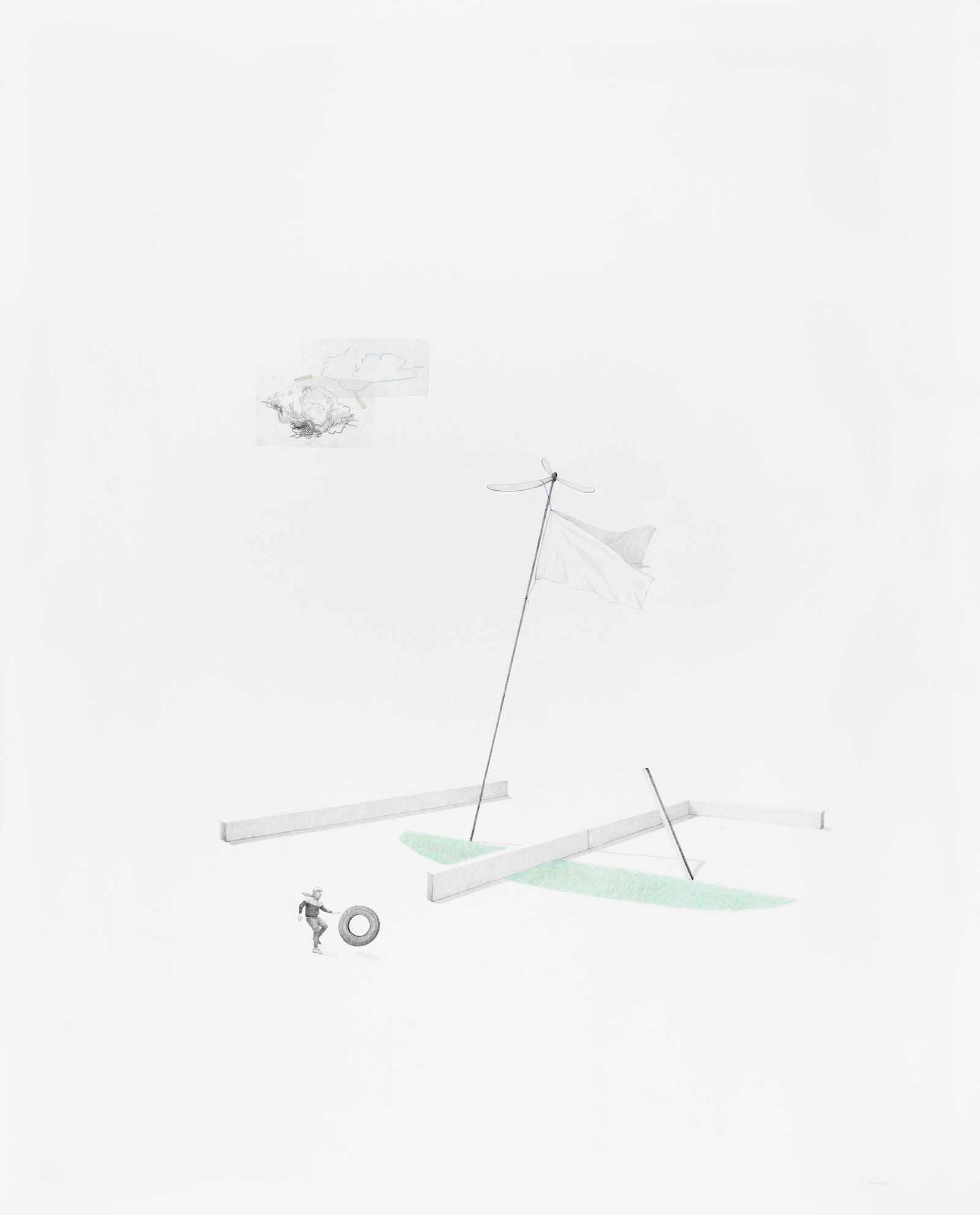
124 x 100 cm
Signed, bottom right
©Fred Froum / La Nouvelle Babylone
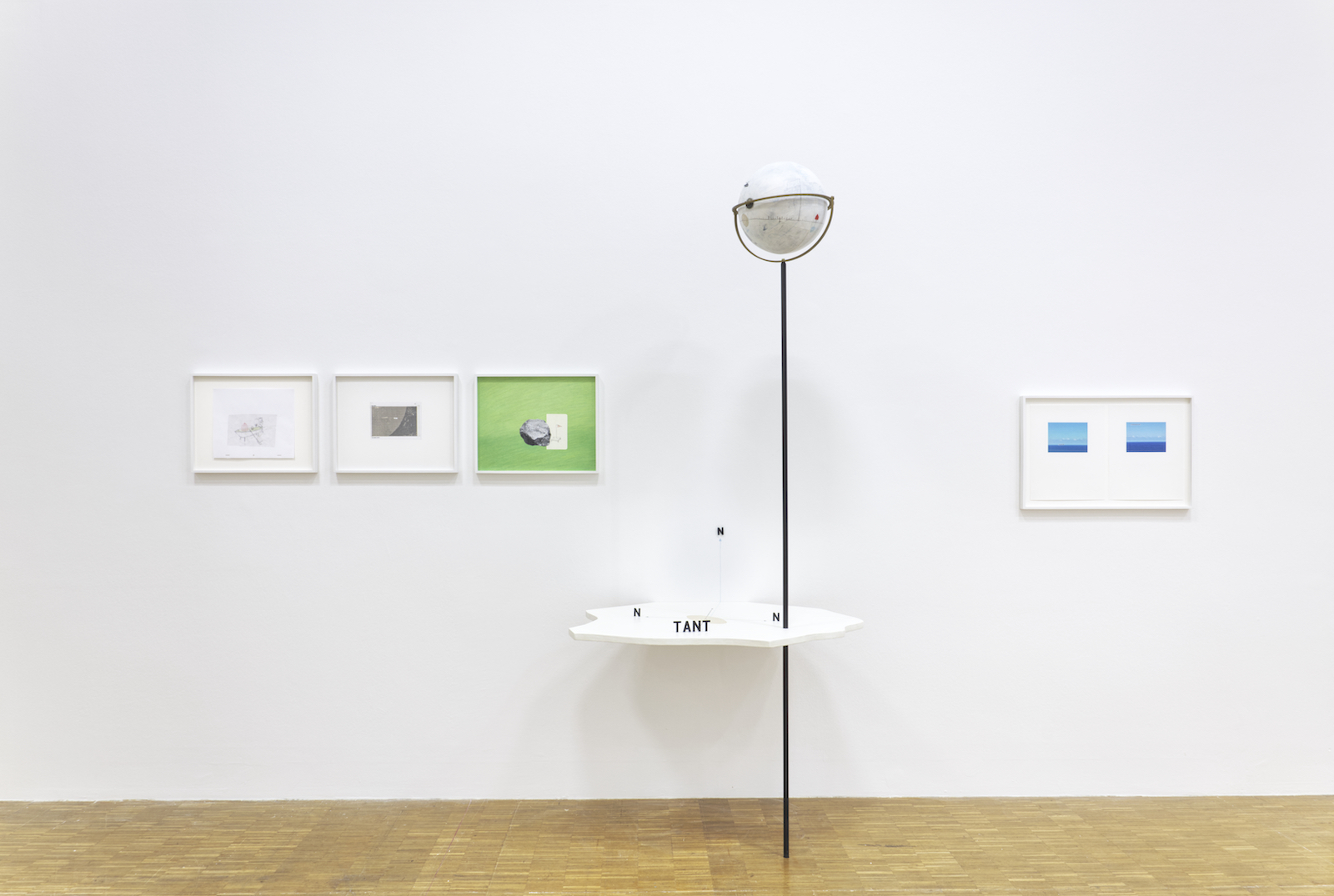
220 x 390 x 90 cm
Nicolas Brasseur
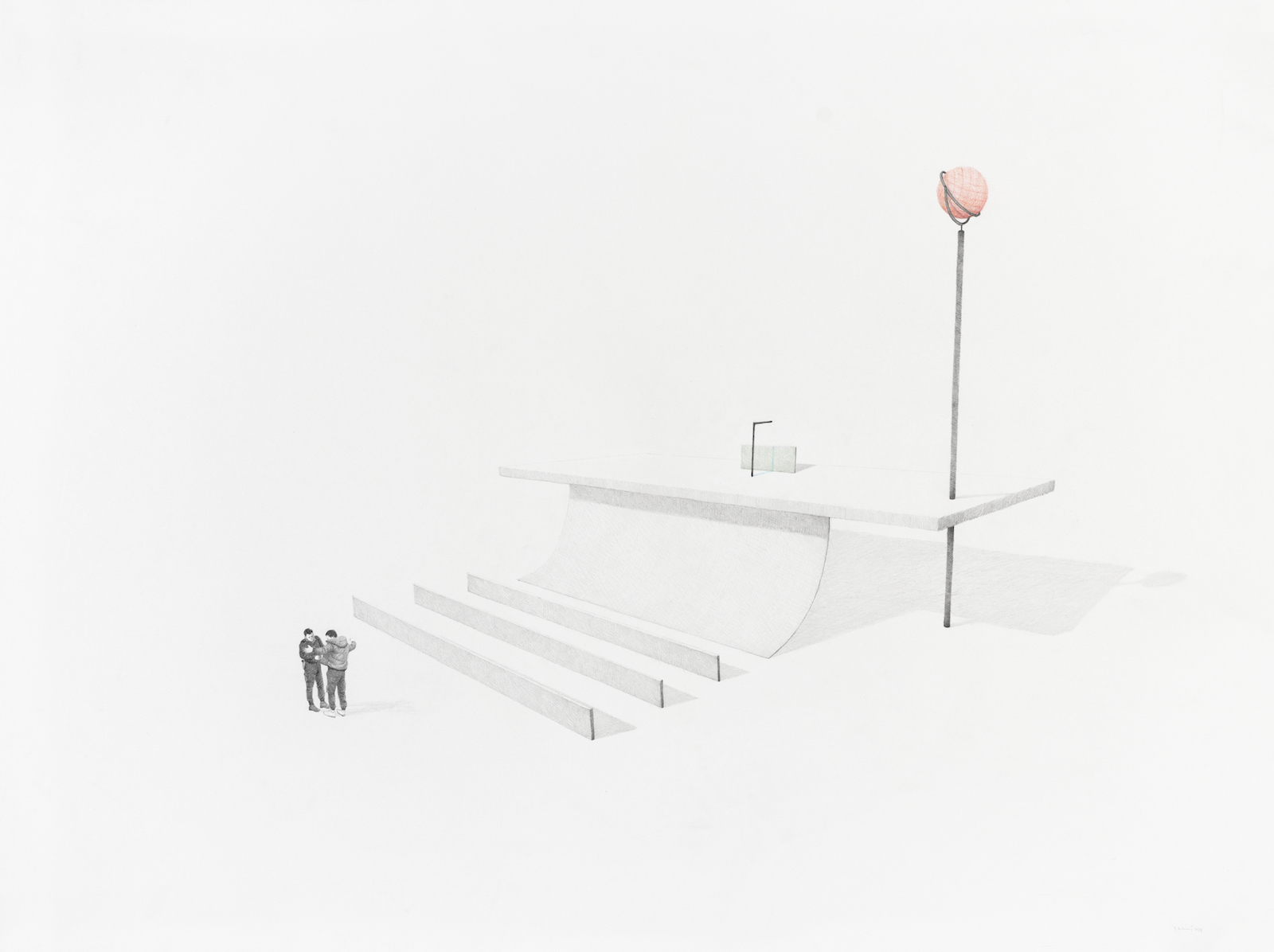
65 x 87 cm
Signed, bottom right
©Fred Froum / La Nouvelle Babylone
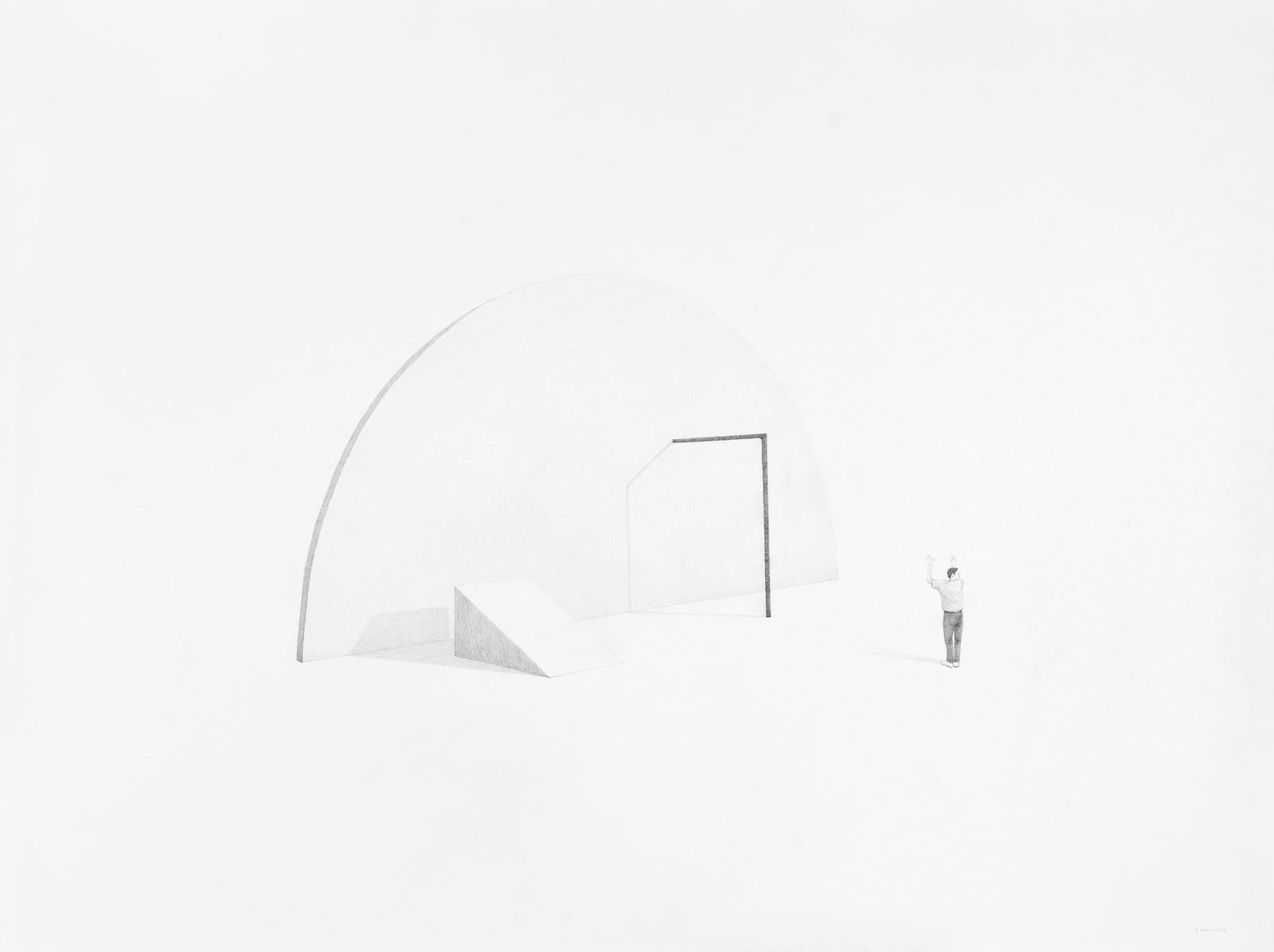
65 x 87 cm
Signed, at the bottom right
©Fred Froum / La Nouvelle Babylone
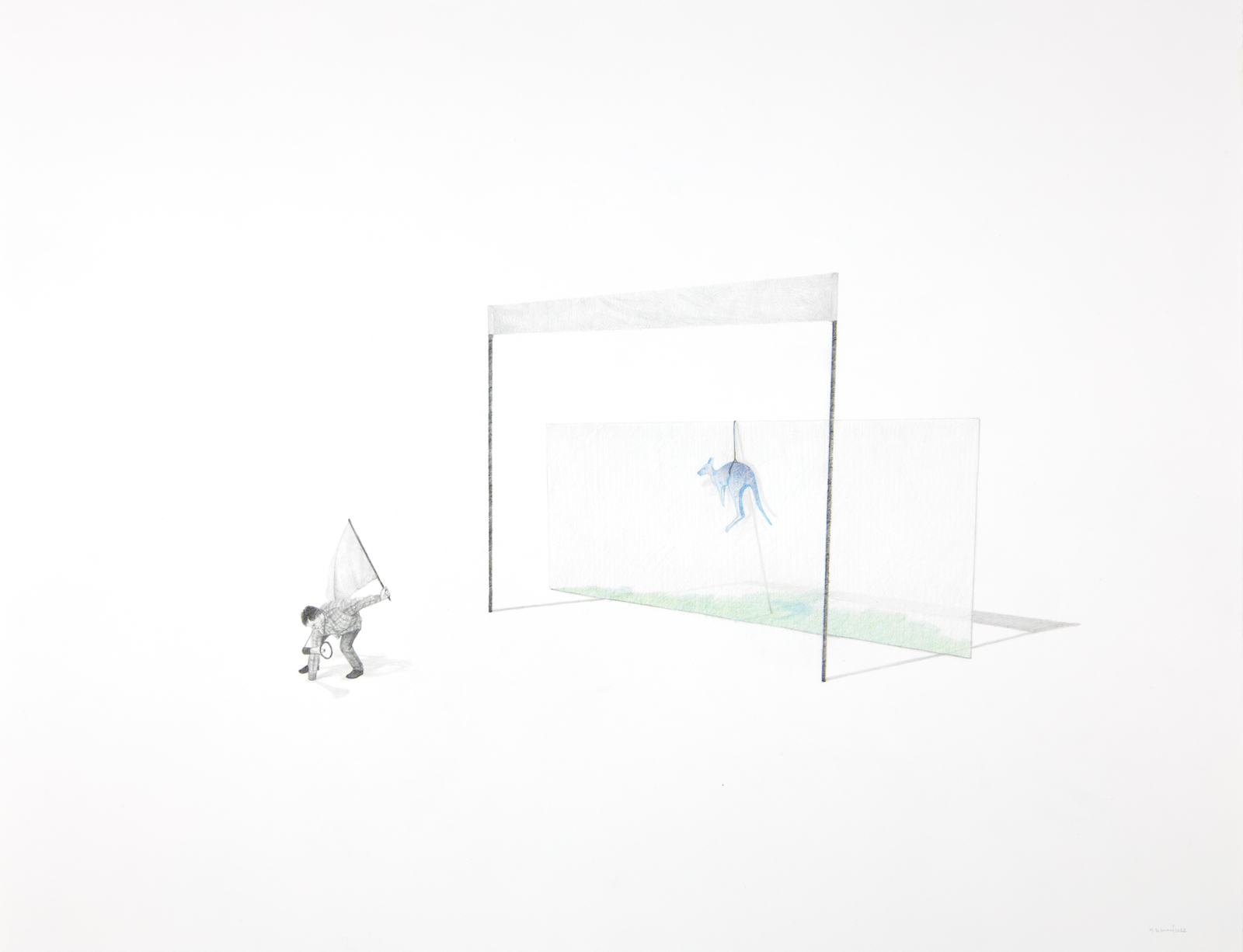
46 x 60 cm
Signed
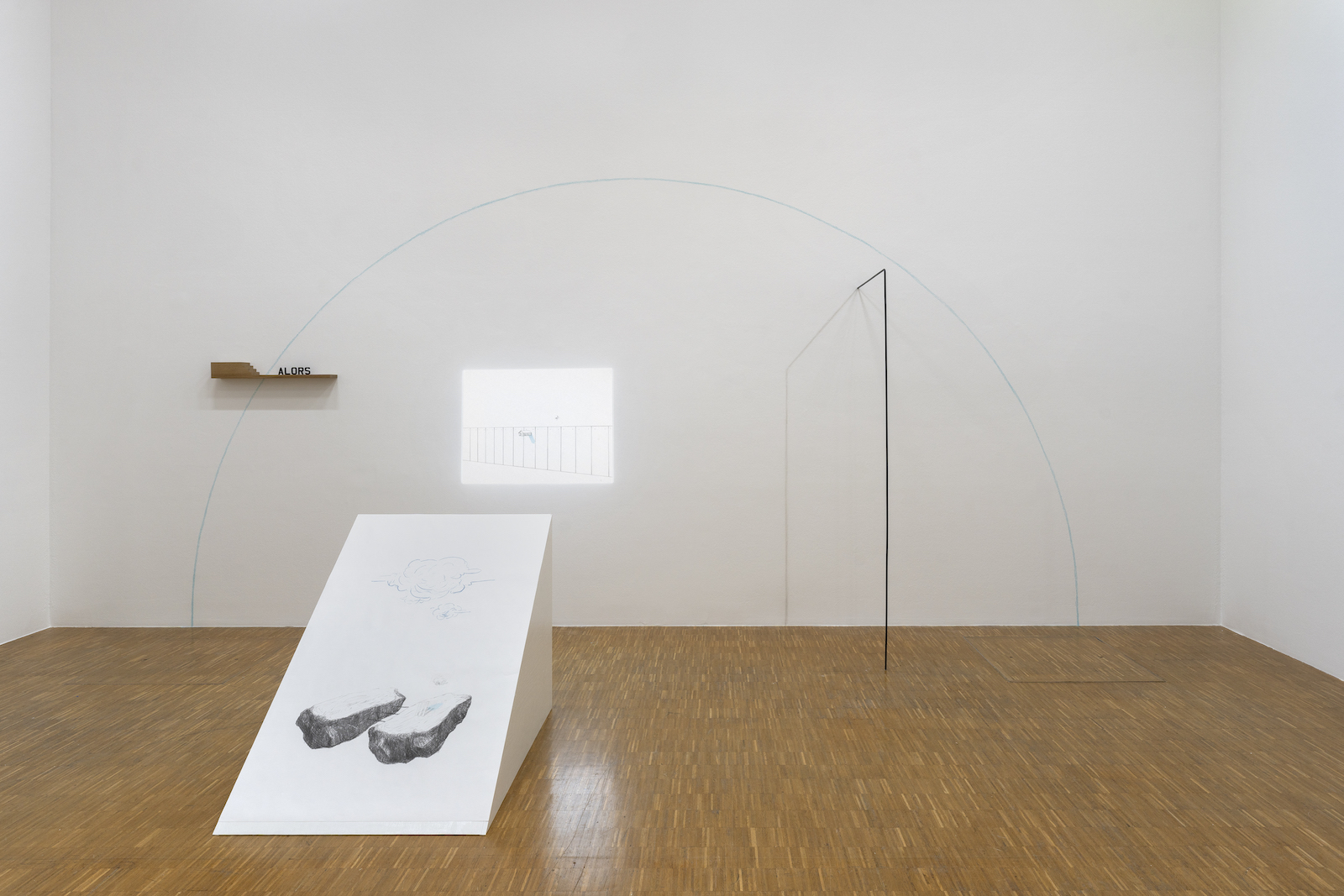
Variable dimension
©Nicolas Brasseur
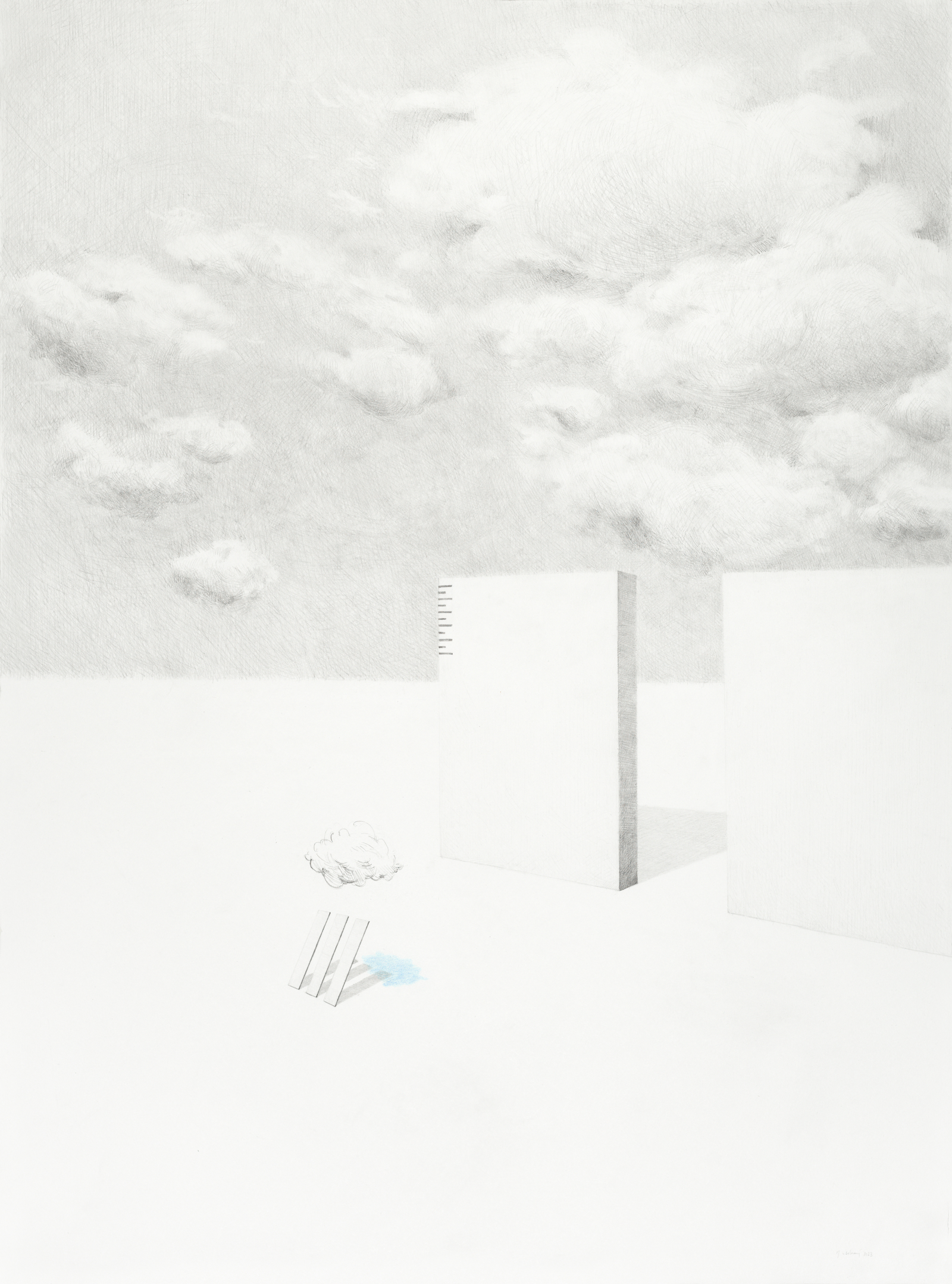
85 x 63 cm
Signed, bottom right
©Fred Froum / La Nouvelle Babylone
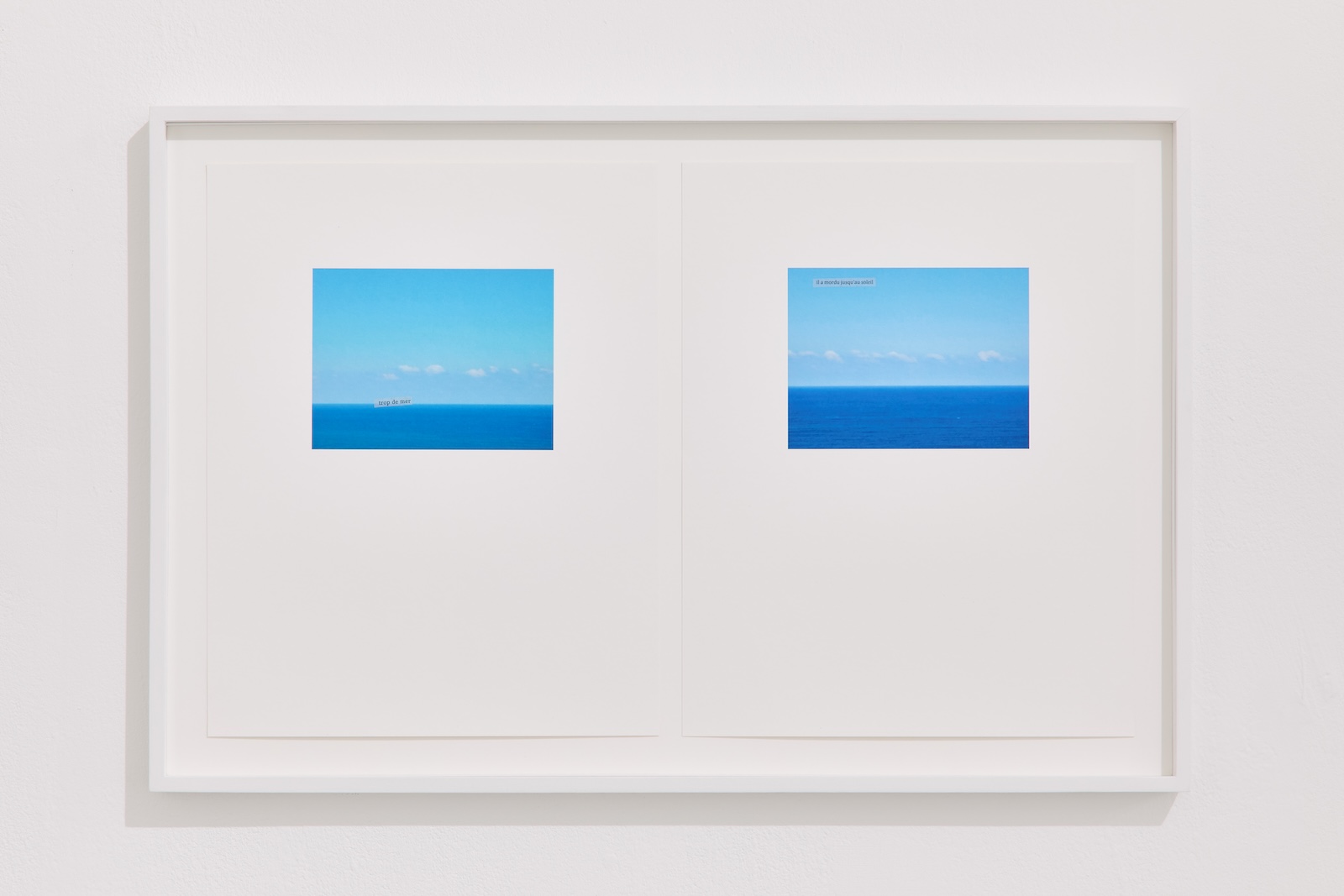
38 x 30 cm
Signed at the back, lower left corner
© jcLett
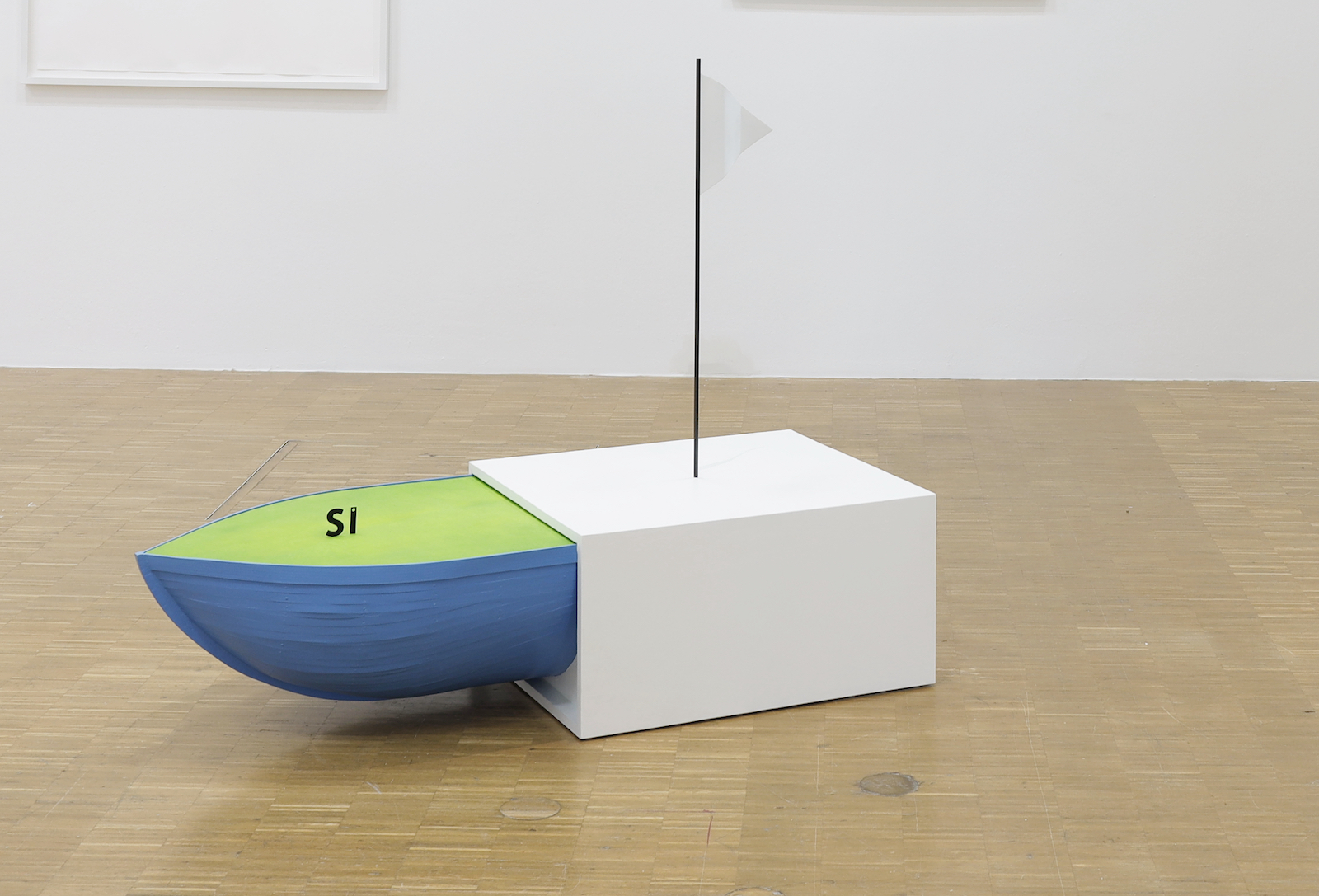
120 x 59 x 134 cm
Courtesy de l'artiste et de la Galerie Anne-Sarah Bénichou
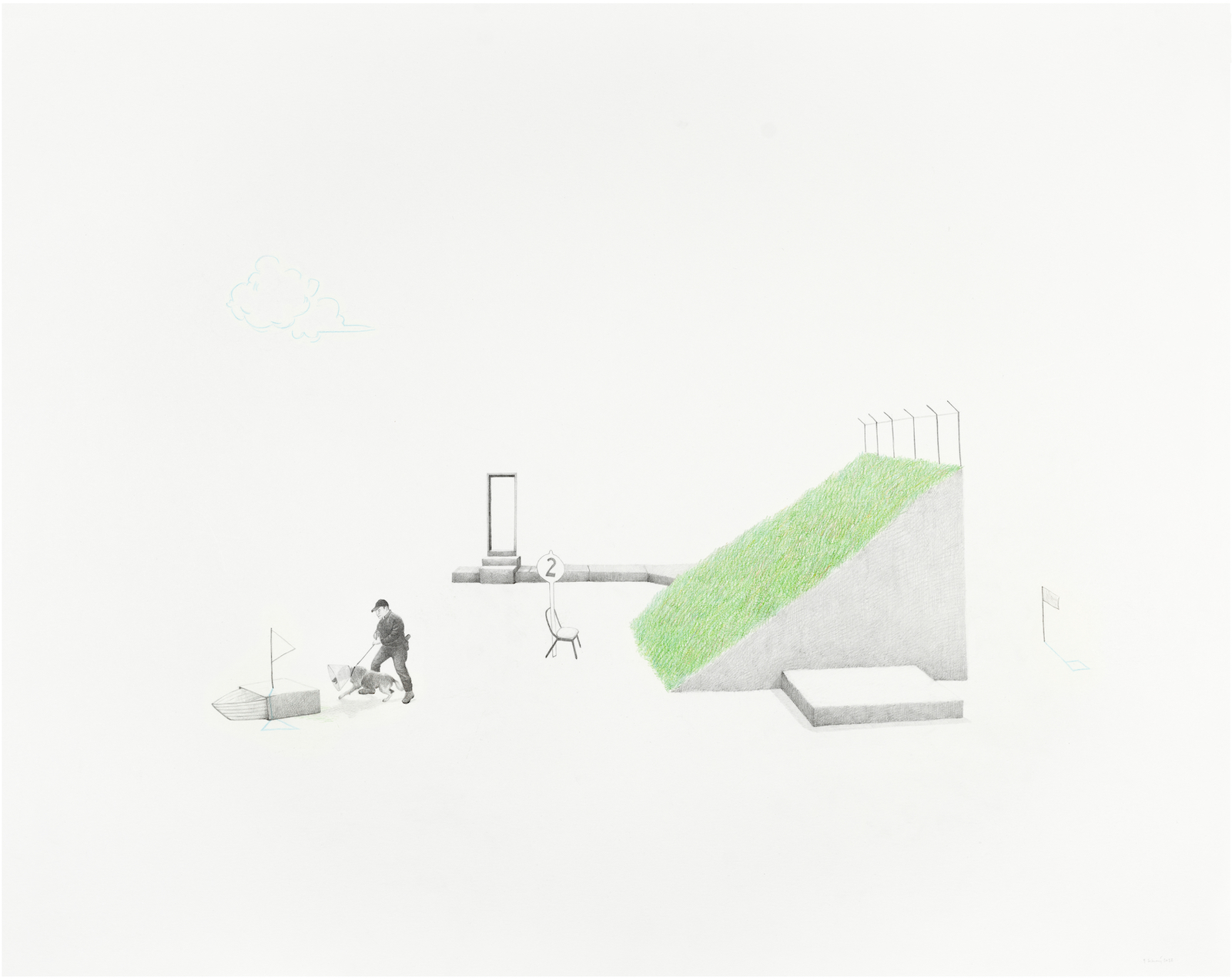
66 x 83 cm
Signed, bottom right
©Fred Froum / La Nouvelle Babylone
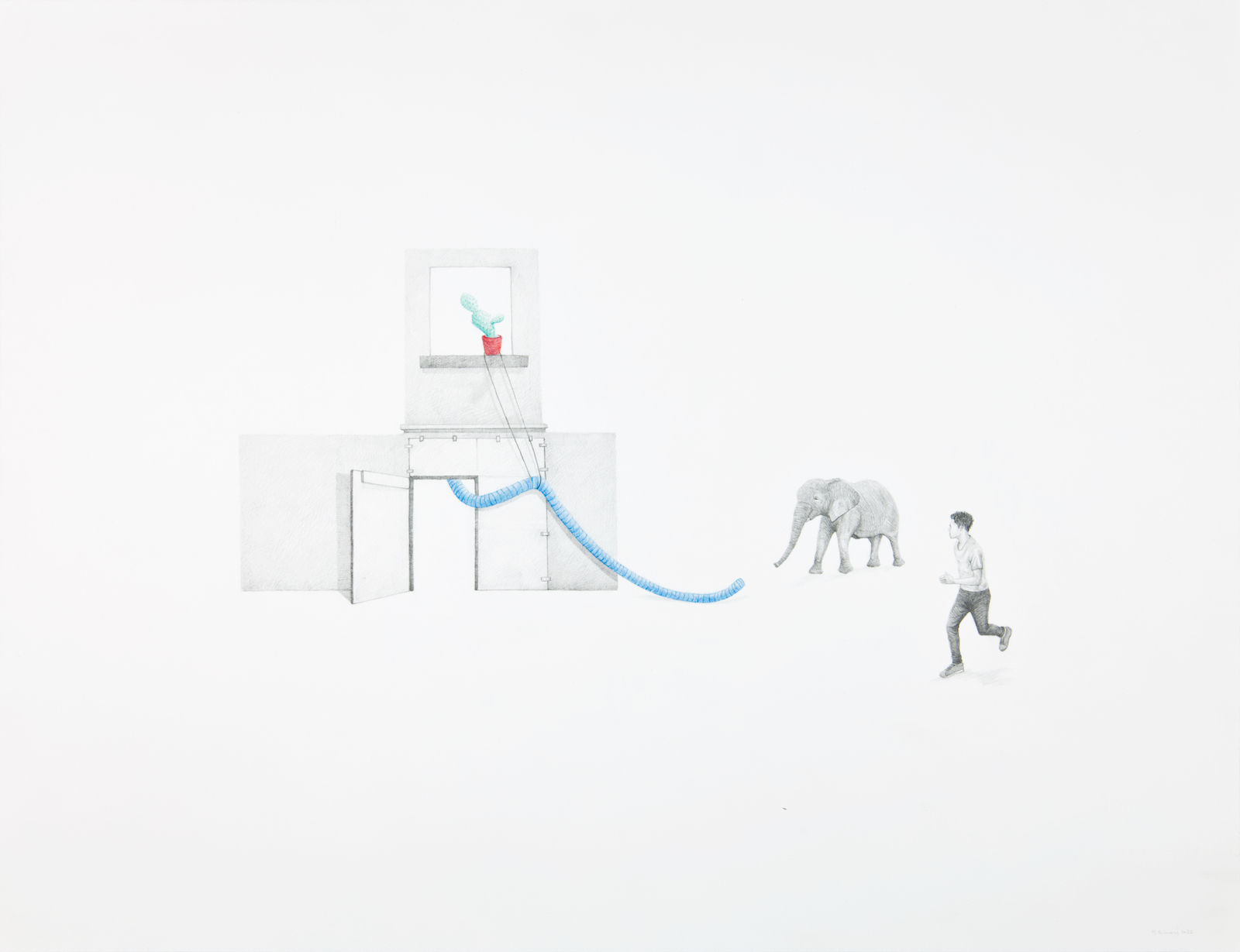
50 x 65 cm
Signed
In Amorce dans l'air léger, Massinissa Selmani assembles elements to produce strange, even absurd situations, imbued with a certain gravity; they suggest signs of a latent tragedy or the beginnings of an elusive violence to come. The resulting storytelling, deliberately constructed from postures or fragments of architecture that seem familiar, escapes the possibility of situating or dating them. The elements thus isolated from their context tend to make the situations eternal.
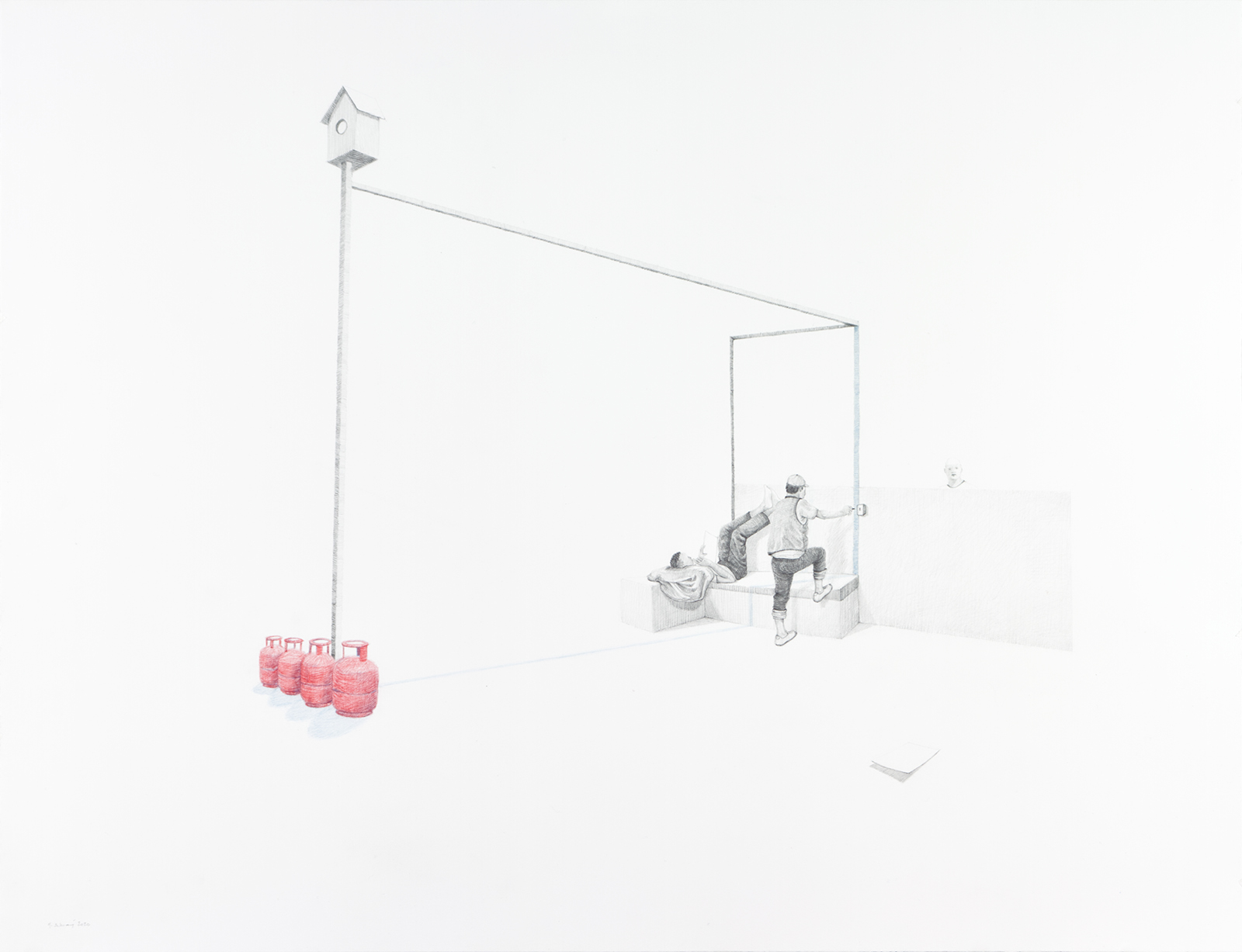
Graphite and coloured pencil on paper
50 x 65 cm
Signe at the bottom left
In Amorce dans l'air léger, Massinissa Selmani assembles elements to produce strange, even absurd situations, imbued with a certain gravity; they suggest signs of a latent tragedy or the beginnings of an elusive violence to come. The resulting storytelling, deliberately constructed from postures or fragments of architecture that seem familiar, escapes the possibility of situating or dating them. The elements thus isolated from their context tend to make the situations eternal.
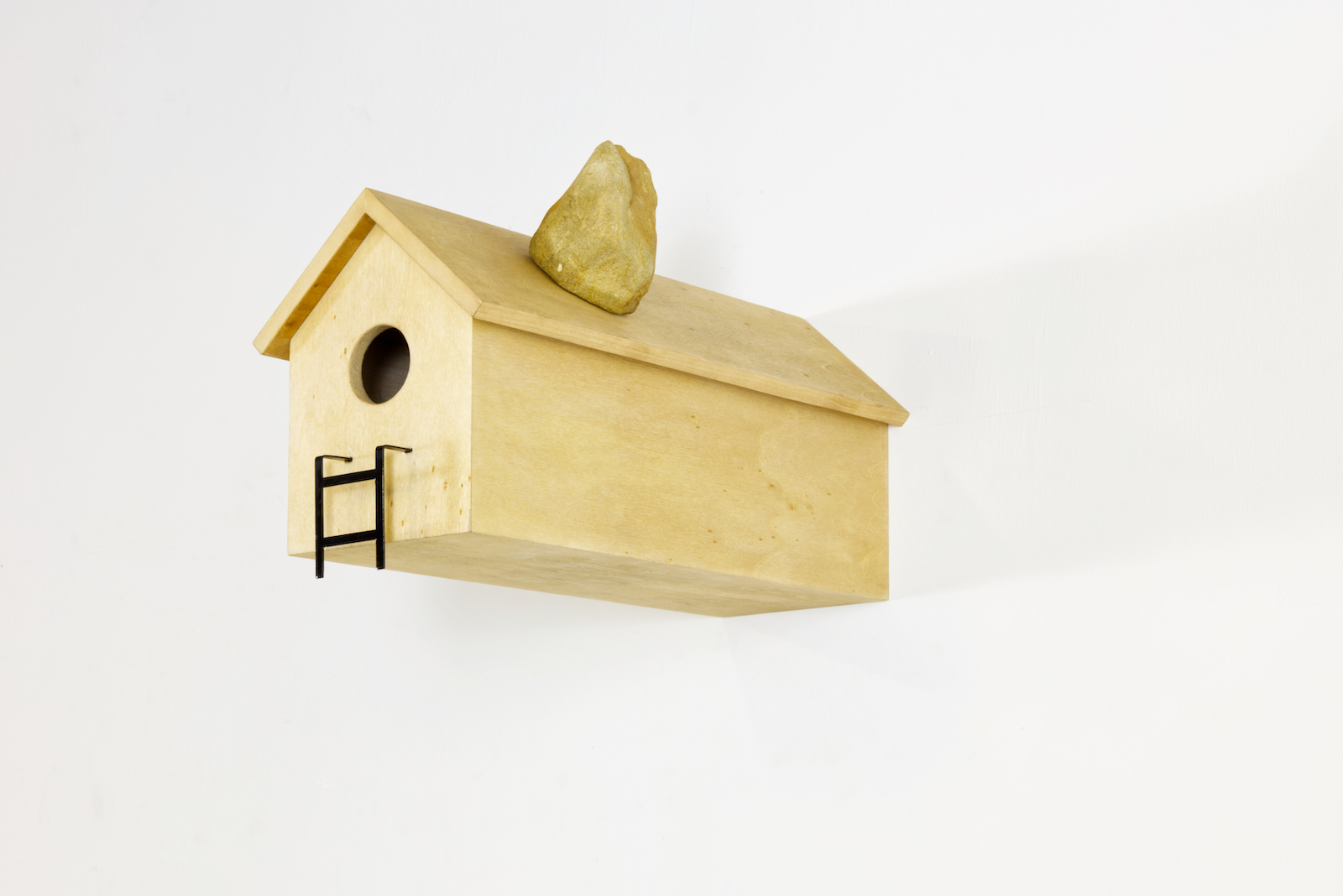
22 x 14 x 42 cm

Variable dimension (sculpture 24.5 x 25.5 x 19,5 cm - Drawing 42 x 29.7 cm)
Drawing titled at the back, left bottom
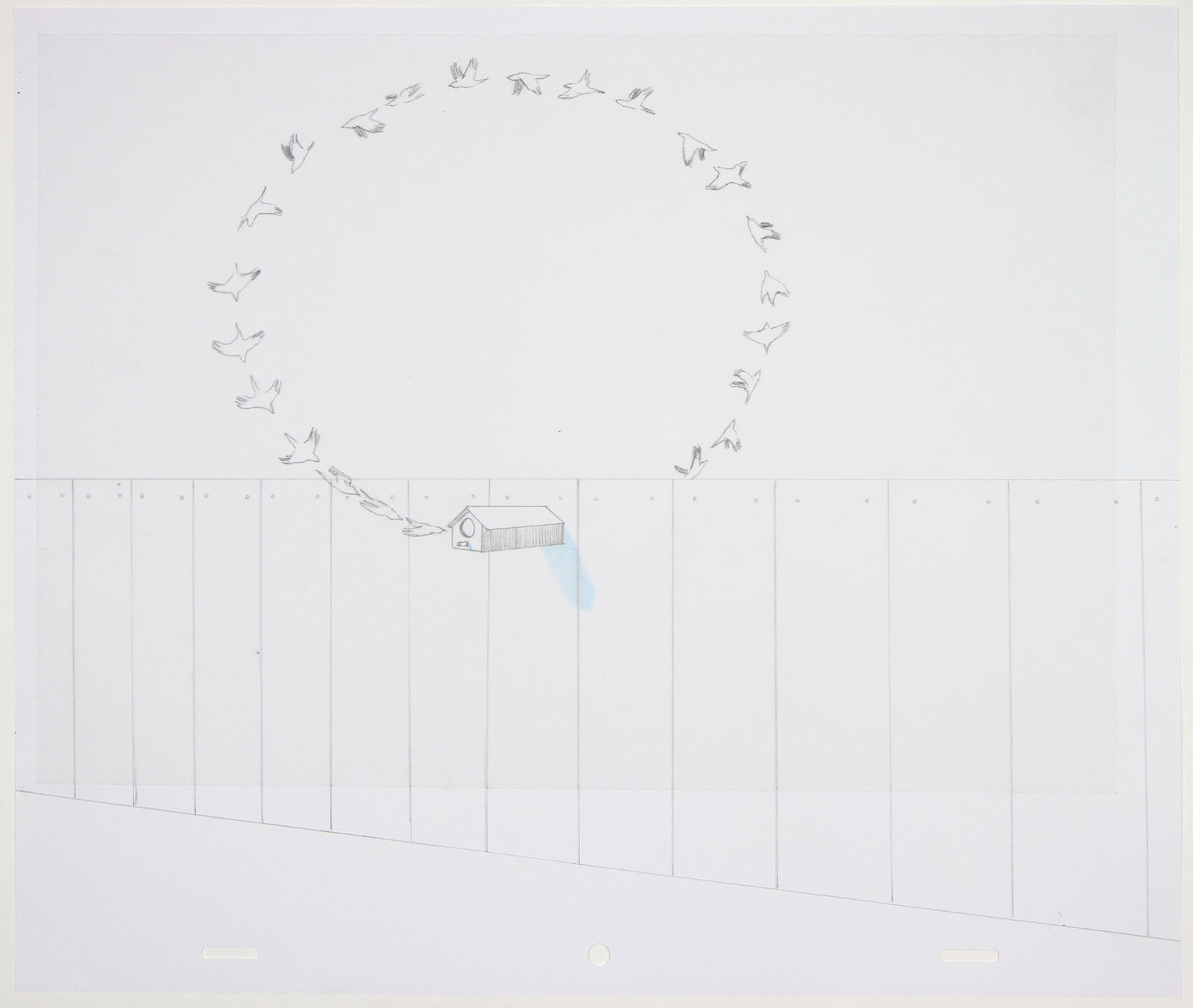
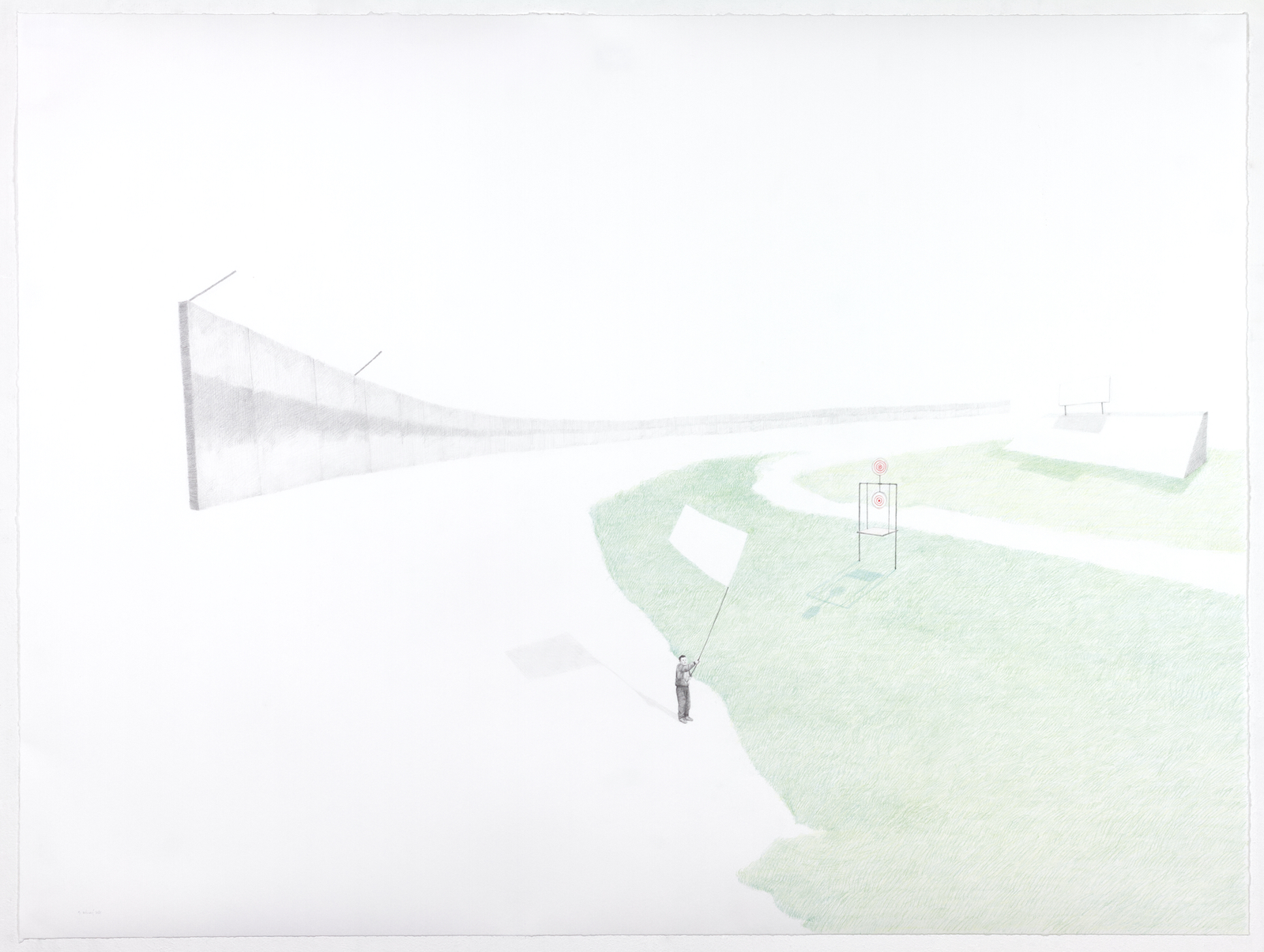
75 x 100 cm
signed at the bottom left
The series Aubes insondables represents an evolution in the work of Massinissa Selmani. Here, the artist is interested in the forms' suggestion through a play on space and values. Although his sources of inspiration deflect from the written press, these works are nevertheless in line with his reflection of designing enigmatic, floating and imaginary spaces. He conceives environments, in an "unfathomable" style as the title suggests, without beginning or end, accentuating the mystery of floating scenes and architectures.
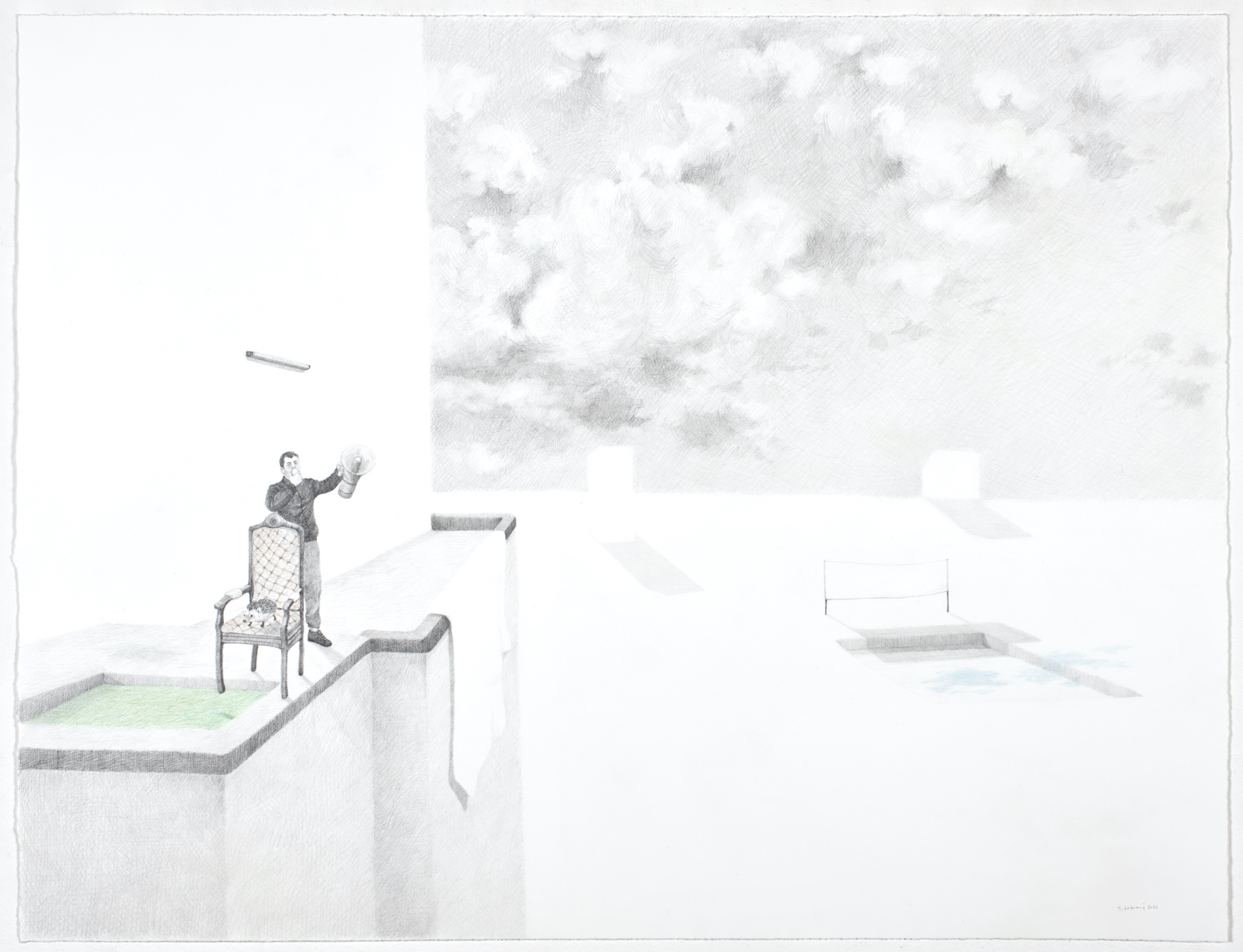
50 x 65 cm
signed at the bottom right
The series Aubes insondables represents an evolution in the work of Massinissa Selmani. Here, the artist is interested in the forms' suggestion through a play on space and values. Although his sources of inspiration deflect from the written press, these works are nevertheless in line with his reflection of designing enigmatic, floating and imaginary spaces. He conceives environments, in an "unfathomable" style as the title suggests, without beginning or end, accentuating the mystery of floating scenes and architectures.
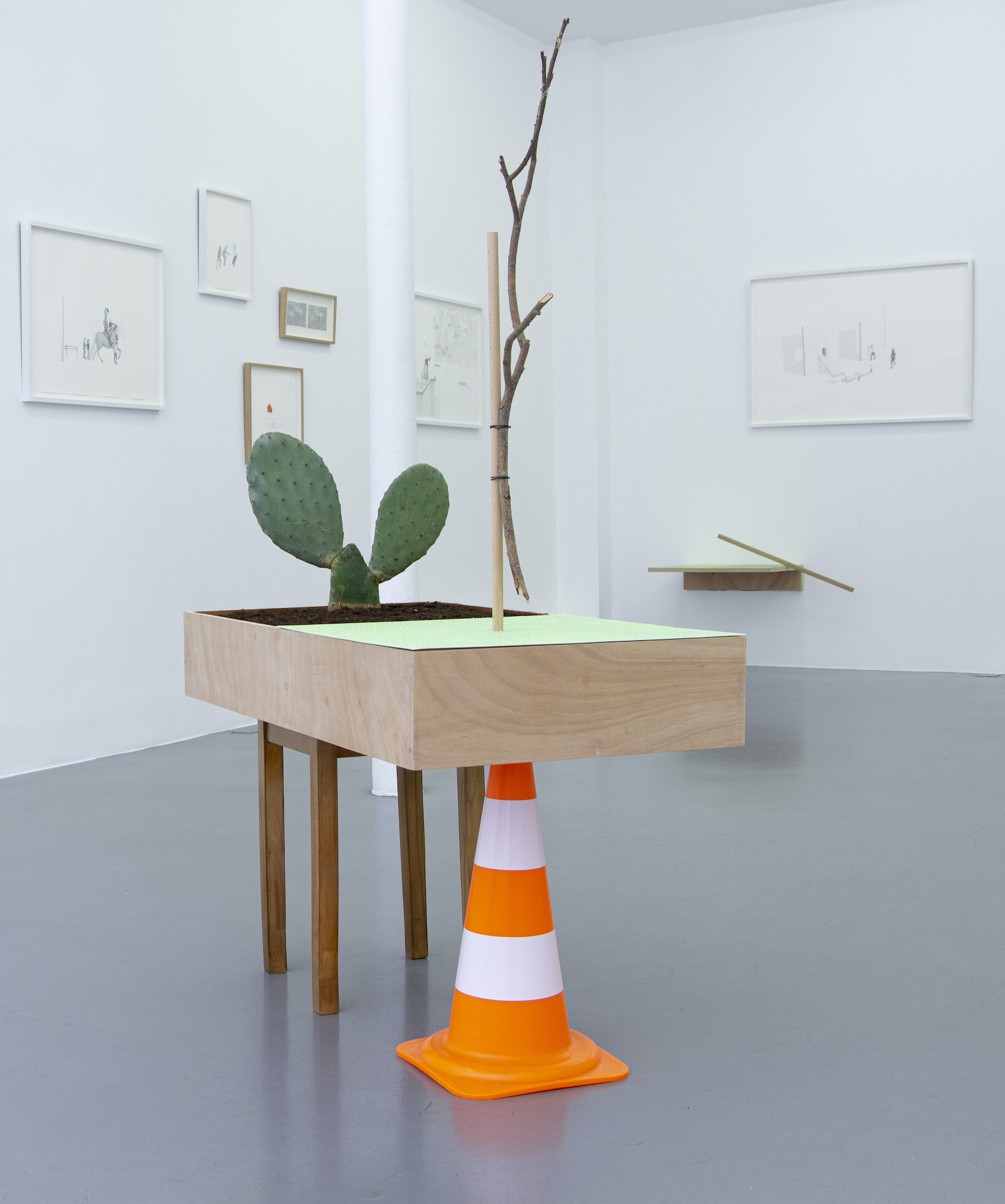
151 x 50 x 15 cm
The sculptures scattered throughout the exhibition are reuses and diversions of objects from urban signage or from everyday life (binoculars, stools, cacti). They bring a new insight to the drawings by materialising elements straight out of Massinissa Selmani's compositions. The artist conceives the landscape as a territory of conflict, at once oneiric and surreal, tragic and absurd, made up of balances and confrontations. The installations are imagined as a mirror image of the watercolours, particularly through the titles. Indeed, the titles, taken from Paul Nougé's poems, shed new light on the works while establishing a dialogue with the spirit of Jean Sénac's poetry which gives the watercolours their titles.
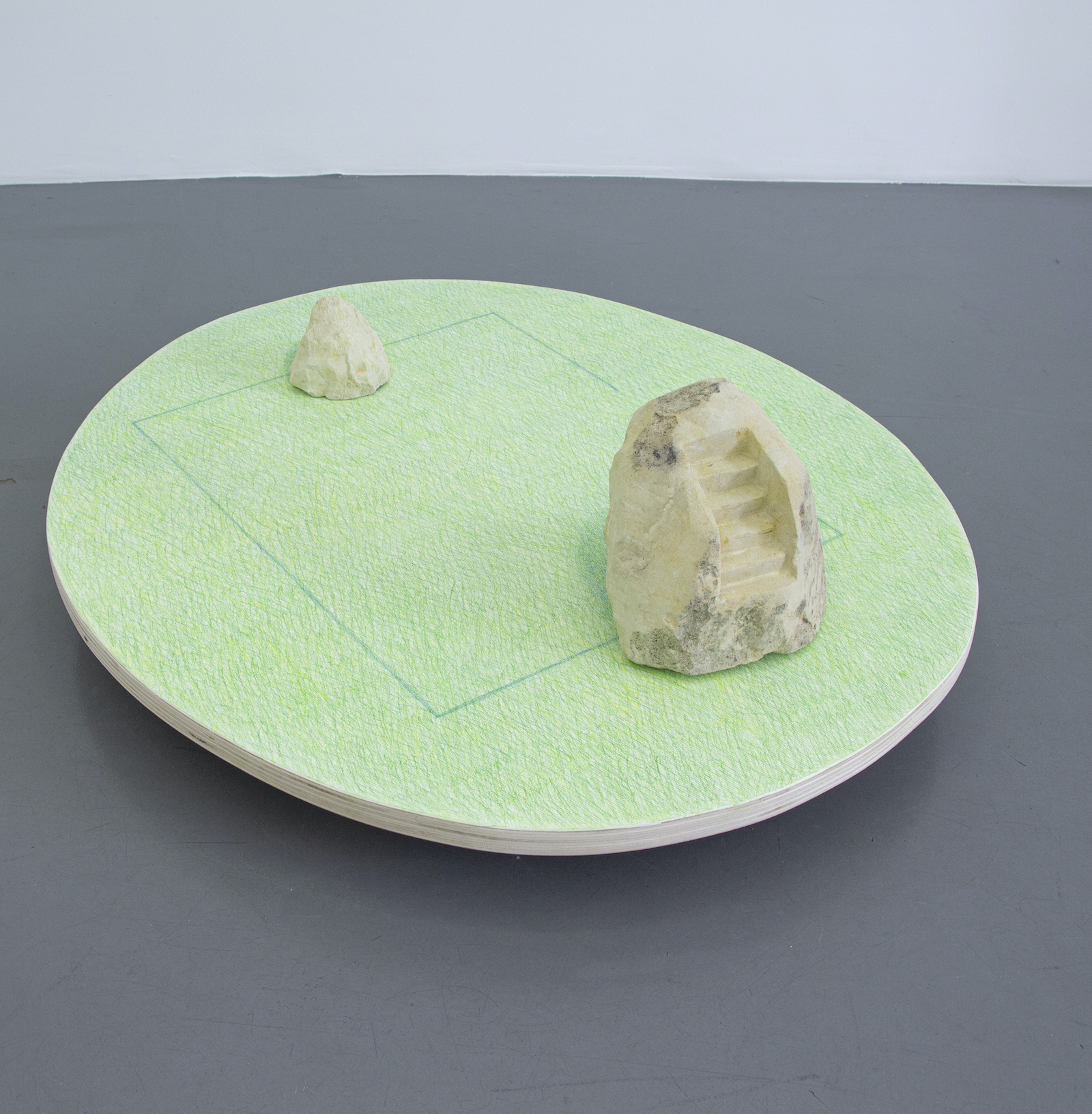
29,5 x 87 x 75,5 cm
The sculptures scattered throughout the exhibition are reuses and diversions of objects from urban signage or from everyday life (binoculars, stools, cacti). They bring a new insight to the drawings by materialising elements straight out of Massinissa Selmani's compositions. The artist conceives the landscape as a territory of conflict, at once oneiric and surreal, tragic and absurd, made up of balances and confrontations. The installations are imagined as a mirror image of the watercolours, particularly through the titles. Indeed, the titles, taken from Paul Nougé's poems, shed new light on the works while establishing a dialogue with the spirit of Jean Sénac's poetry which gives the watercolours their titles.
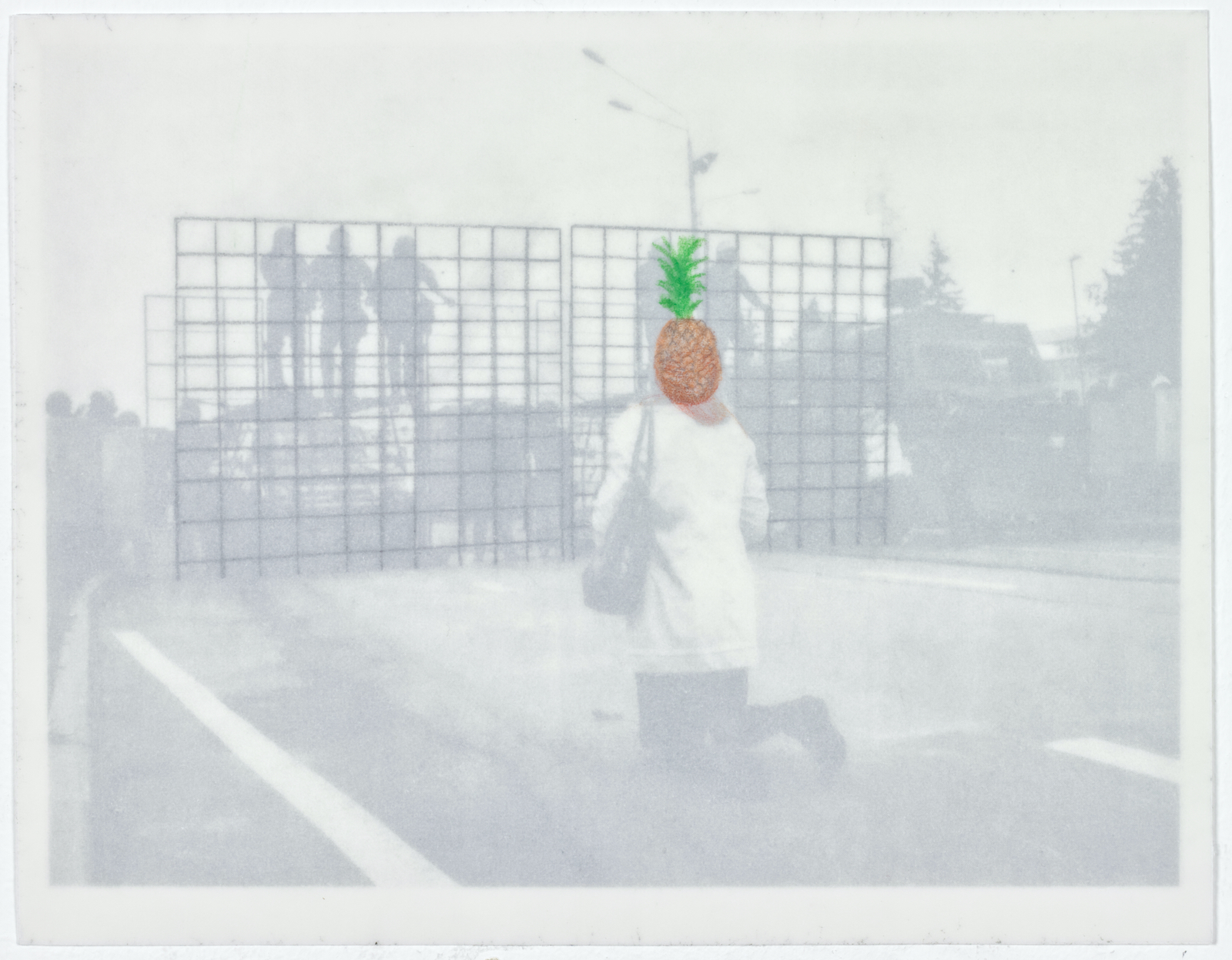
Photocopy, graphite and colour pencils on tracing paper
15,5 x 19,8 cm
Signed on bottom left of the back
Altérables is a long-term project that consists of creating a series of images with the same process: images recovered from newspapers are photocopied and then retouched by using one or more layers of transparent tracing paper. On each layer, a drawing comes duplicate, move or add an element or a contour of the original image. The transformed image is thus 'altered' and put into a different context, opening up the field of interpretation and diverting the original meaning of the source-image.
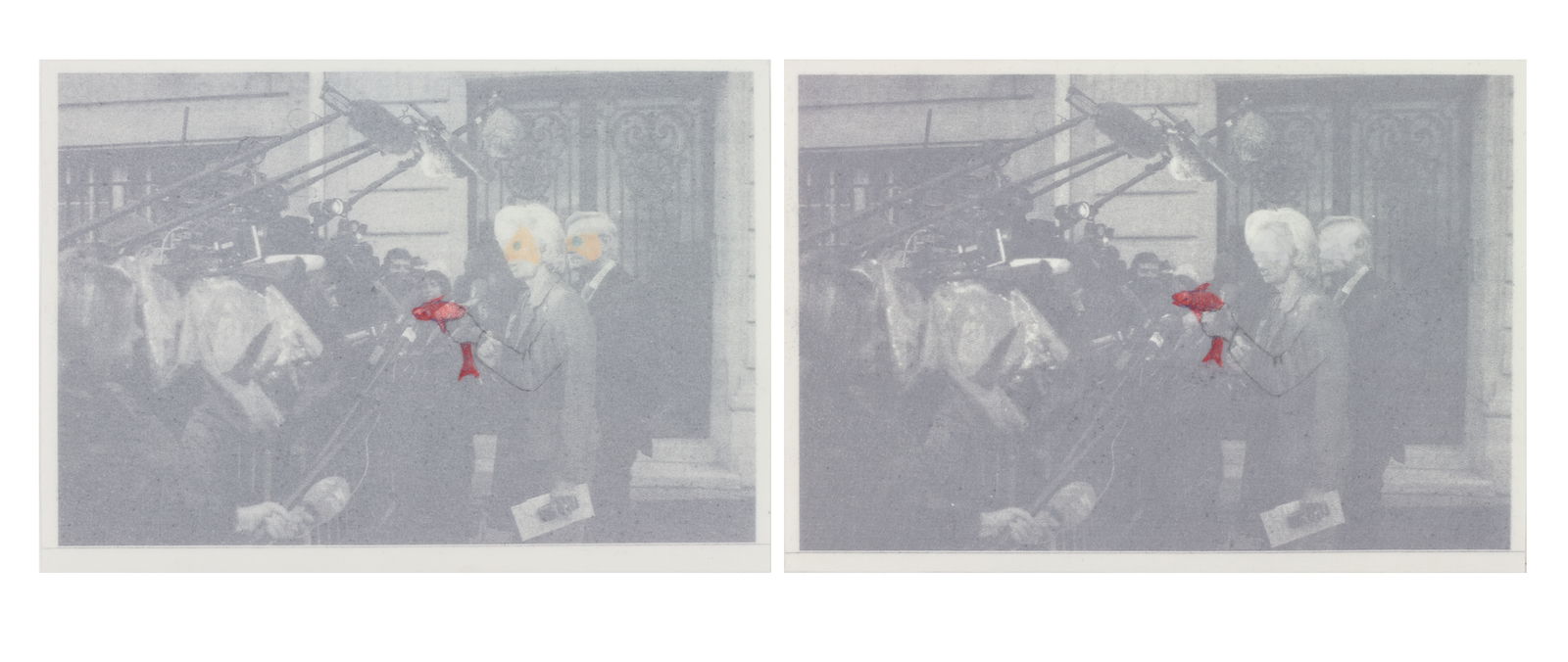
Photocopy, graphite and colour pencils on tracing paper, adhesive - diptych
10,3 x 14,7 cm (each)
Signed on bottom left of the back
Altérables is a long-term project that consists of creating a series of images with the same process: images recovered from newspapers are photocopied and then retouched by using one or more layers of transparent tracing paper. On each layer, a drawing comes duplicate, move or add an element or a contour of the original image. The transformed image is thus 'altered' and put into a different context, opening up the field of interpretation and diverting the original meaning of the source-image.
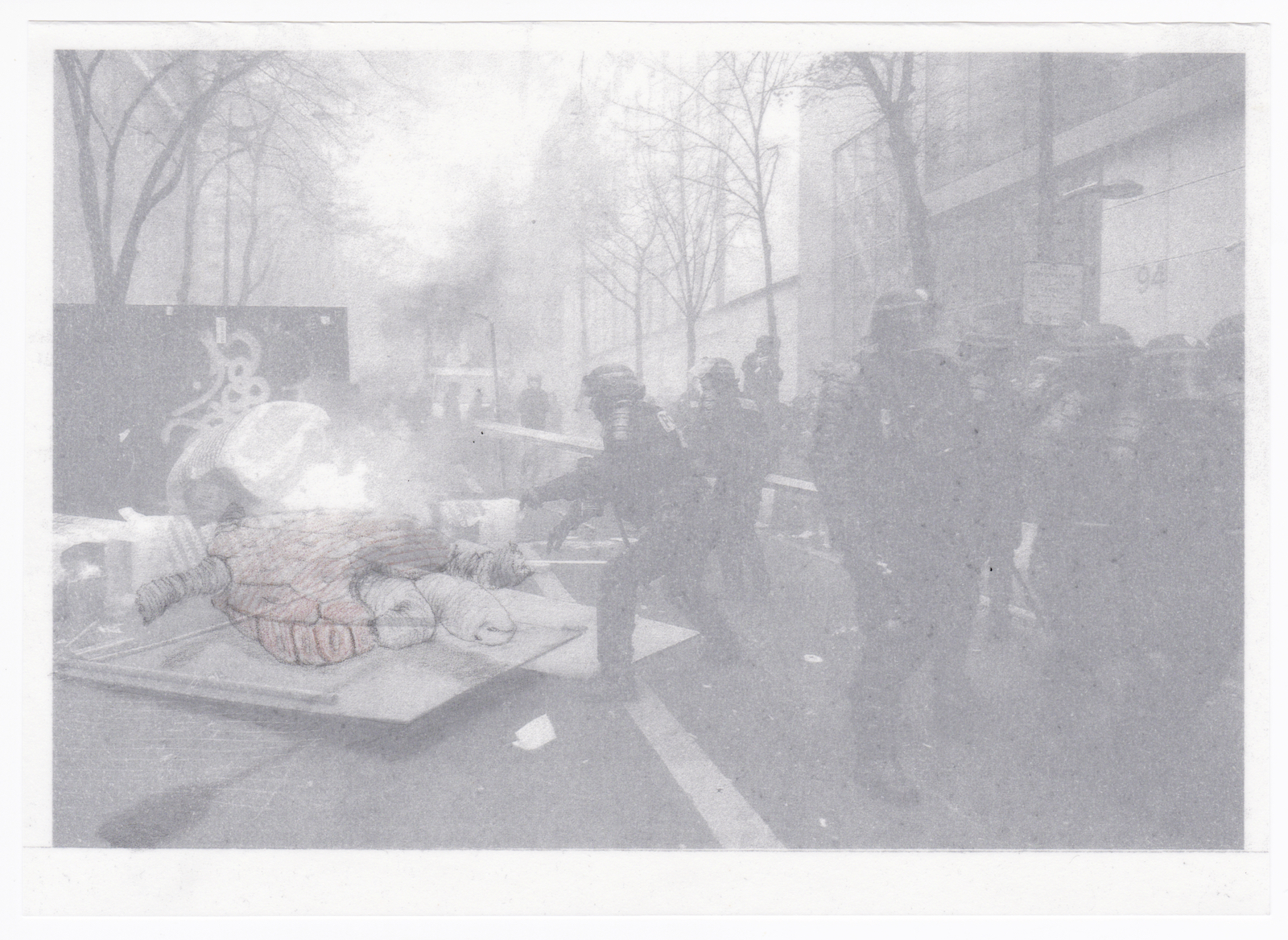
Photocopy, graphite and colour pencils on tracing paper
13,6 x 18,9 cm
Signed at the back
Altérables is a long-term project that consists of creating a series of images with the same process: images recovered from newspapers are photocopied and then retouched by using one or more layers of transparent tracing paper. On each layer, a drawing comes duplicate, move or add an element or a contour of the original image. The transformed image is thus 'altered' and put into a different context, opening up the field of interpretation and diverting the original meaning of the source-image.
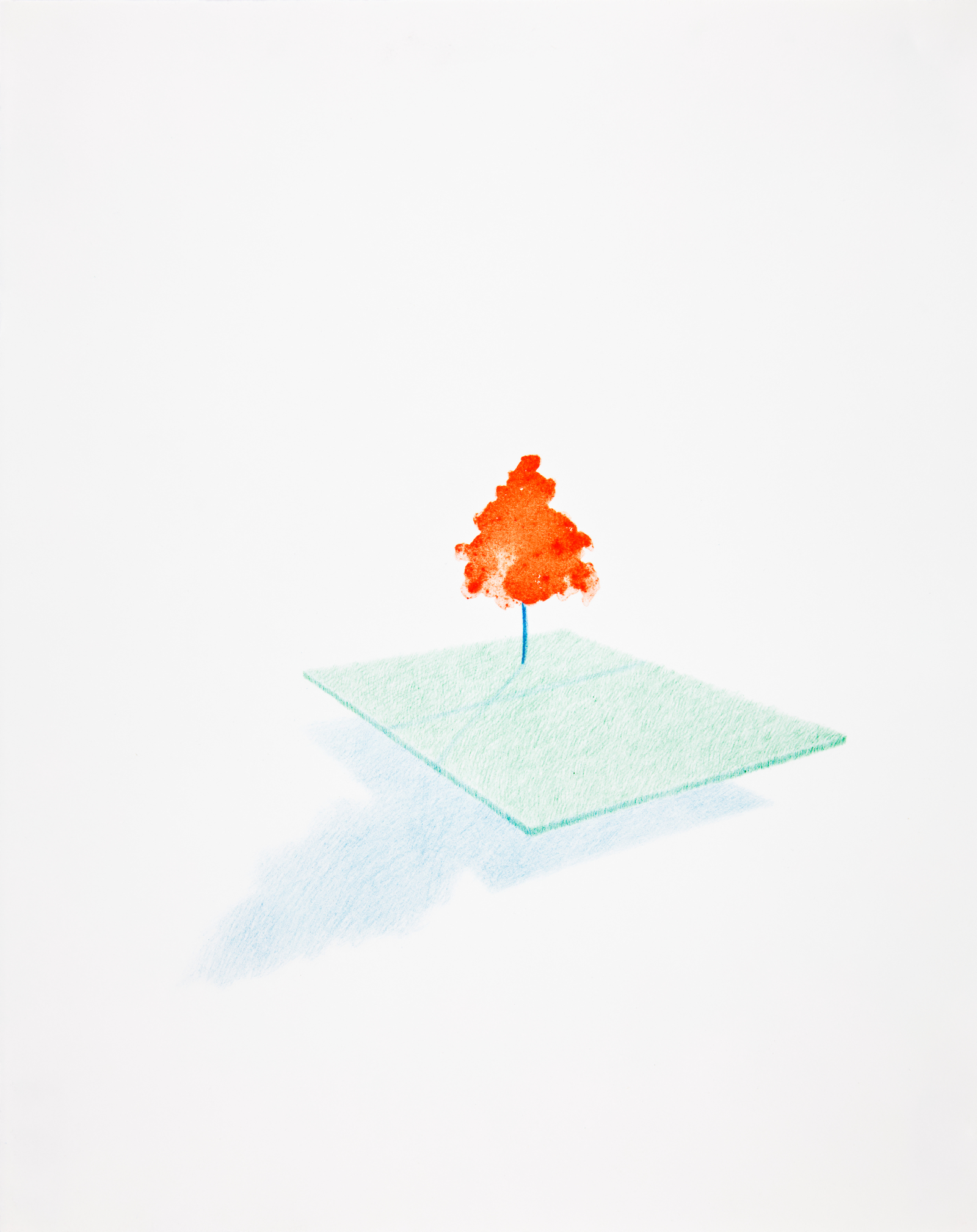
50 x 40 cm
Signed

76 x 56 cm
Signed
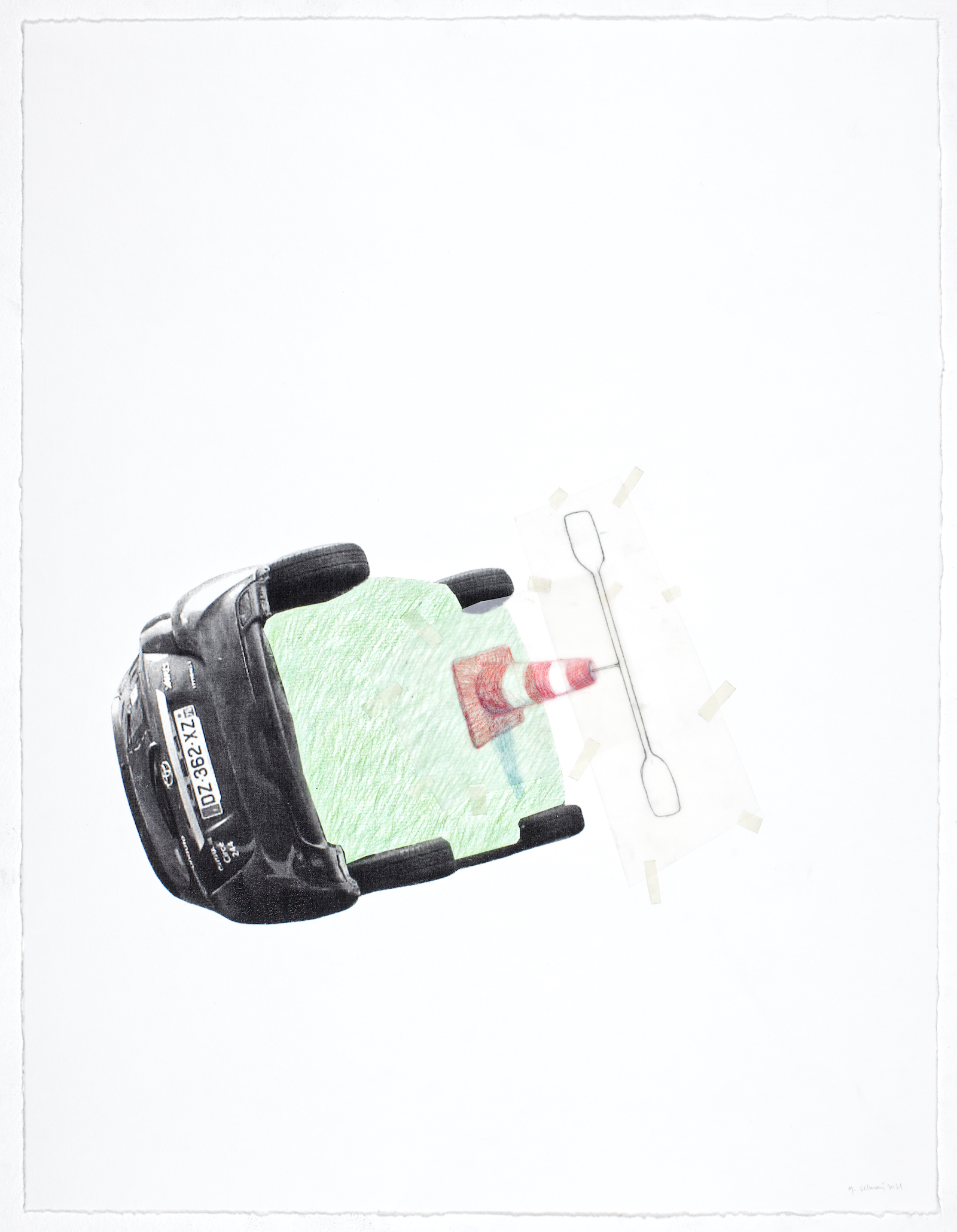
Coloured pencil on photocopy, Graphite and coloured pencils on tracing paper, adhesive
50 x 38,5 cm
signed at the bottom right
The series Après l'ordinaire (After the Ordinary) is rooted in the media imaginary of the political demonstrations and riots that have made the news in recent months. From the carcasses of burnt or overturned ordinary and police's cars that he takes from the press and photocopies, Massinissa Selmani reinterprets the ruins of violence by associating them with incongruous elements (hunting trophies, rocks, etc.). The latter seem to create a balance with this violence that they defuse, thus forming territories of conflict tinged with a mystical, even disturbing banality. Moreover, through the intrusion of formal geometric elements and the multiplication of points of view in the five variations of Après l'ordinaire, the artist pursues his reflection on altered images and the documentation of events through drawing.
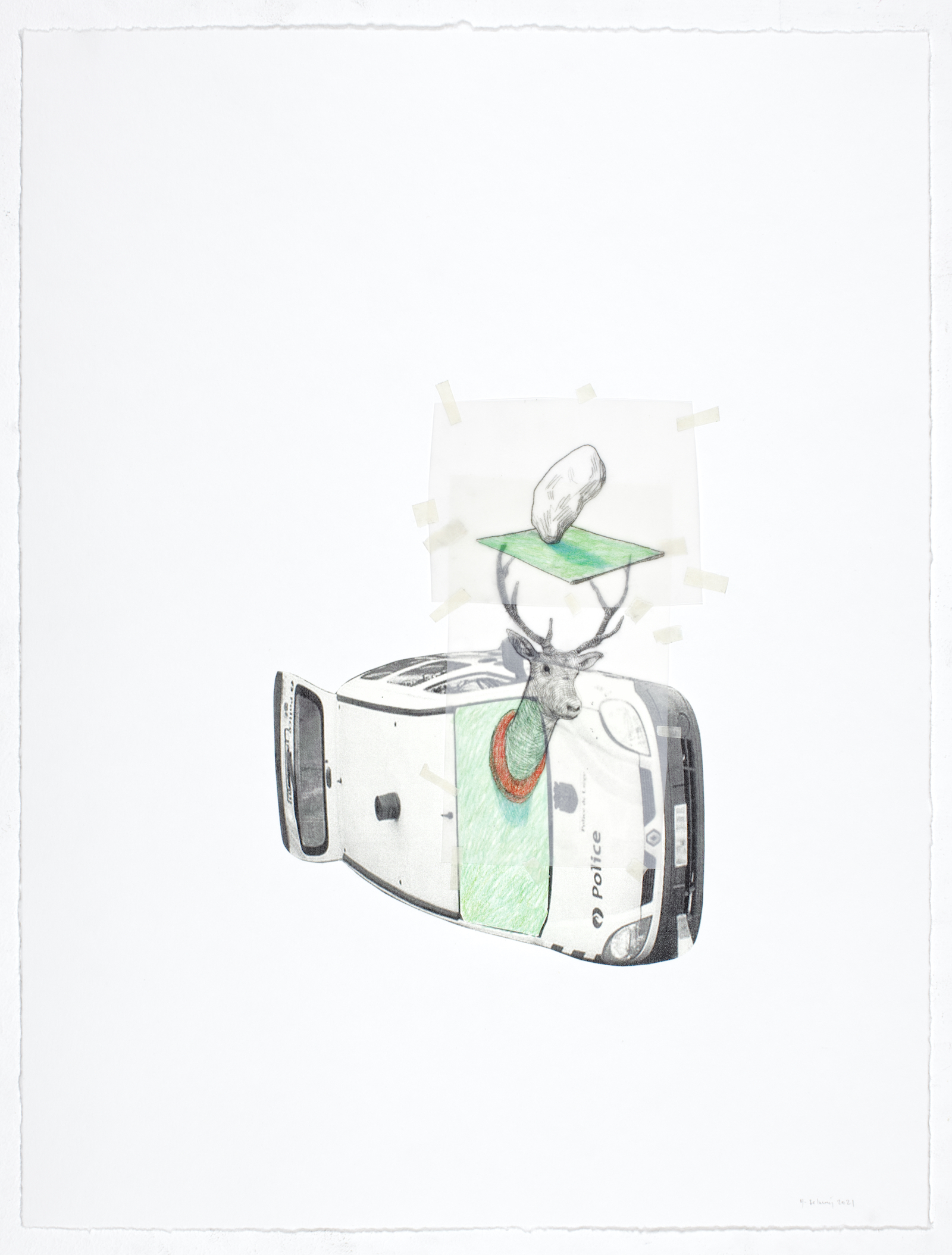
Coloured pencil on photocopy, Graphite and coloured pencils on tracing paper, adhesive
50 x 38,5 cm
signed at the bottom right
The series Après l'ordinaire (After the Ordinary) is rooted in the media imaginary of the political demonstrations and riots that have made the news in recent months. From the carcasses of burnt or overturned ordinary and police's cars that he takes from the press and photocopies, Massinissa Selmani reinterprets the ruins of violence by associating them with incongruous elements (hunting trophies, turtles, wheels, rocks, etc.). The latter seem to create a balance with this violence that they defuse, thus forming territories of conflict tinged with a mystical, even disturbing banality. Moreover, through the intrusion of formal geometric elements and the multiplication of points of view in the five variations of Après l'ordinaire, the artist pursues his reflection on altered images and the documentation of events through drawing.
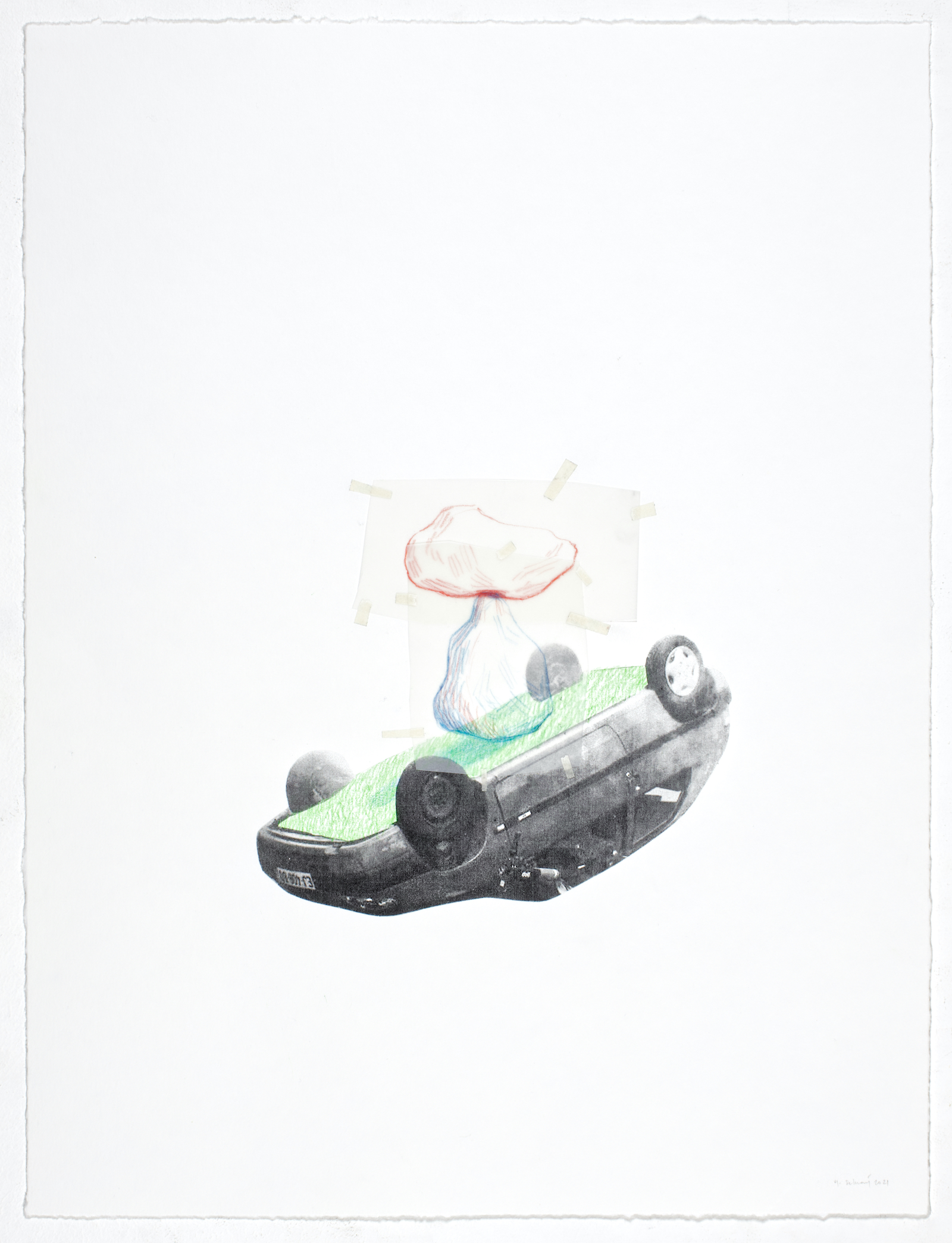
Coloured pencil on photocopy, Graphite and coloured pencils on tracing paper, adhesive
50 x 38,5 cm
signed at the bottom right
The series Après l'ordinaire (After the Ordinary) is rooted in the media imaginary of the political demonstrations and riots that have made the news in recent months. From the carcasses of burnt or overturned ordinary and police's cars that he takes from the press and photocopies, Massinissa Selmani reinterprets the ruins of violence by associating them with incongruous elements (hunting trophies, turtles, wheels, rocks, etc.). The latter seem to create a balance with this violence that they defuse, thus forming territories of conflict tinged with a mystical, even disturbing banality. Moreover, through the intrusion of formal geometric elements and the multiplication of points of view in the five variations of Après l'ordinaire, the artist pursues his reflection on altered images and the documentation of events through drawing.
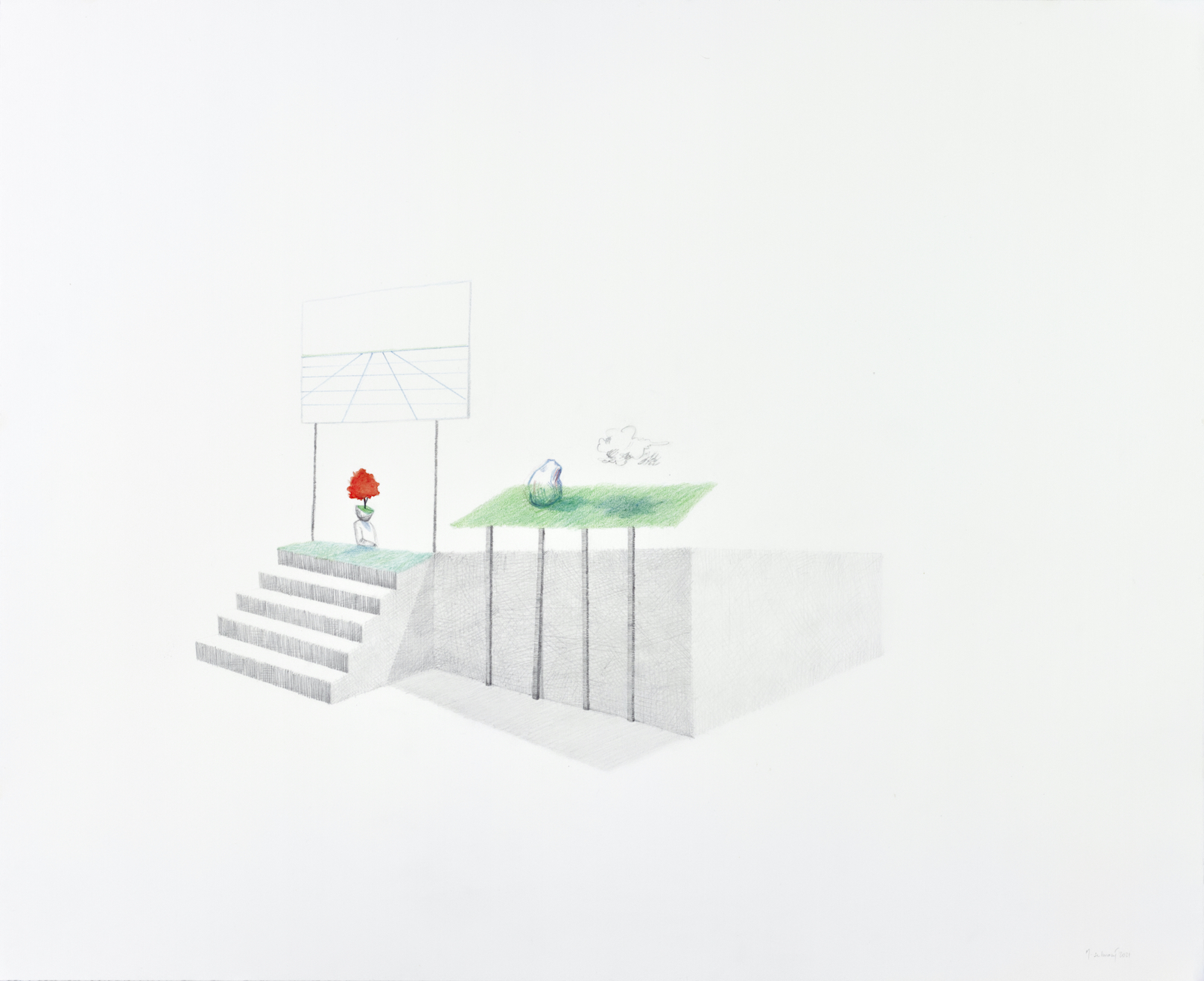
45 x 55 cm
signed and dated at the bottom right
Massinissa Selmani propose un dessin regroupant différentes situations absurdes ou impossibles. Les éléments sont assemblés sans cohérence logique, comme si la scène, de par son étrangeté, tentait de dire l'insondable. Cette oeuvre témoigne de l'évolution du travail de Massinissa Selmani, en s'éloignant de ses sources d'inspiration issues de la presse et se laissant voguer au gré de son imagination. L'utilisation de l'aquarelle marque aussi une transformation de la pratique de l'artiste. L'allusion au chiffre 5 y est présente un peu partout en filigrane comme une métaphysique de la forme : 5 marches, 5 lignes, 5 barreaux, etc.
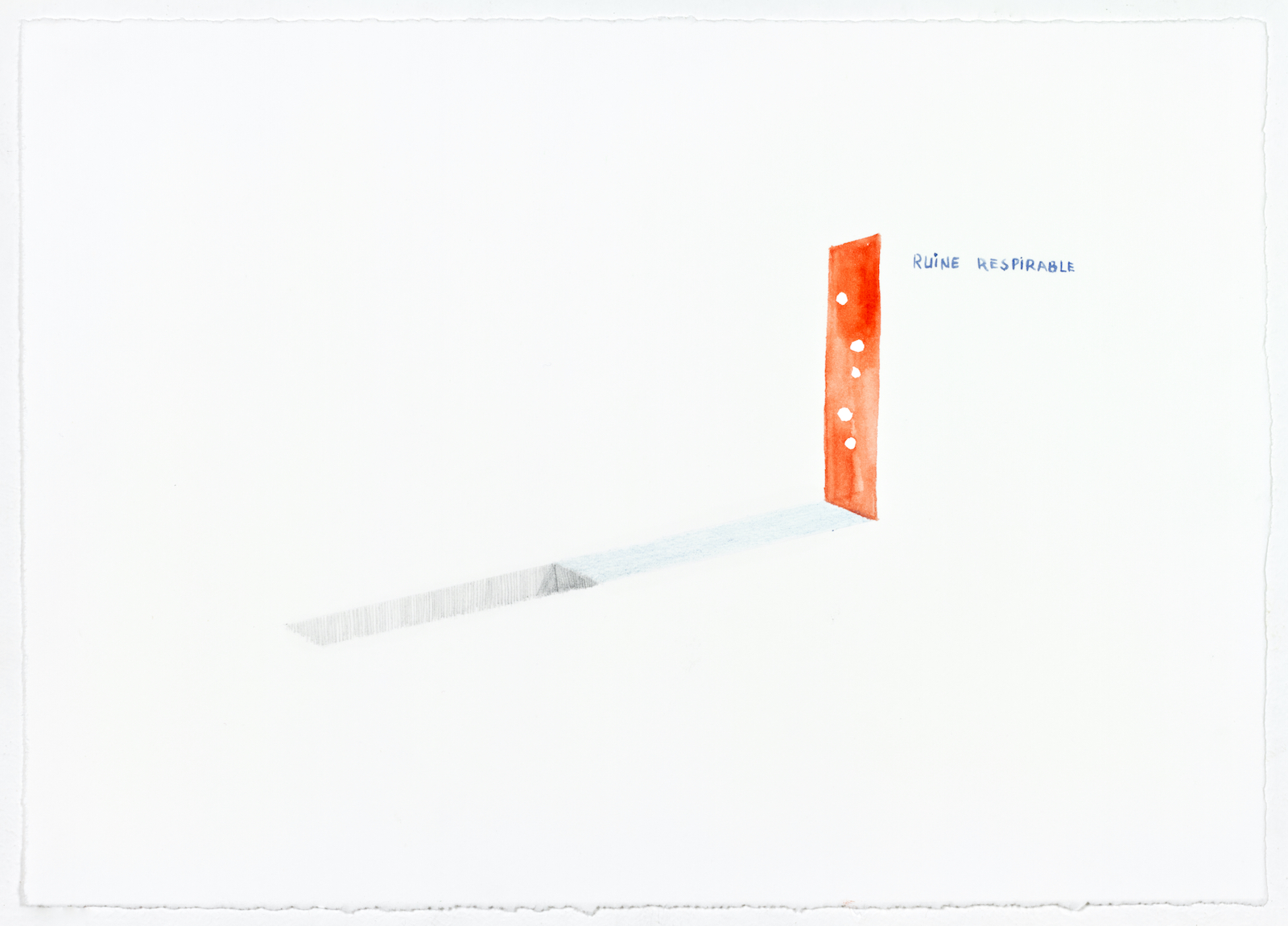
22 x 31 cm
signed at the bottom right of the back
Inspired by Jean Sénac's poems, Massinissa Selmani tries to capture the particular rhythm of the author's writing. He draws fragments with watercolour that echo the language. The sentences are sometimes left as they are, sometimes invented, modified or expanded, while preserving and emphasizing the impertinence and absurdity of the revolutionary poet's words. Far from illustration, Massinissa Selmani focuses mainly on the formal and graphic rhythm to develop a poetry of drawing that is central in his work.
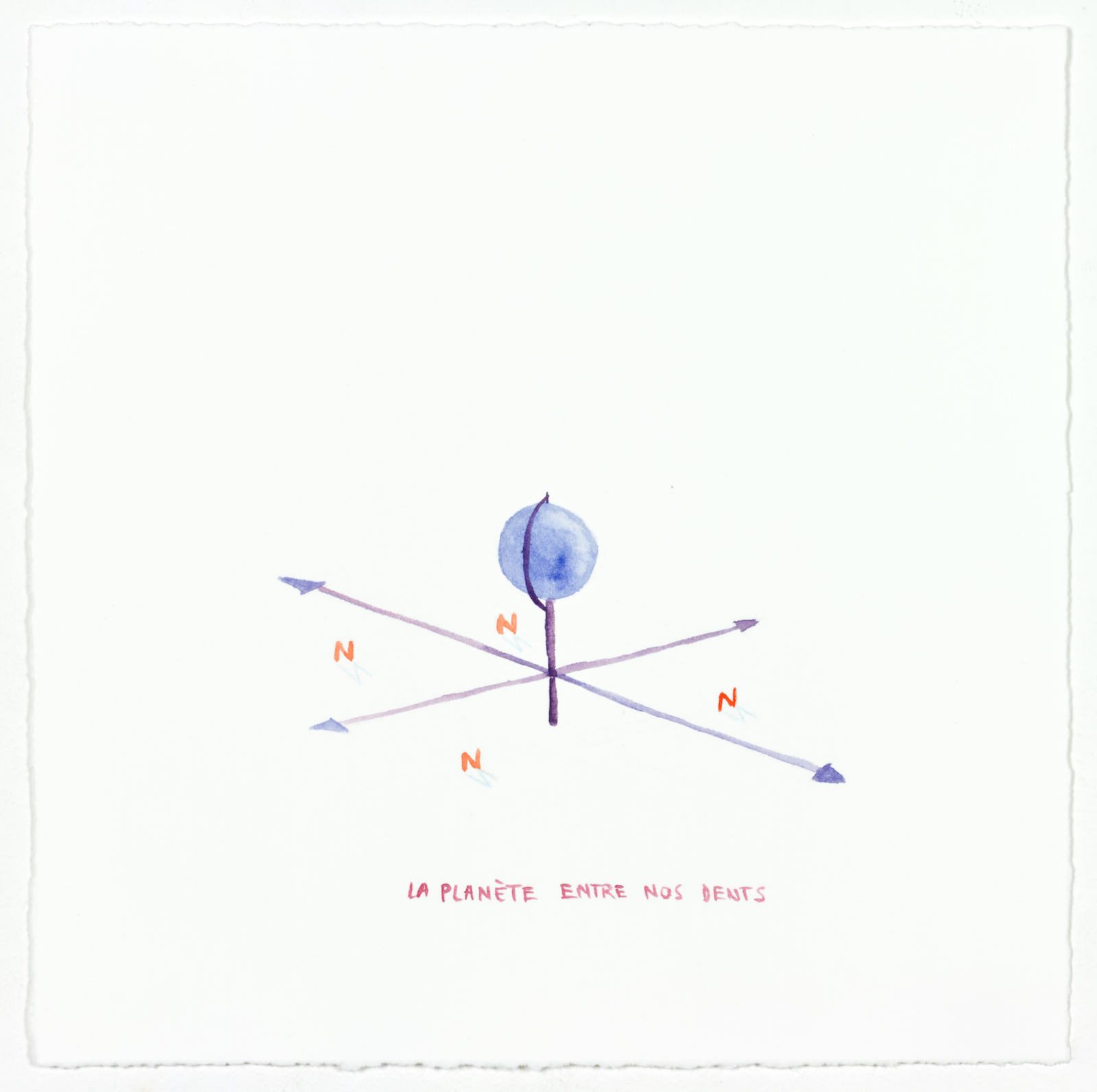
22 x 22 cm
signed at the bottom right of the back
Inspired by Jean Sénac's poems, Massinissa Selmani tries to capture the particular rhythm of the author's writing. He draws fragments with watercolour that echo the language. The sentences are sometimes left as they are, sometimes invented, modified or expanded, while preserving and emphasizing the impertinence and absurdity of the revolutionary poet's words. Far from illustration, Massinissa Selmani focuses mainly on the formal and graphic rhythm to develop a poetry of drawing that is central in his work.
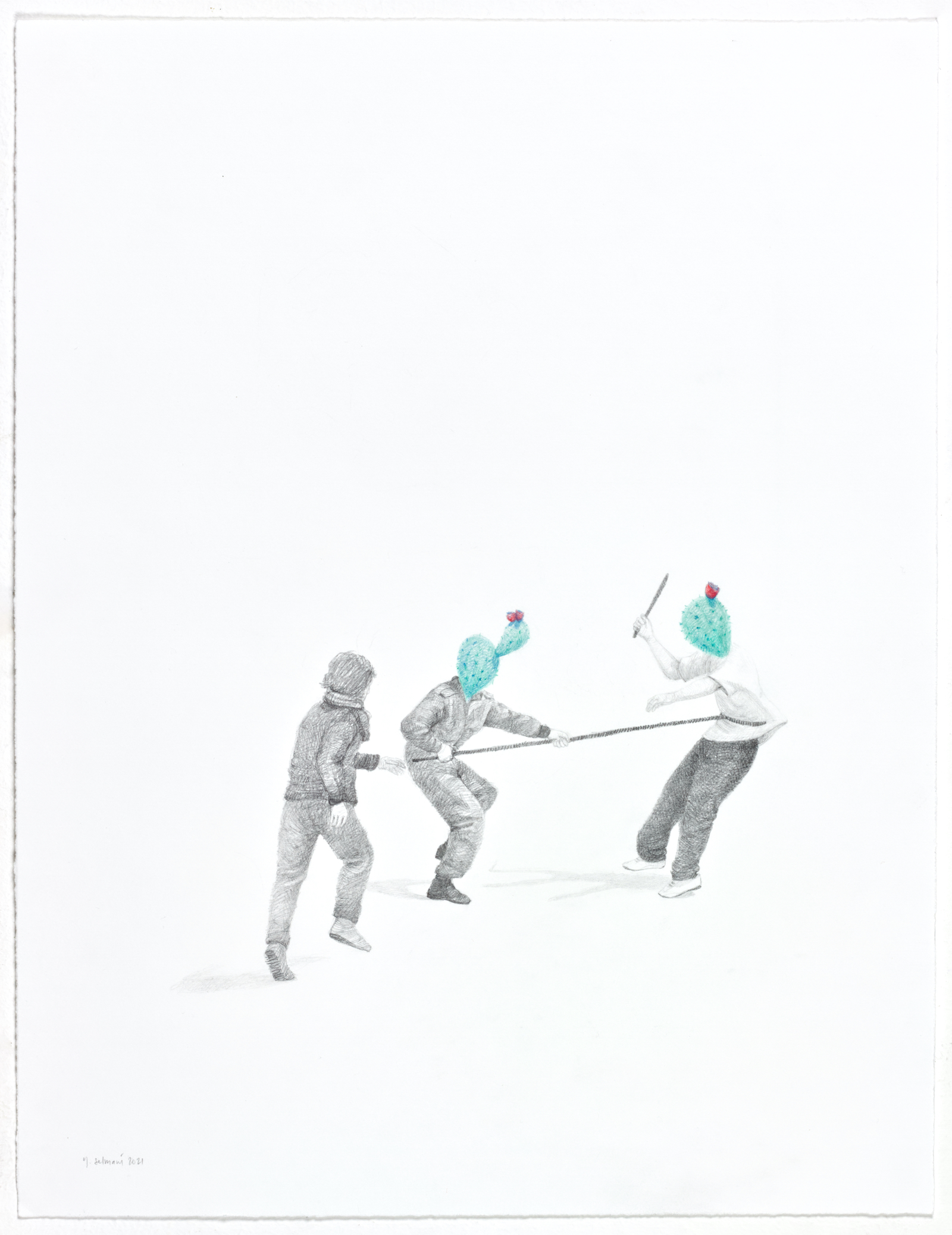
32,5 x 25 cm
Signed at the bottom left
In 3 jours de travail, Massinissa Selmani depicts an scene without decor, occupied by three characters with anonymised faces, emphasising their movement all the more. The uniform of one of them suggests a position of power in relation to the other two, reminiscent of the images of arrests that feed the news. However, the artist does not wish to refer to a specific situation, and inserts enigmatic elements, such as this long metal rod that keeps the distance or these cacti in place of the faces. These associations induce a disturbing strangeness, between comic absurdity and fright.
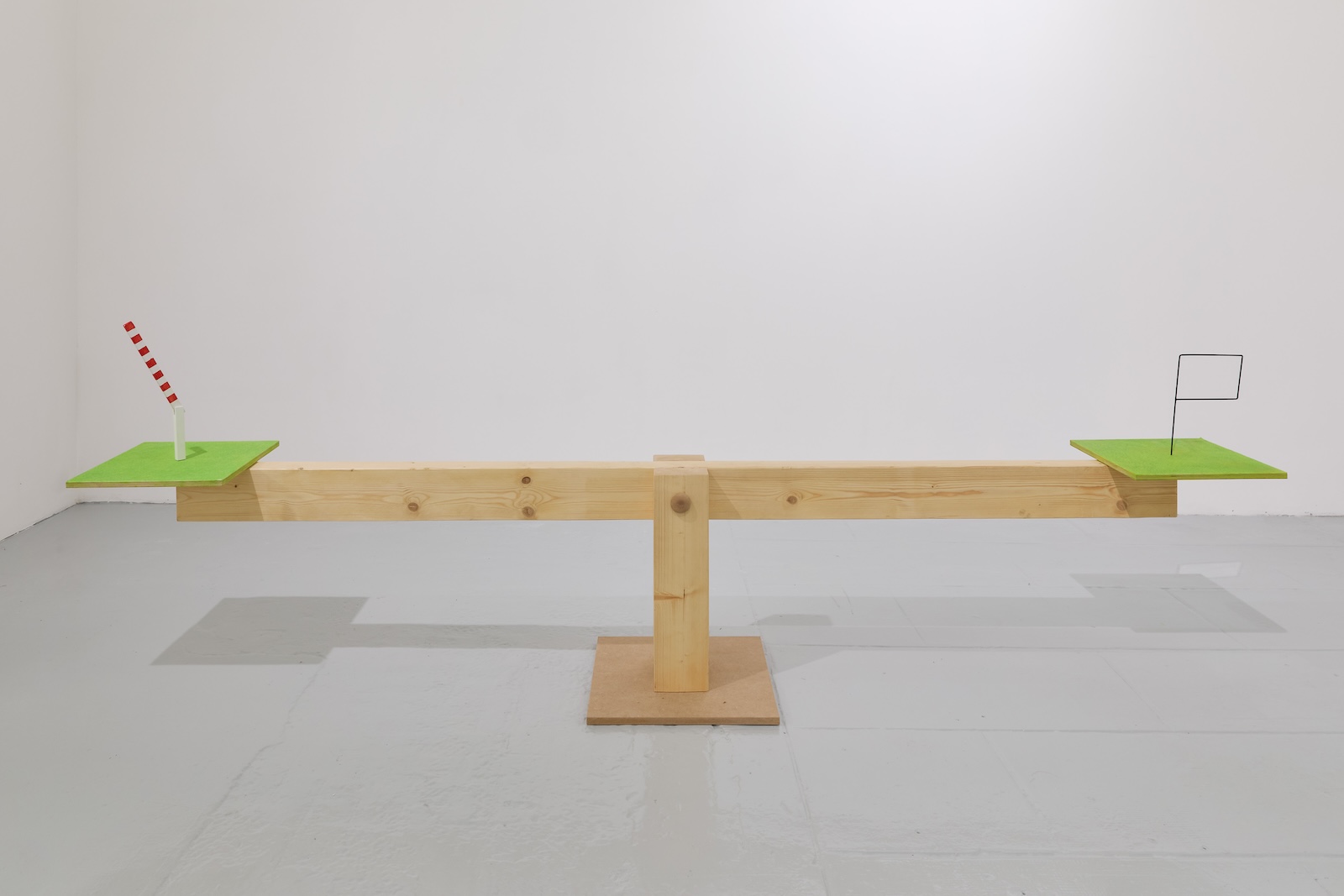
©jcLett
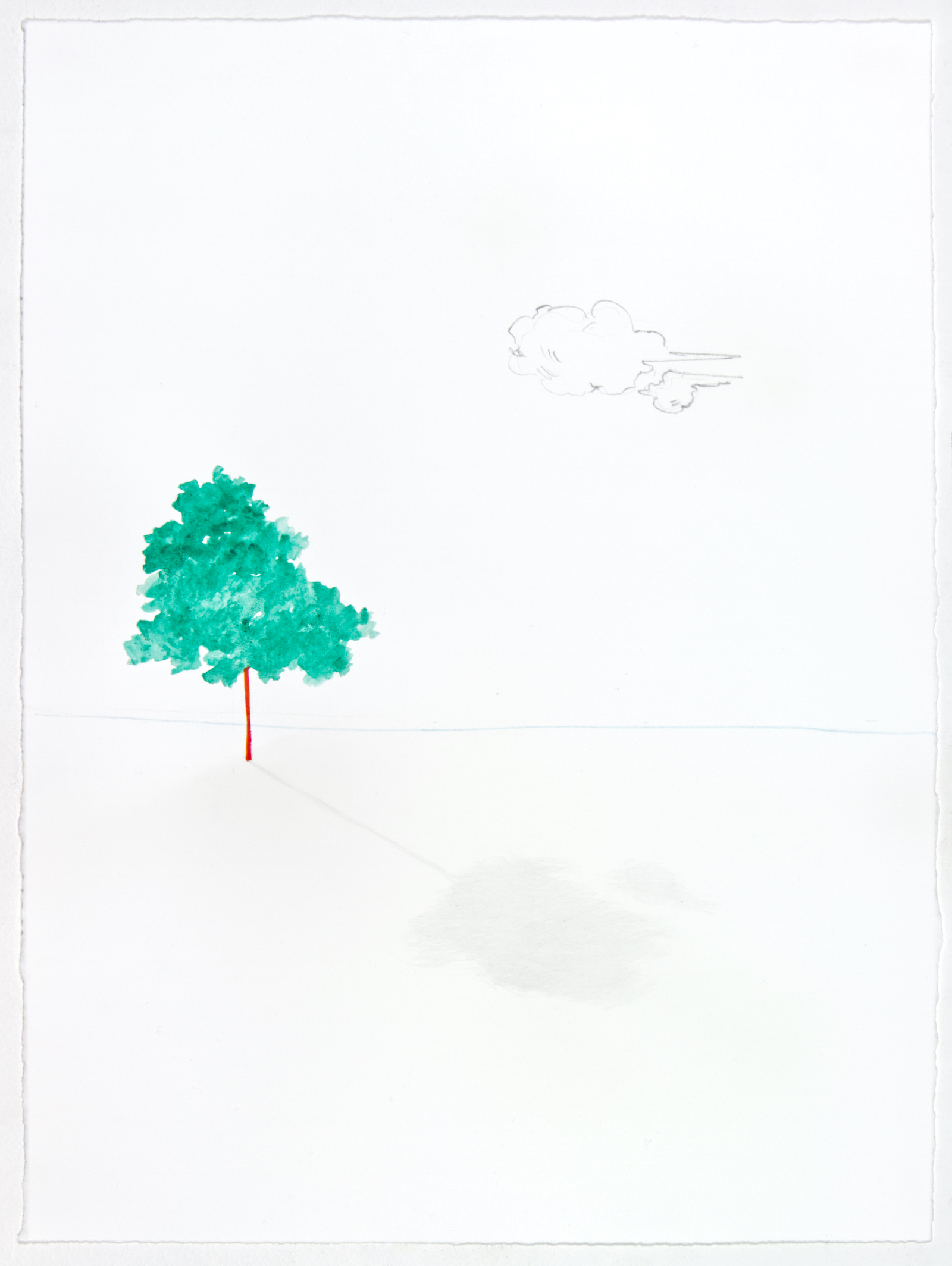
42 x 31 cm
signed at the bottom right of the back
In this drawing, Massinissa Selmani correlates the shadow of an orphaned and coloured tree with the one of a cloud that dominates it.
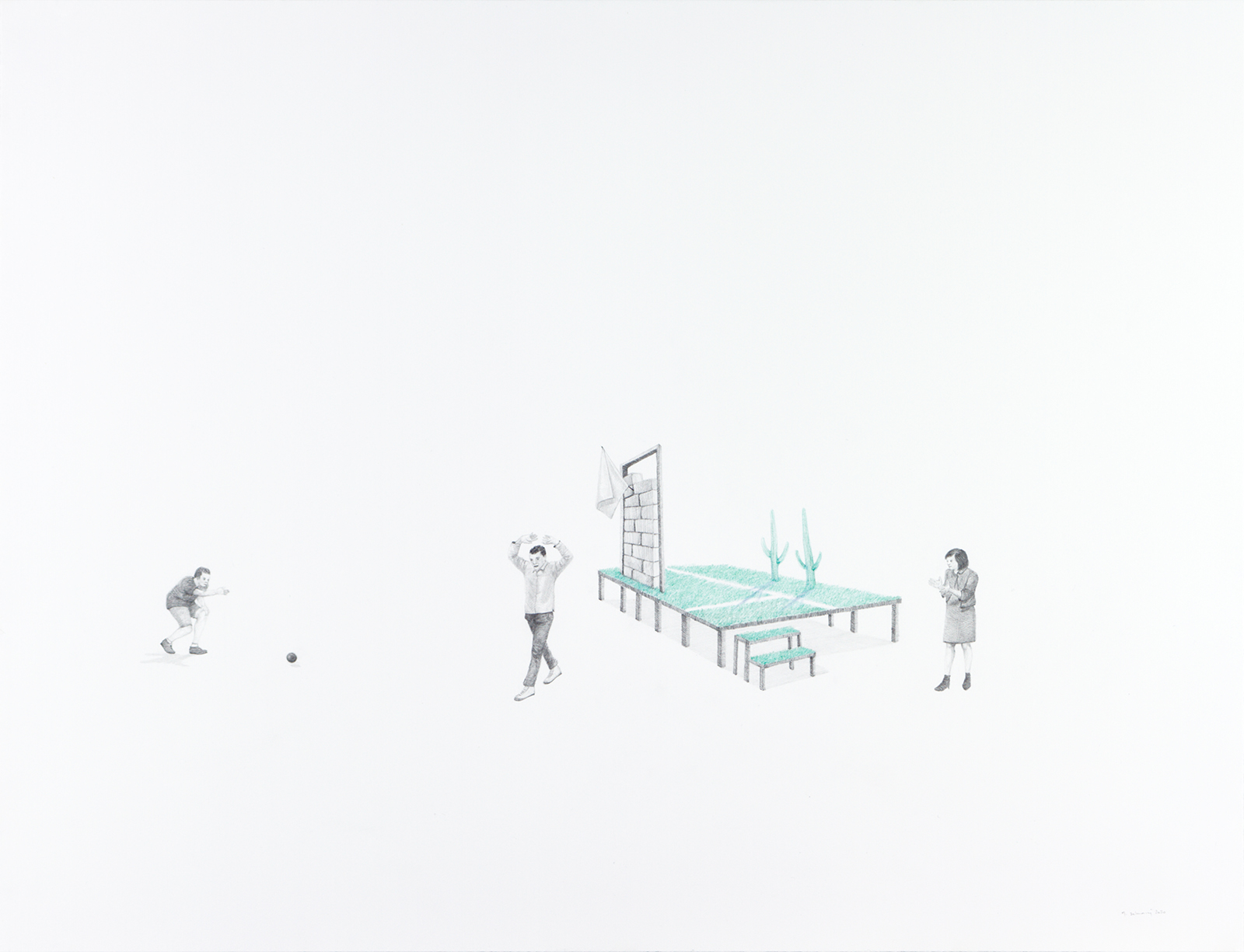
Graphite and coloured pencil on paper
50 x 65 cm
Signe at the bottom left
In Amorce dans l'air léger, Massinissa Selmani assembles elements to produce strange, even absurd situations, imbued with a certain gravity; they suggest signs of a latent tragedy or the beginnings of an elusive violence to come. The resulting storytelling, deliberately constructed from postures or fragments of architecture that seem familiar, escapes the possibility of situating or dating them. The elements thus isolated from their context tend to make the situations eternal.
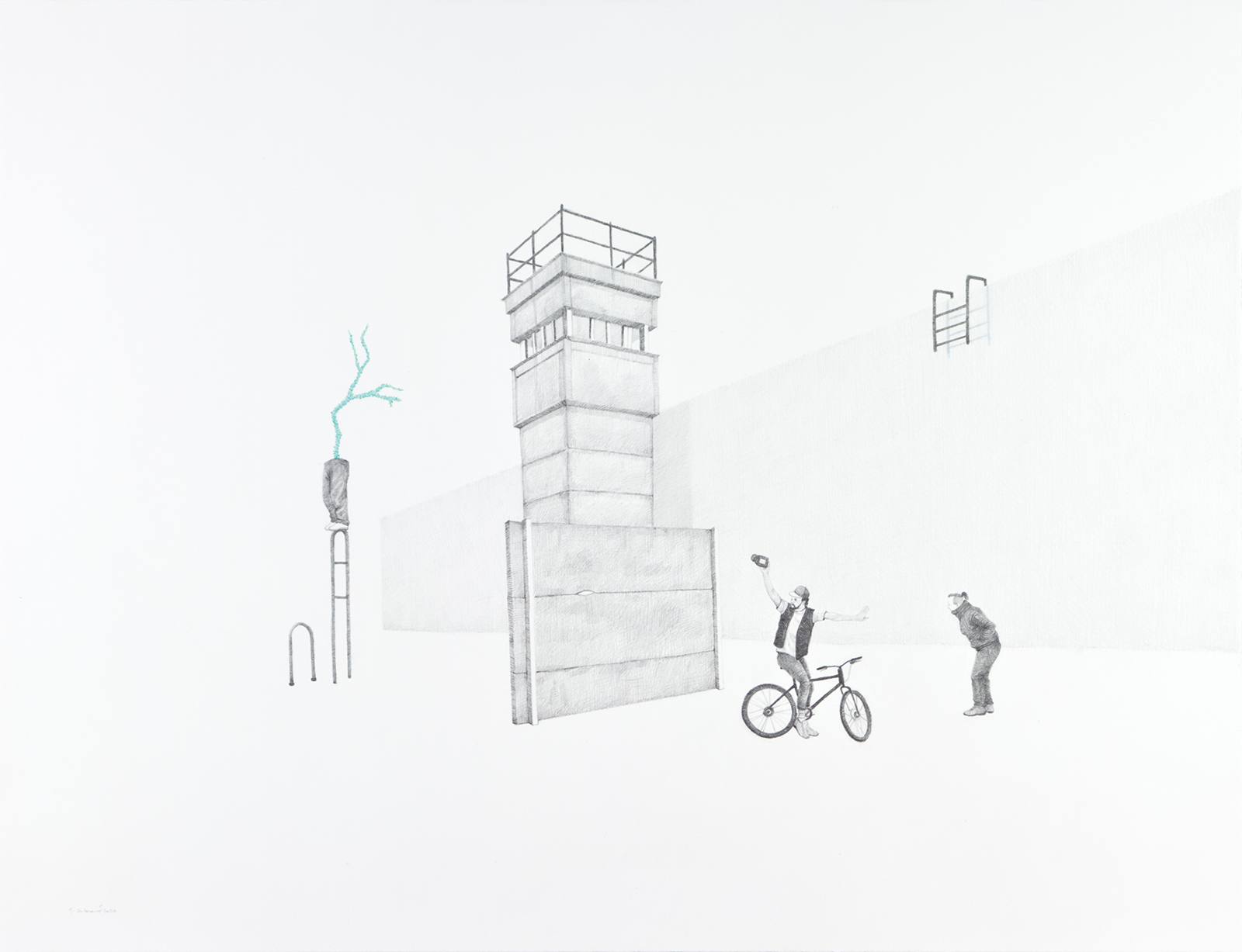
Graphite and coloured pencil on paper
50 x 65 cm
Signe at the bottom left
In Amorce dans l'air léger, Massinissa Selmani assembles elements to produce strange, even absurd situations, imbued with a certain gravity; they suggest signs of a latent tragedy or the beginnings of an elusive violence to come. The resulting storytelling, deliberately constructed from postures or fragments of architecture that seem familiar, escapes the possibility of situating or dating them. The elements thus isolated from their context tend to make the situations eternal.
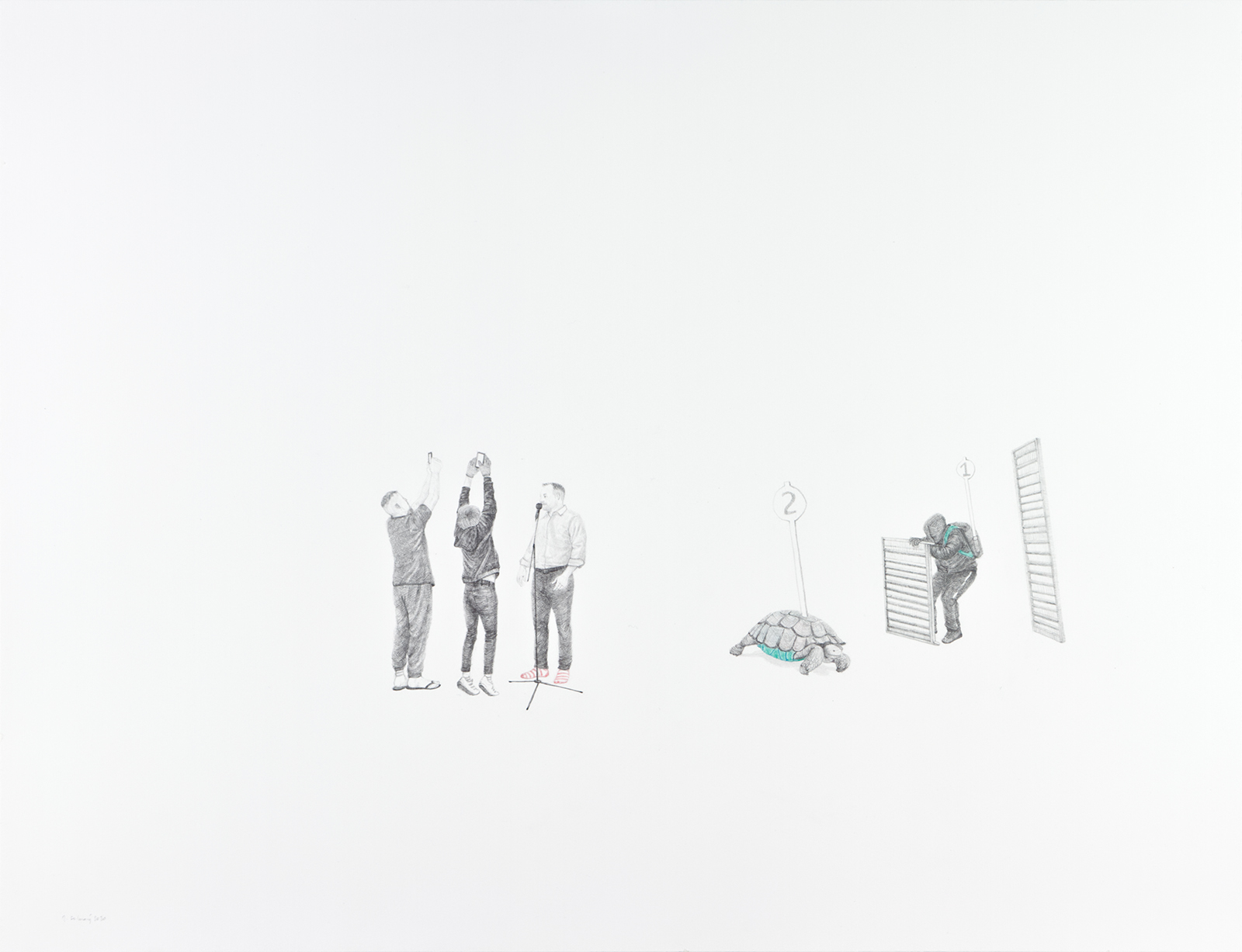
Graphite and coloured pencil on paper
50 x 65 cm
Signe at the bottom right
In Amorce dans l'air léger, Massinissa Selmani assembles elements to produce strange, even absurd situations, imbued with a certain gravity; they suggest signs of a latent tragedy or the beginnings of an elusive violence to come. The resulting storytelling, deliberately constructed from postures or fragments of architecture that seem familiar, escapes the possibility of situating or dating them. The elements thus isolated from their context tend to make the situations eternal.
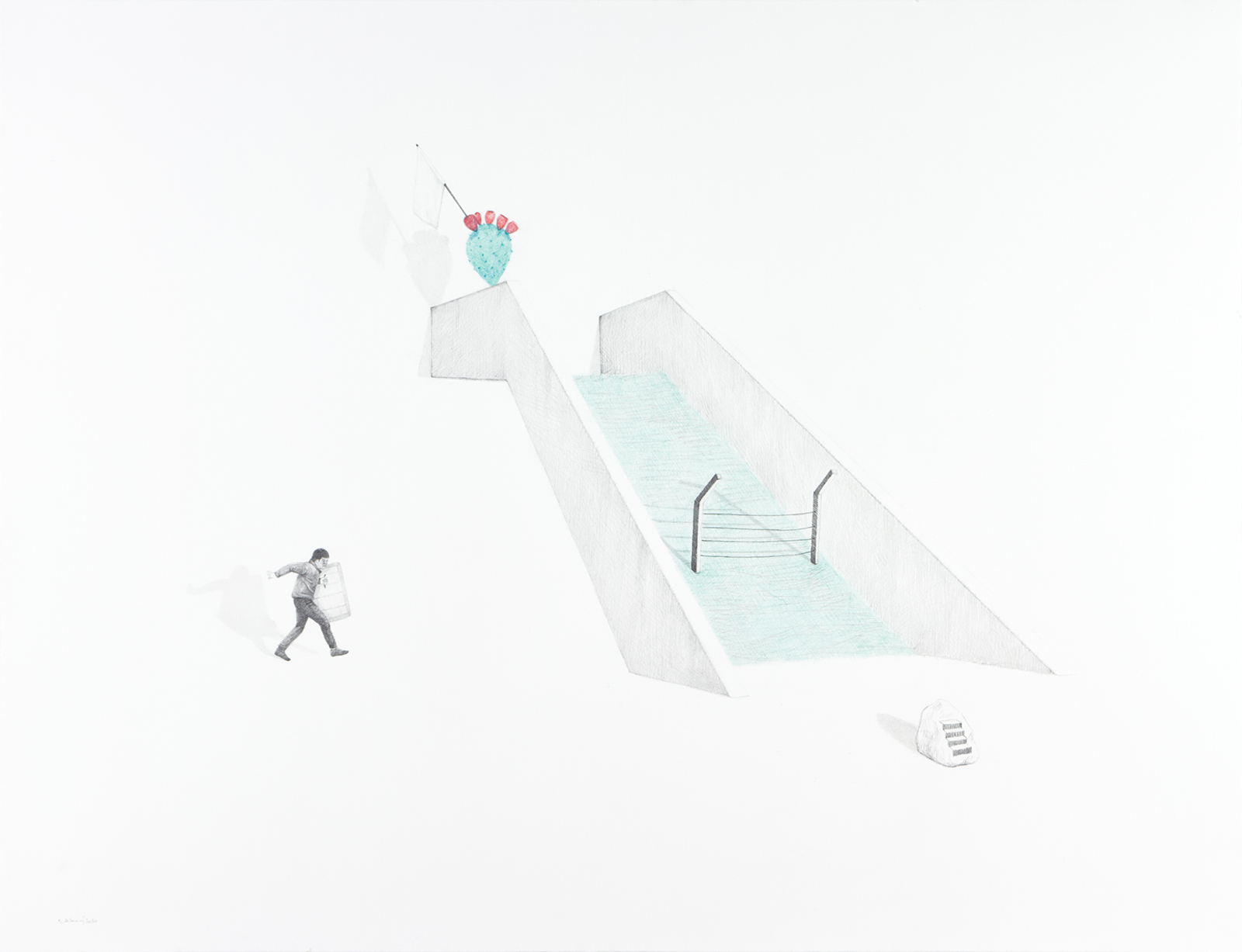
Graphite and coloured pencil on paper
50 x 65 cm
Signe at the bottom left
In Amorce dans l'air léger, Massinissa Selmani assembles elements to produce strange, even absurd situations, imbued with a certain gravity; they suggest signs of a latent tragedy or the beginnings of an elusive violence to come. The resulting storytelling, deliberately constructed from postures or fragments of architecture that seem familiar, escapes the possibility of situating or dating them. The elements thus isolated from their context tend to make the situations eternal.
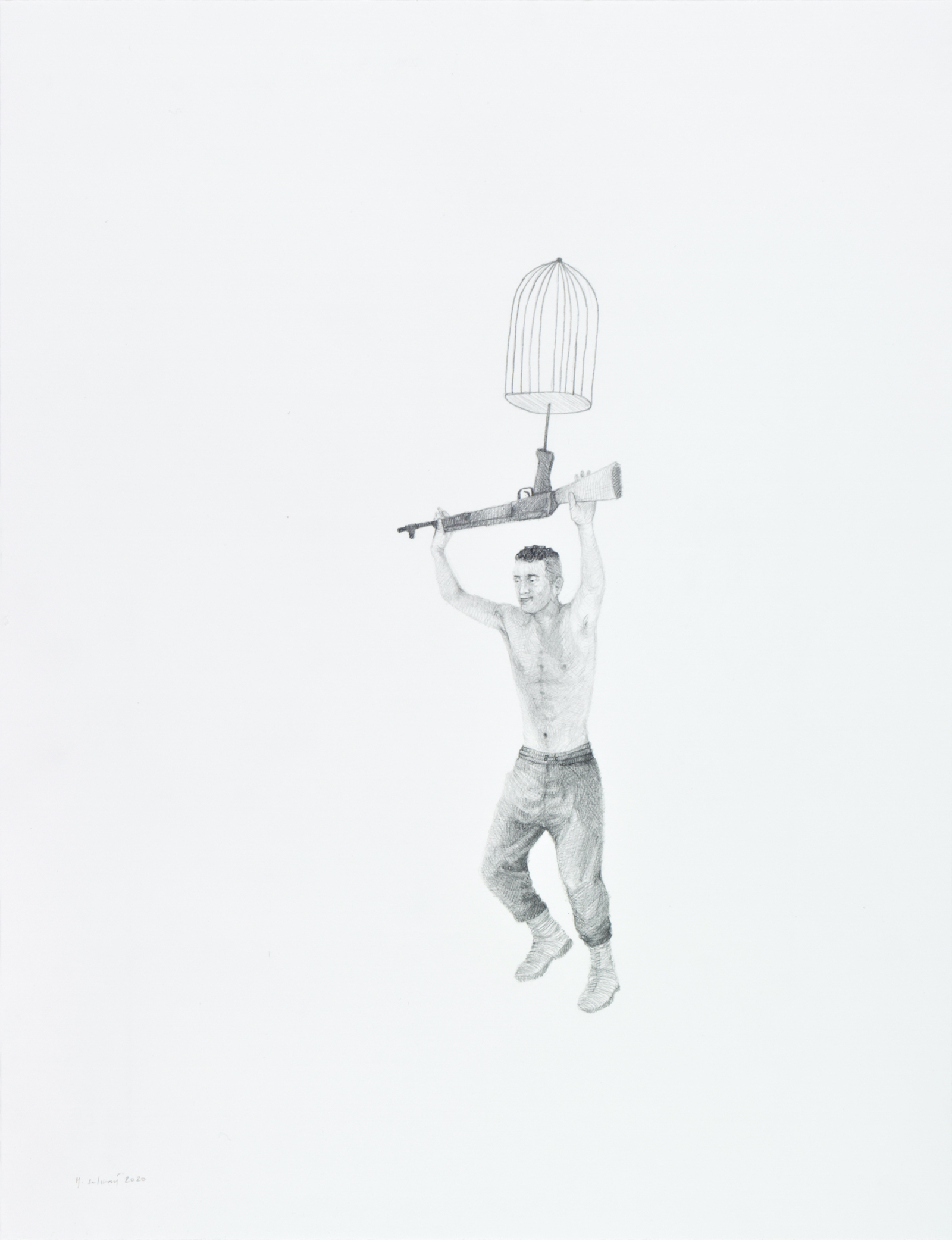
graphite on paper
32,5 x 25 cm
Signe at the bottom left
The Coques lourdes series is an opportunity for Massinissa Selmani to draw sceneries in which the characters represented seem to adopt postures of retreat and passivity. These situations evoke various forms of violence and threat which remain, as always with the artist, largely undetermined. Manipulating humour and gravity, Massinissa Selmani reveals a reality between poetry and politics.
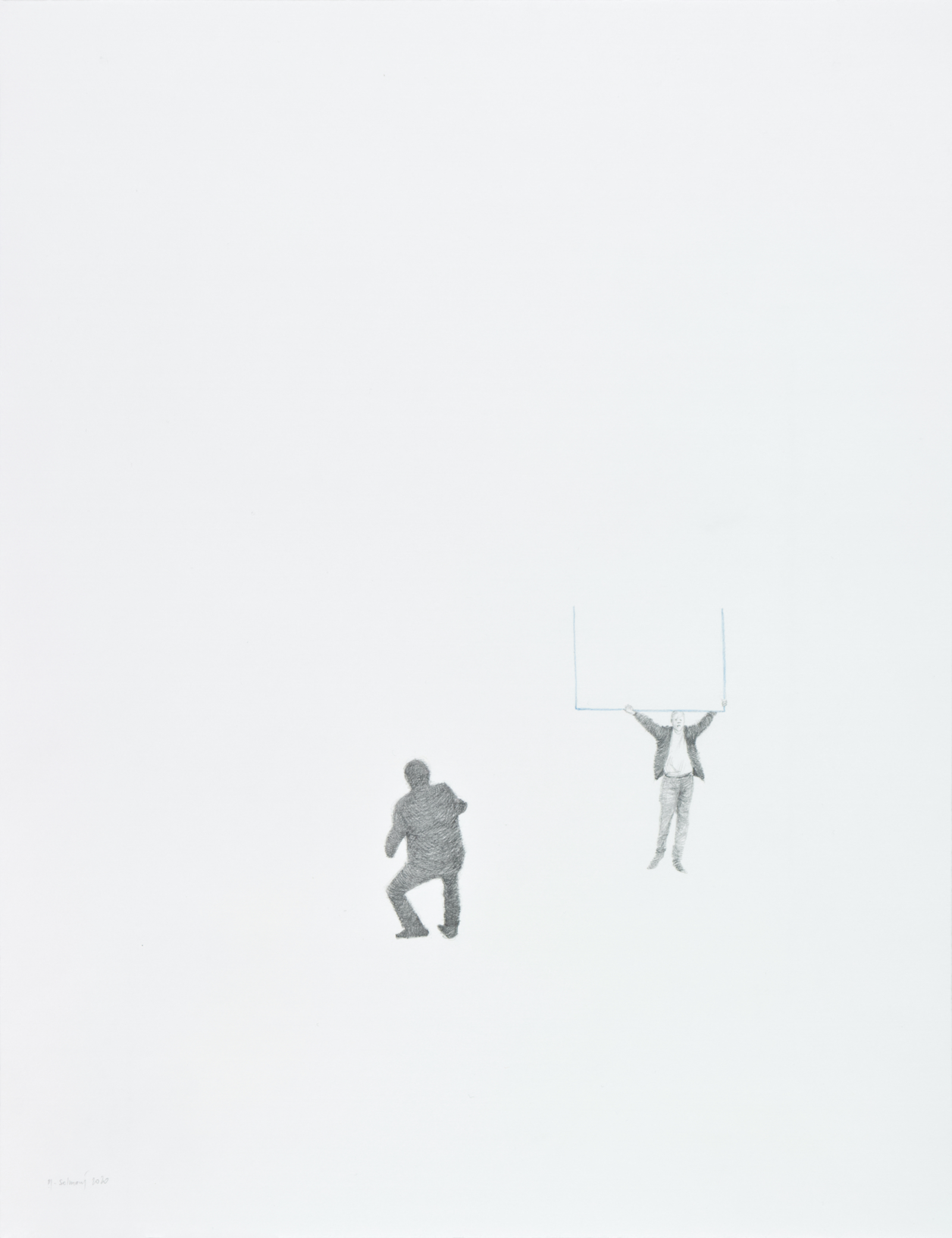
graphite and colored pencil on paper
32,5 x 25 cm
Signe at the bottom left
The Coques lourdes series is an opportunity for Massinissa Selmani to draw sceneries in which the characters represented seem to adopt postures of retreat and passivity. These situations evoke various forms of violence and threat which remain, as always with the artist, largely undetermined. Manipulating humour and gravity, Massinissa Selmani reveals a reality between poetry and politics.
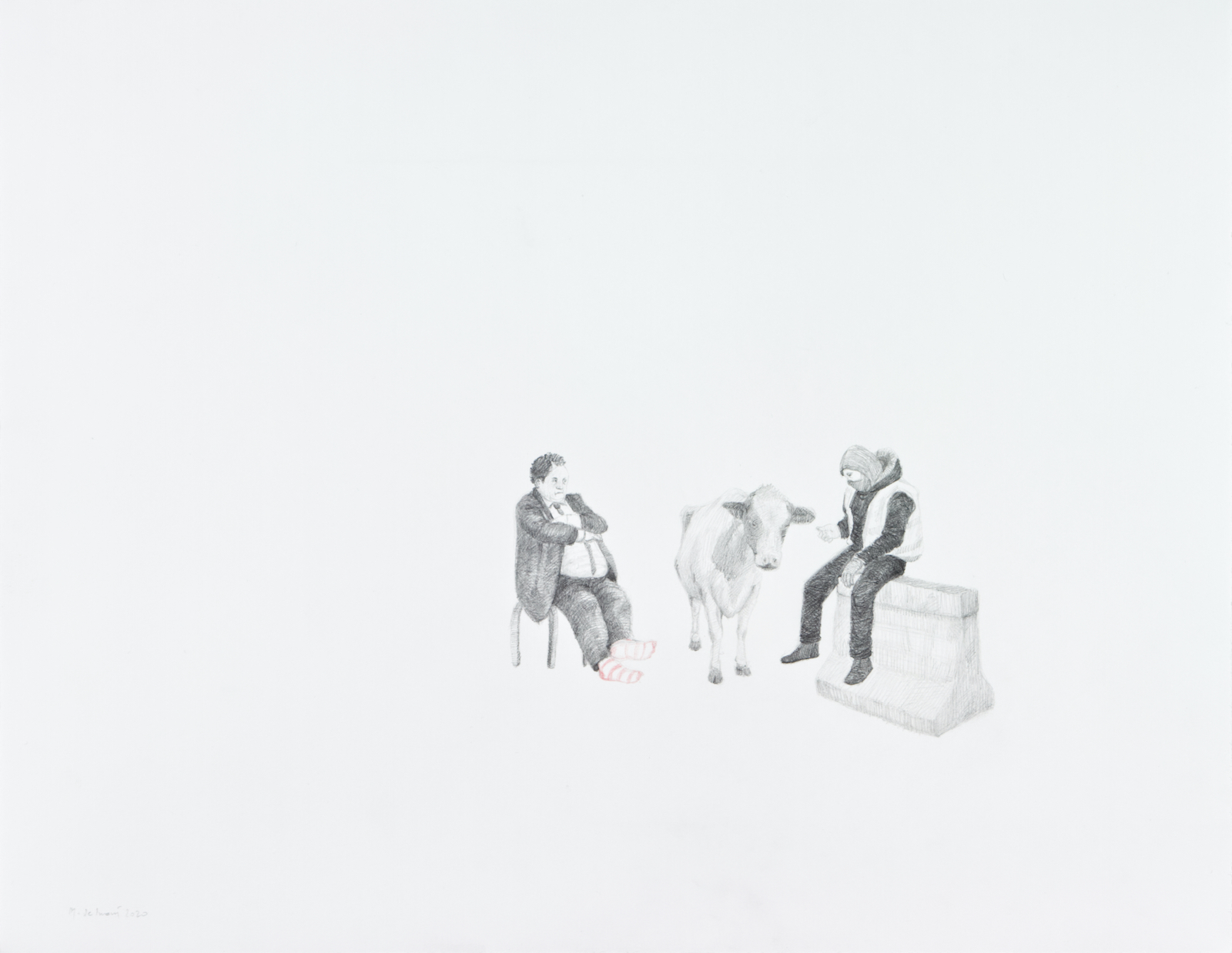
graphite and colored pencil on paper
25 x 32,5 cm
Signe at the bottom left
The Coques lourdes series is an opportunity for Massinissa Selmani to draw sceneries in which the characters represented seem to adopt postures of retreat and passivity. These situations evoke various forms of violence and threat which remain, as always with the artist, largely undetermined. Manipulating humour and gravity, Massinissa Selmani reveals a reality between poetry and politics.
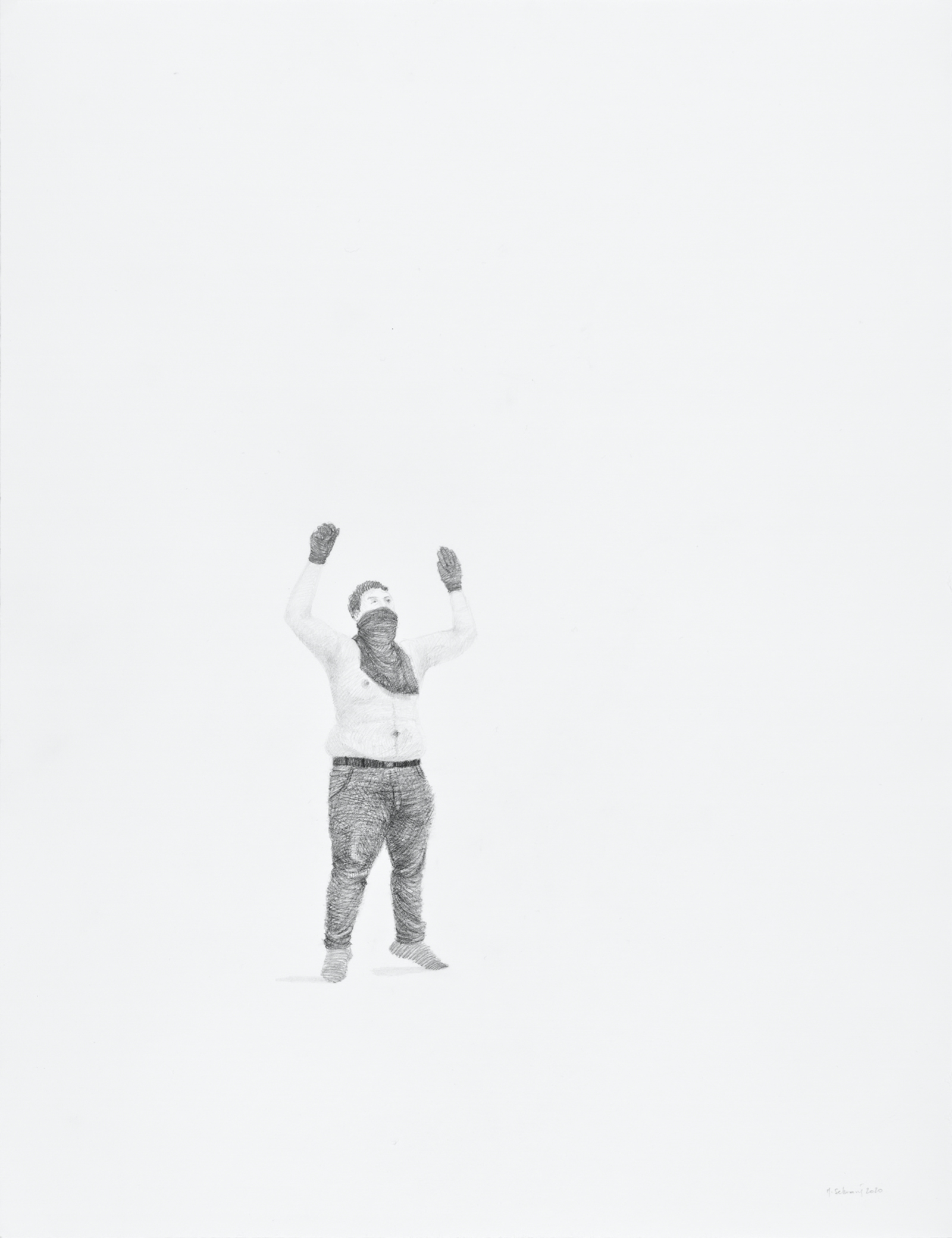
Graphite on paper
32,5 x 25 cm
Signe at the bottom right
The Coques lourdes series is an opportunity for Massinissa Selmani to draw sceneries in which the characters represented seem to adopt postures of retreat and passivity. These situations evoke various forms of violence and threat which remain, as always with the artist, largely undetermined. Manipulating humour and gravity, Massinissa Selmani reveals a reality between poetry and politics.
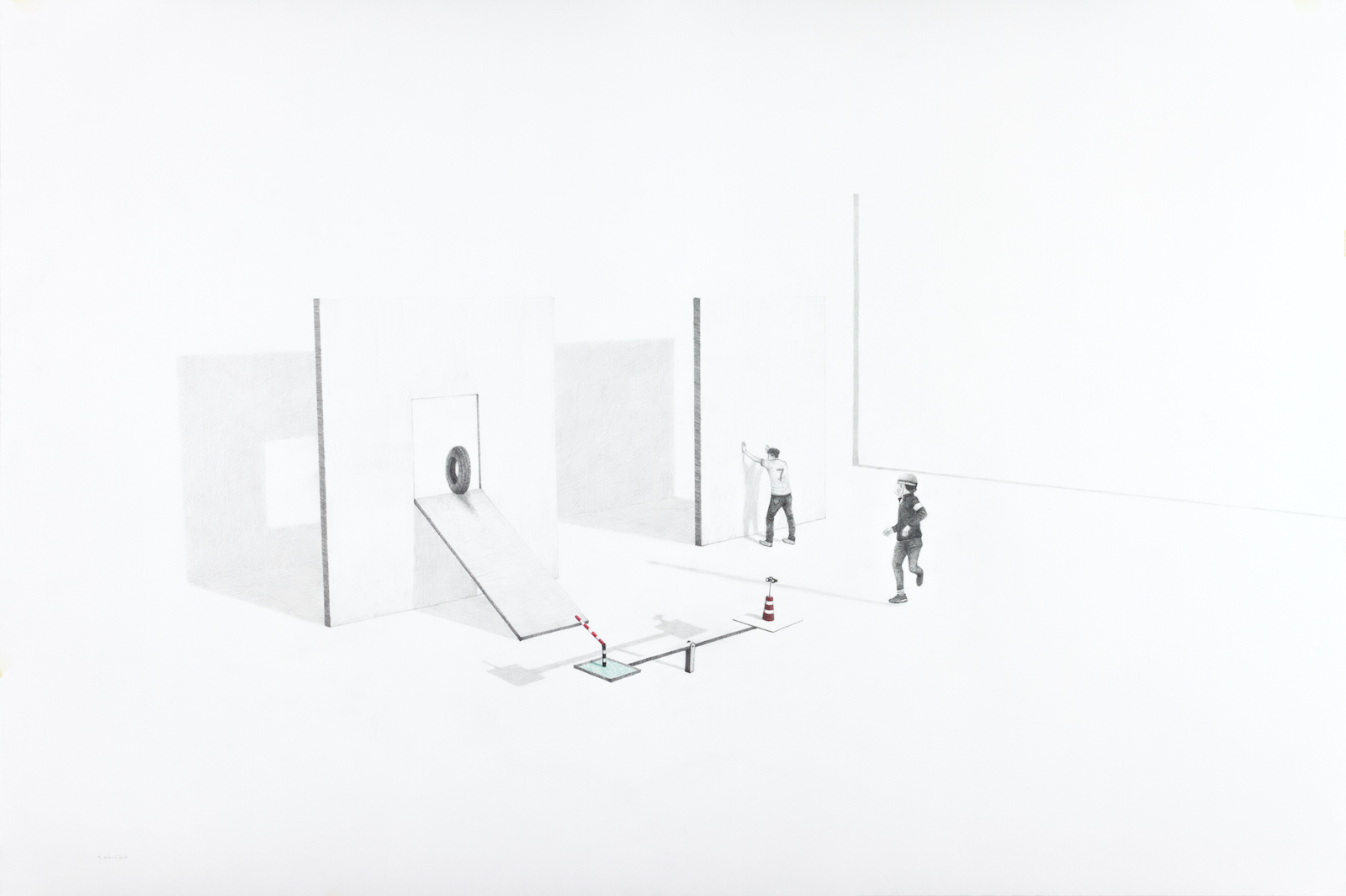
65 x 97,5 cm
Signed at the bottom left
Prélude de l'élan visible series has been inspired by the artist, after he was marked by the recent accounts of violence and arrests. Massinissa Selmani wanted to translate this use of excessive physical and institutional force. Nevertheless, he does not aim here to describe a specific action or event, but rather a situation in which the violence of authority is played out in the face of its being challenged through various forms of protest (resistance, opinions, the unbolting of statues, etc.). He thus offers a subjective reading of so-called "legitimate" physical violence by focusing more on its structural and unfathomable part rather than its contextual one.
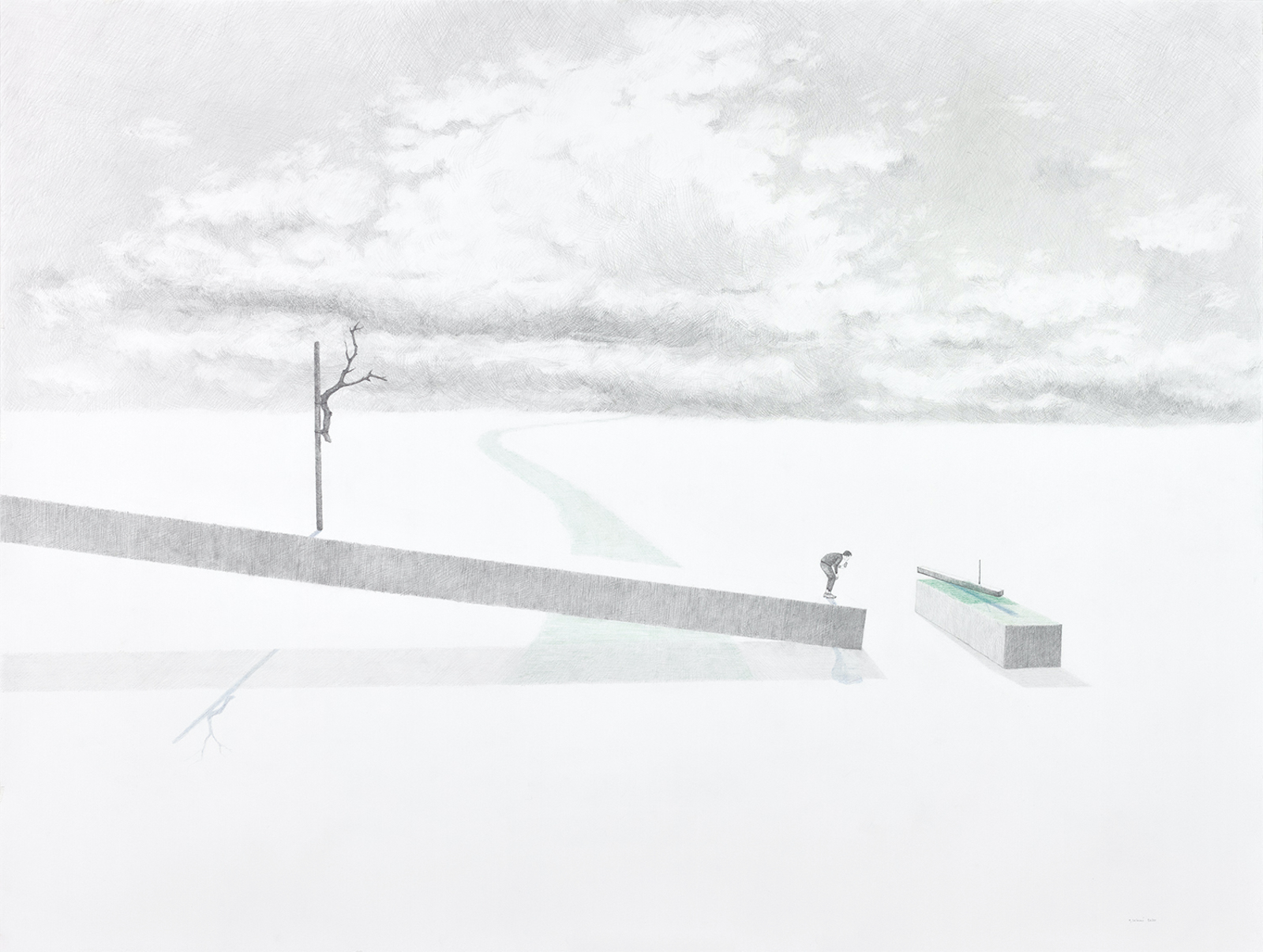
75 x 100 cm
Signed and dated lower right
The series Aubes insondables represents an evolution in the work of Massinissa Selmani. Here, the artist is interested in the forms's suggestion through a play on space and values. Although his sources of inspiration deflect from the written press, these works are nevertheless in line with his reflection of designing enigmatic, floating and imaginary spaces. He conceives environments, in an "unfathomable" style as the title suggests, without beginning or end, accentuating the mystery of floating scenes and architectures.
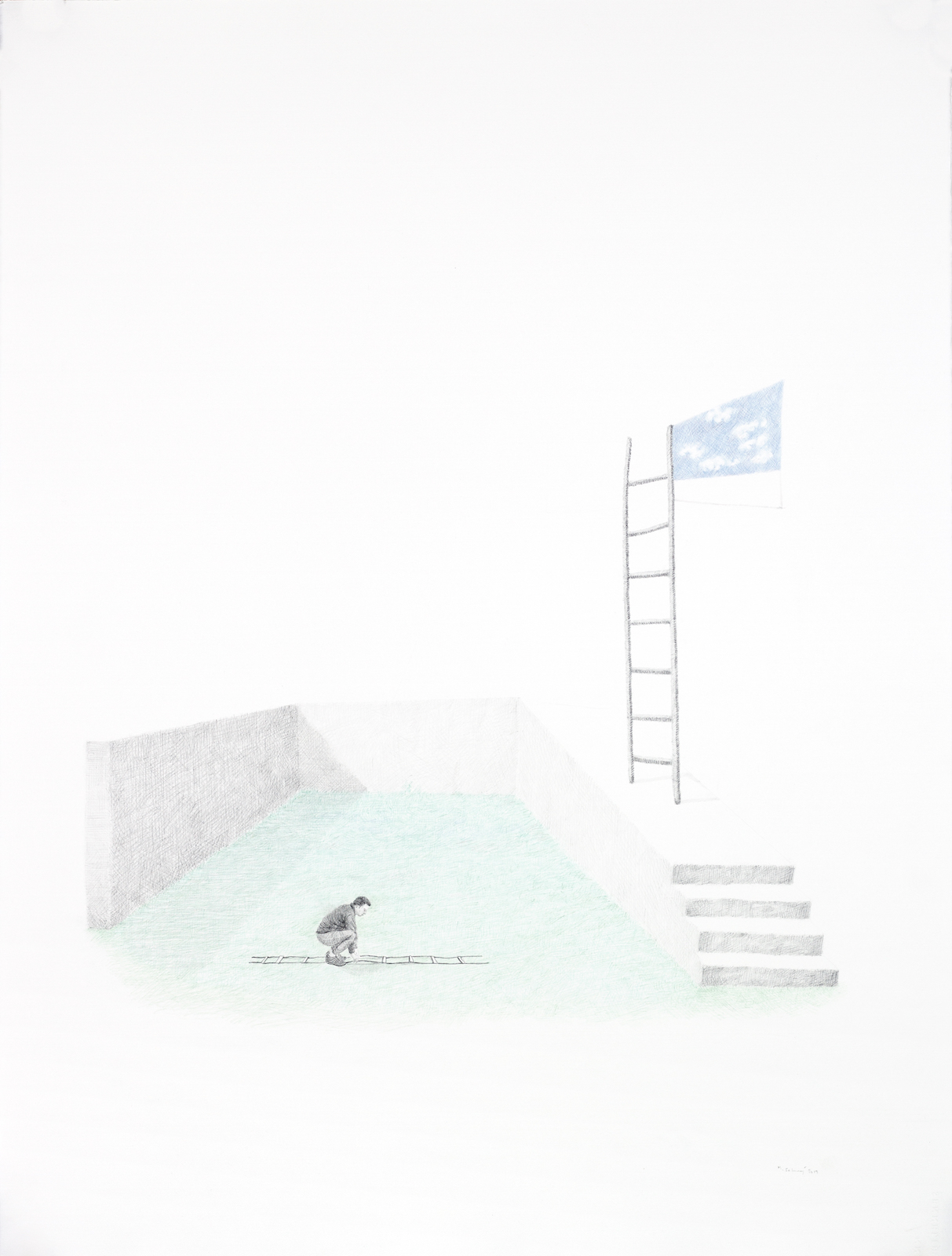
76 x 56 cm
Signed and dated lower right
Massinissa Selmani's drawings are inspired by political news, especially from cut-outs of the press that he has been collecting for many years. By confronting and juxtaposing these elements without logical coherence, the artist creates enigmatic and ambiguous scenes, underlining the ironic, even tragic character of the absurd and strange situations represented in his drawings.
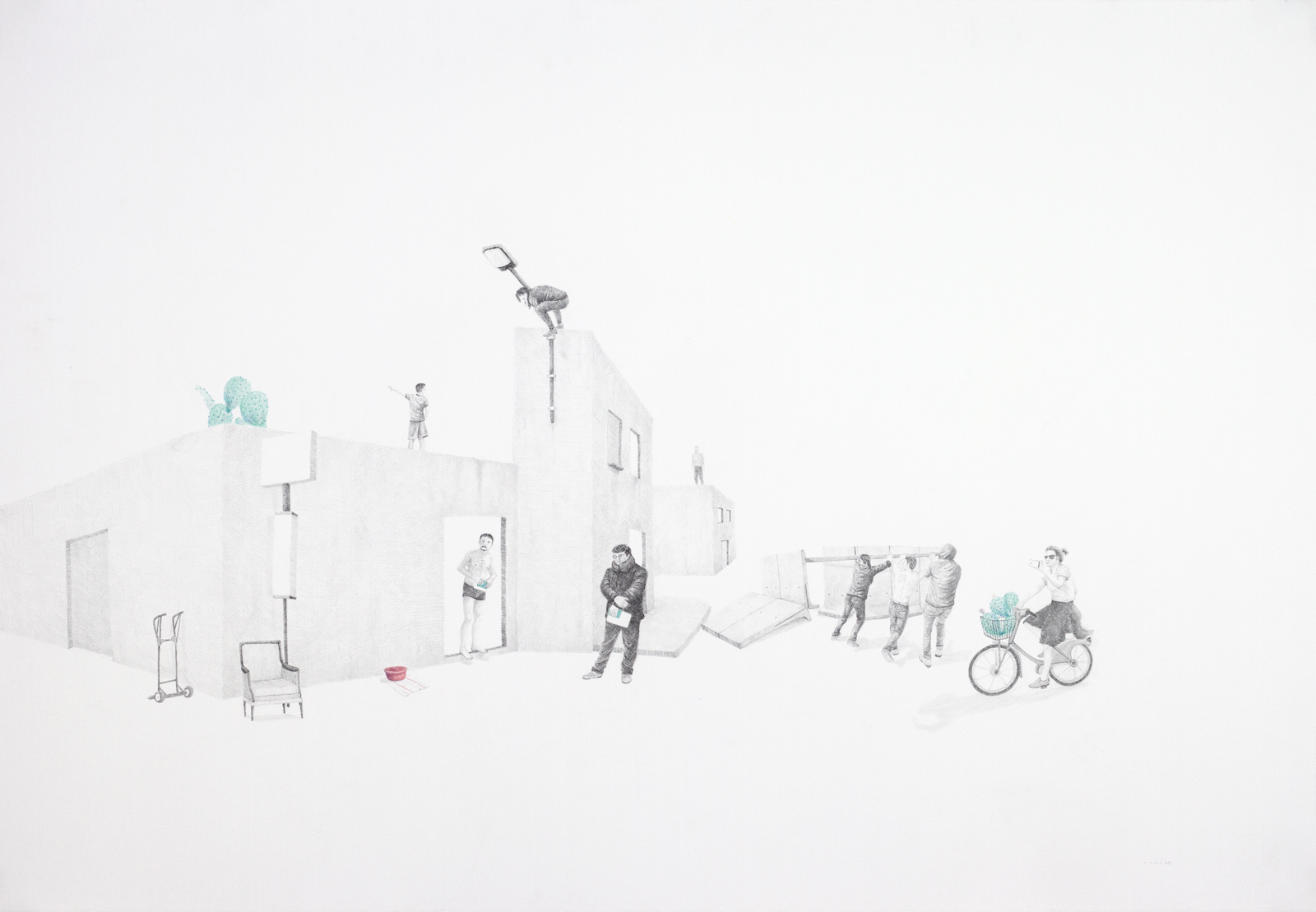
78 x 112 cm
signed, dated
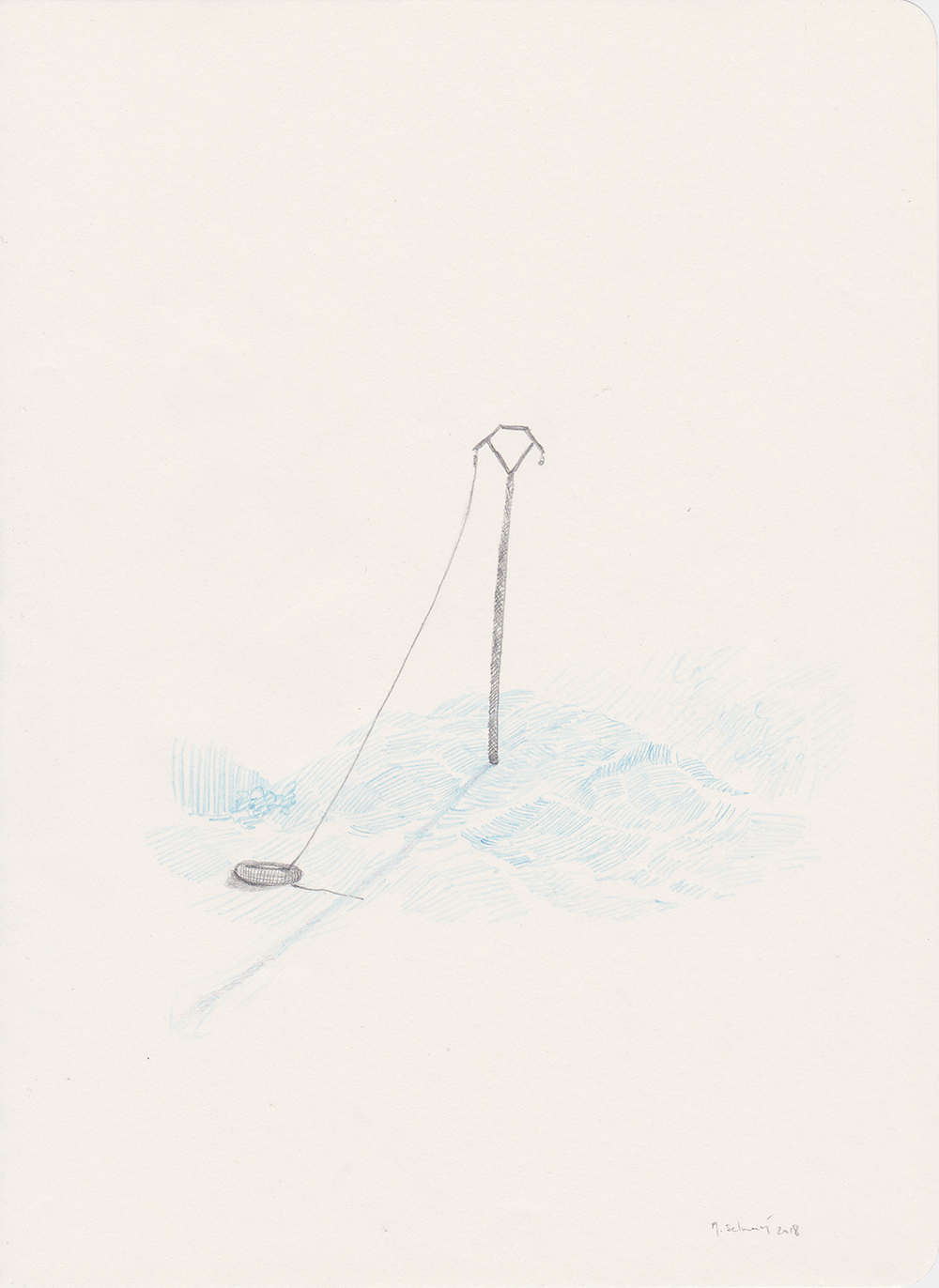
25 x 18,3 cm
Signed and date lower right
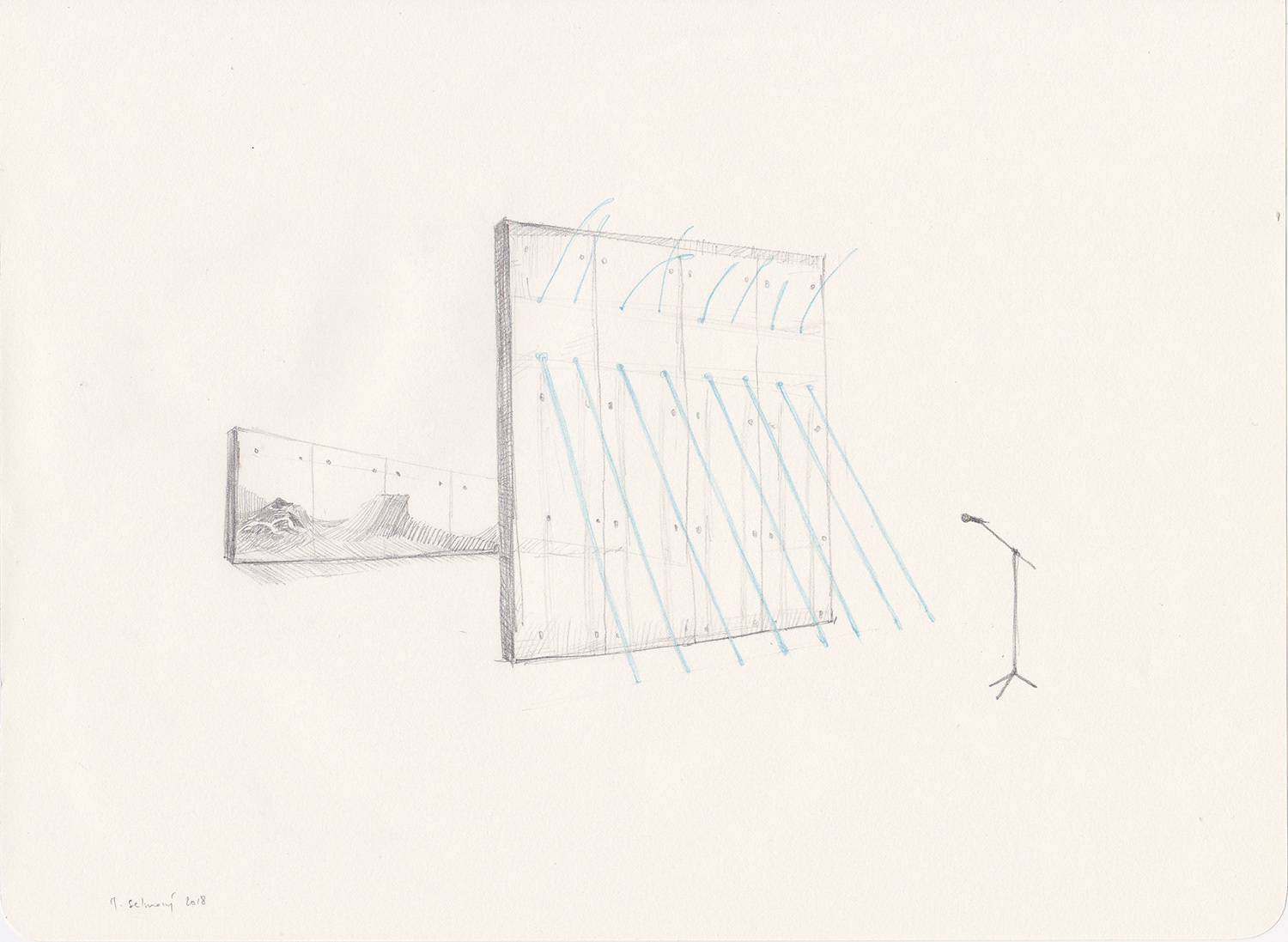
18,3 x 25 cm
Signed and date lower left
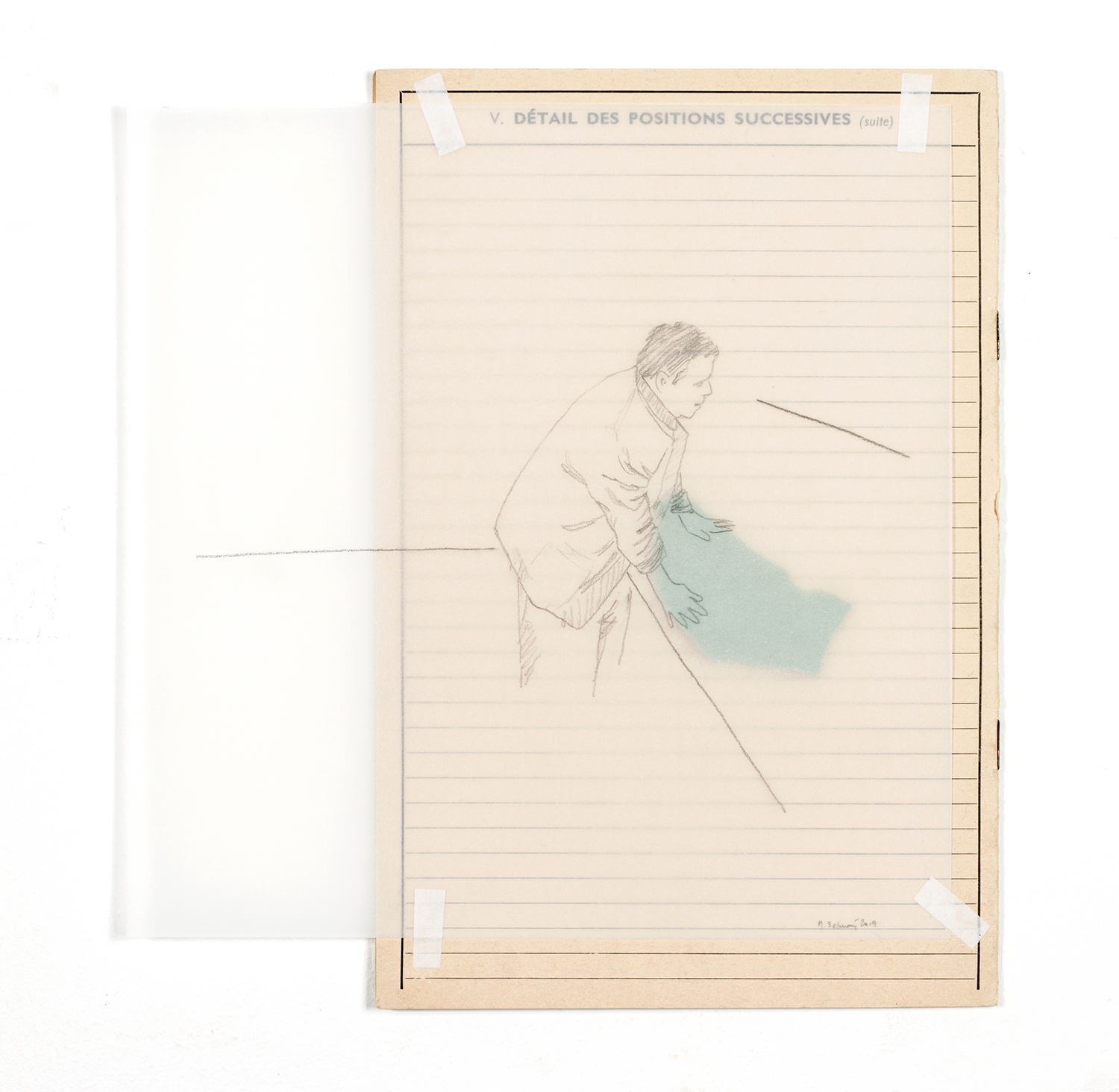
9,4 x 8,8 inches
lower right
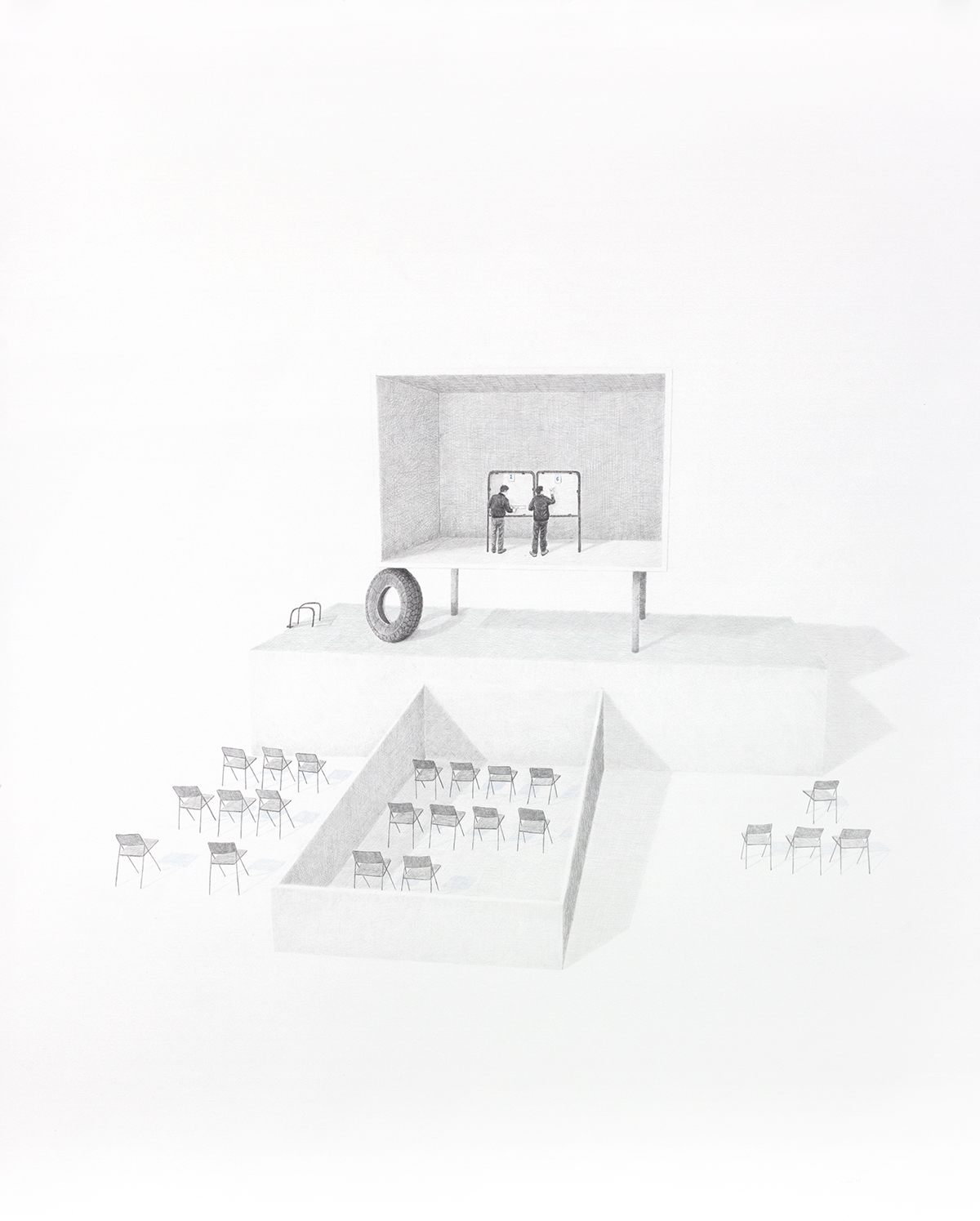
124 x 100 cm
Signed and dated lower right
La série des Aubes insondables marque une évolution dans le travail de Massinissa Selmani. Ici, l'artiste s'éloigne des traits de contour pour s'intéresser à la suggestion des formes par un jeu sur l'espace et les valeurs. Si ses sources d'inspiration s'écartent de la presse écrite, ces œuvres s'inscrivent néanmoins dans la continuité de son travail de conception d'espaces énigmatiques, flottants et imaginaires. Il constitue des environnements, au style « insondé » comme le suggère le titre, sans commencement ni fin, accentuant le mystère des scènes et des architectures flottantes.
Dans L'aube insondable #3, l'artiste représente des architectures impossibles et imaginaires autour d'une estrade et de chaises inaccessibles qui intensifient l'ambiguïté de la scène représentée.
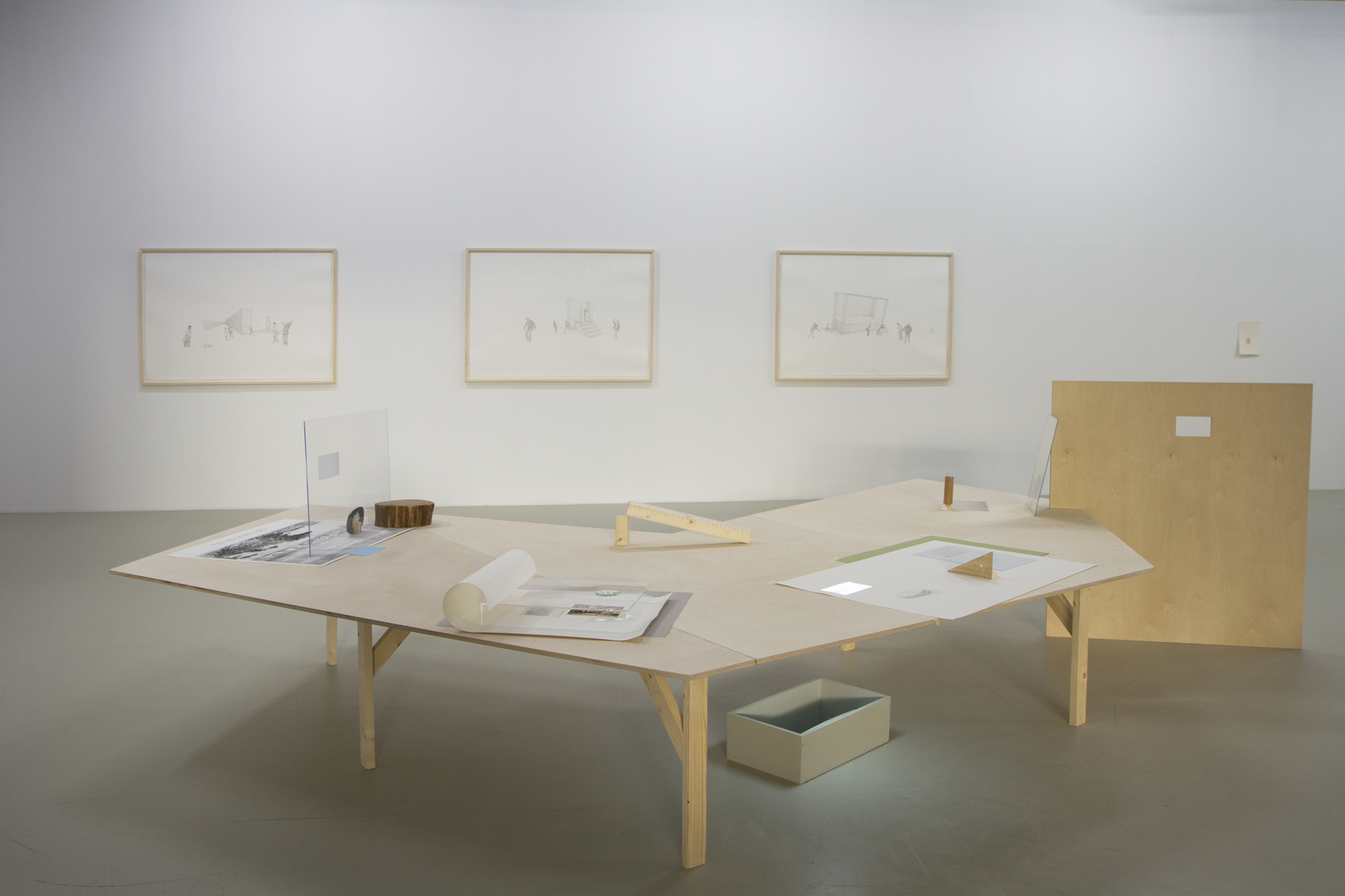
Various sizes
Dans quel sens traverser les antipodes est une installation inspirée du parcours de la figure anarchiste Louise Michel, qui, suite à sa déportation en Nouvelle-Calédonie après la défaite de la Commune de Paris, noua des relations avec les Kanaks dont elle soutint la révolte. Peu de temps après, elle entreprit un voyage en Algérie pour rendre visite aux bagnards qu'elle avait rencontré plus tôt, et y donna de nombreuses conférences. En investissant l'espace et en débordant de la page, Massinissa Selmani poursuit un travail d'expérimentation autour du dessin, mêlant une approche documentaire à des constructions fictionnelles.
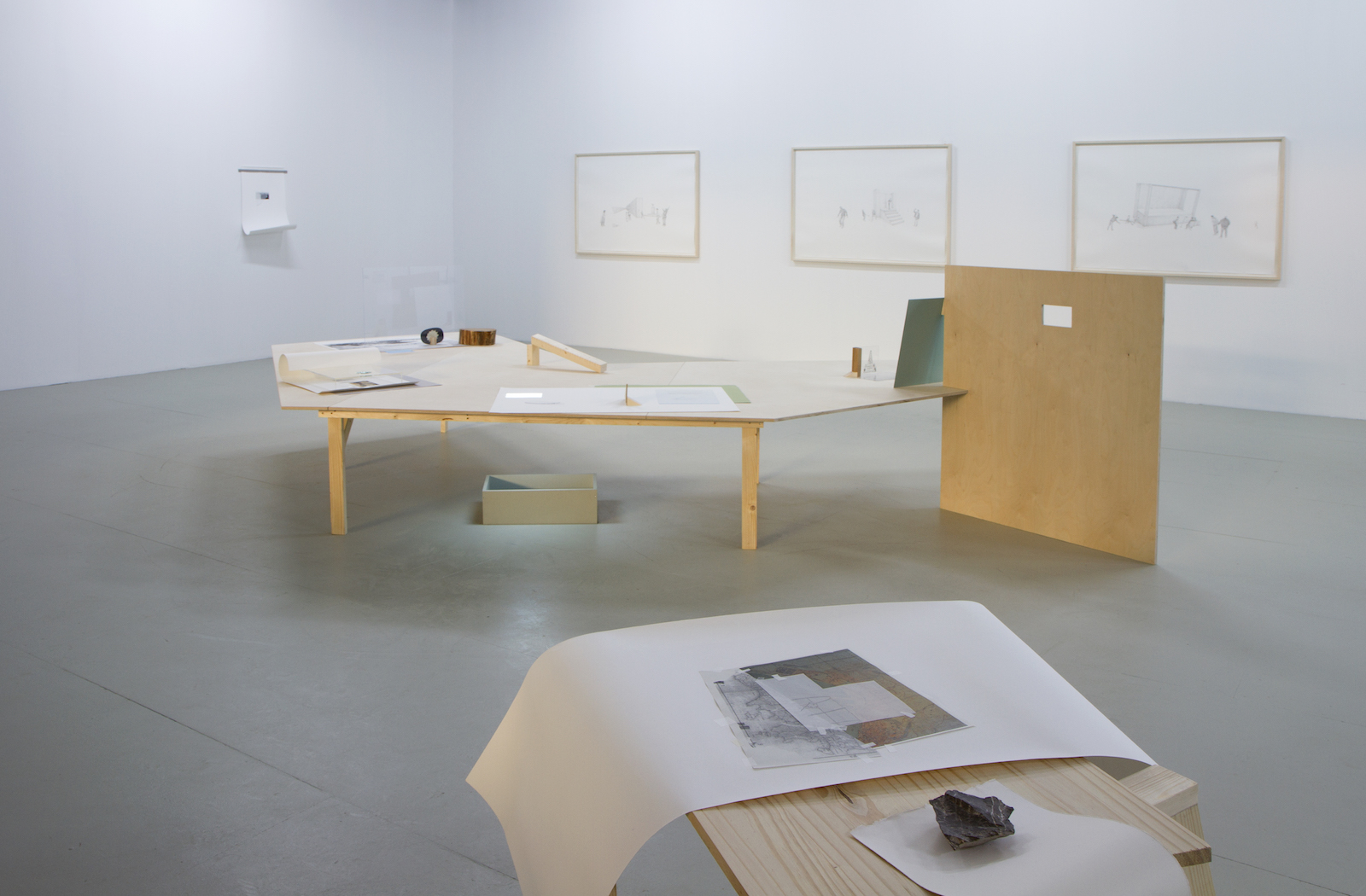
Various sizes
Dans quel sens traverser les antipodes est une installation inspirée du parcours de la figure anarchiste Louise Michel, qui, suite à sa déportation en Nouvelle-Calédonie après la défaite de la Commune de Paris, noua des relations avec les Kanaks dont elle soutint la révolte. Peu de temps après, elle entreprit un voyage en Algérie pour rendre visite aux bagnards qu'elle avait rencontré plus tôt, et y donna de nombreuses conférences. En investissant l'espace et en débordant de la page, Massinissa Selmani poursuit un travail d'expérimentation autour du dessin, mêlant une approche documentaire à des constructions fictionnelles.
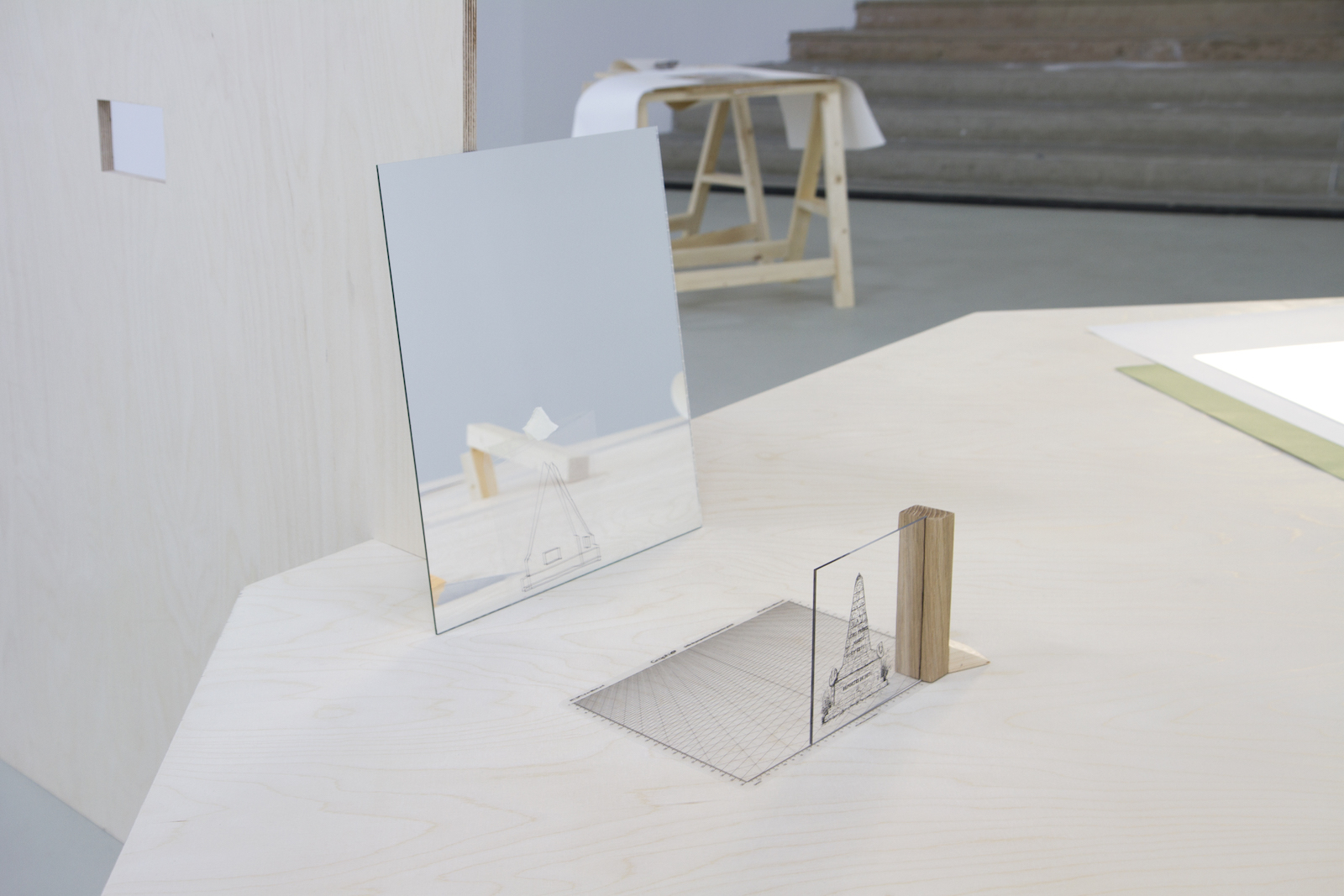
Various sizes
Dans quel sens traverser les antipodes est une installation inspirée du parcours de la figure anarchiste Louise Michel, qui, suite à sa déportation en Nouvelle-Calédonie après la défaite de la Commune de Paris, noua des relations avec les Kanaks dont elle soutint la révolte. Peu de temps après, elle entreprit un voyage en Algérie pour rendre visite aux bagnards qu'elle avait rencontré plus tôt, et y donna de nombreuses conférences. En investissant l'espace et en débordant de la page, Massinissa Selmani poursuit un travail d'expérimentation autour du dessin, mêlant une approche documentaire à des constructions fictionnelles.
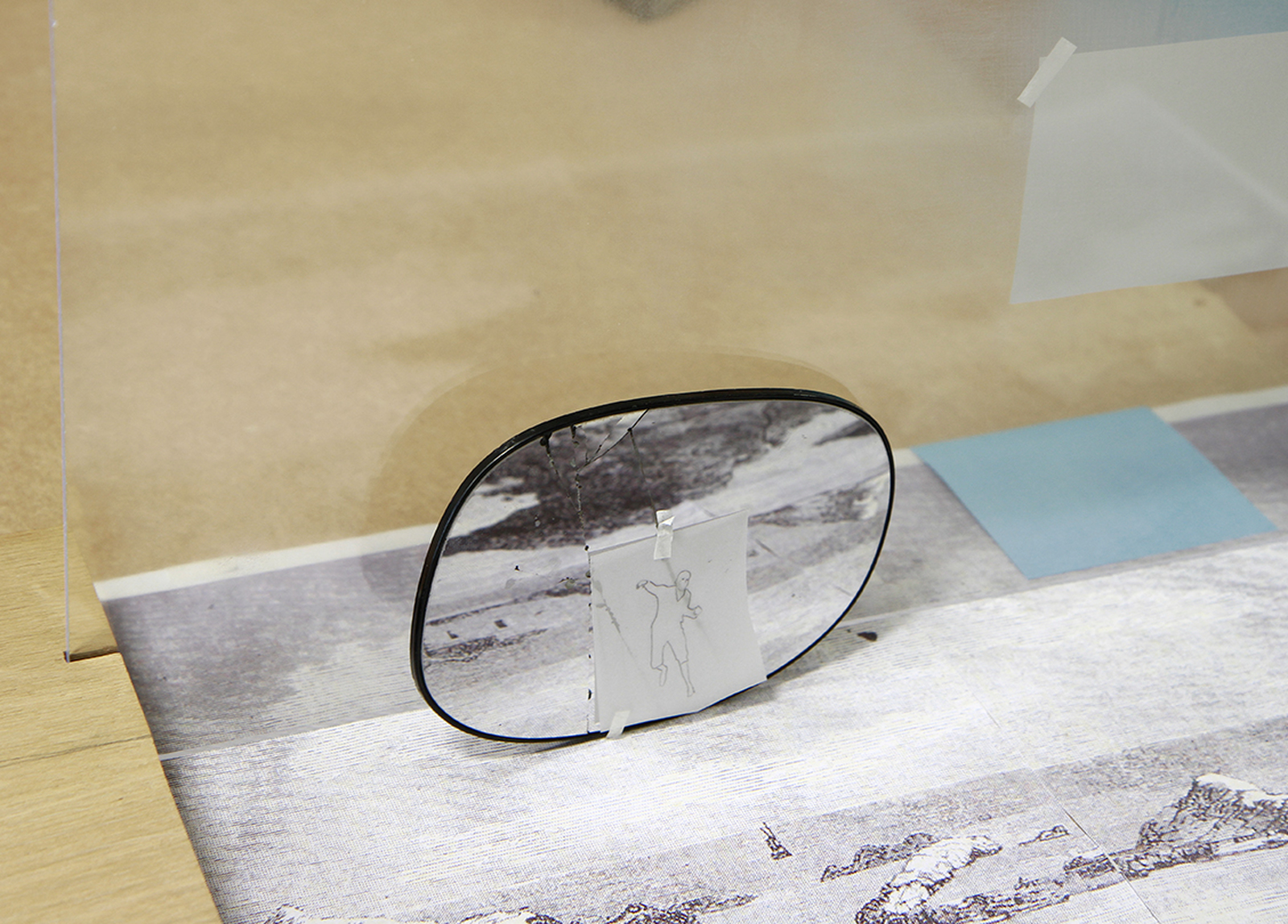
Various sizes
Dans quel sens traverser les antipodes est une installation inspirée du parcours de la figure anarchiste Louise Michel, qui, suite à sa déportation en Nouvelle-Calédonie après la défaite de la Commune de Paris, noua des relations avec les Kanaks dont elle soutint la révolte. Peu de temps après, elle entreprit un voyage en Algérie pour rendre visite aux bagnards qu'elle avait rencontré plus tôt, et y donna de nombreuses conférences. En investissant l'espace et en débordant de la page, Massinissa Selmani poursuit un travail d'expérimentation autour du dessin, mêlant une approche documentaire à des constructions fictionnelles.
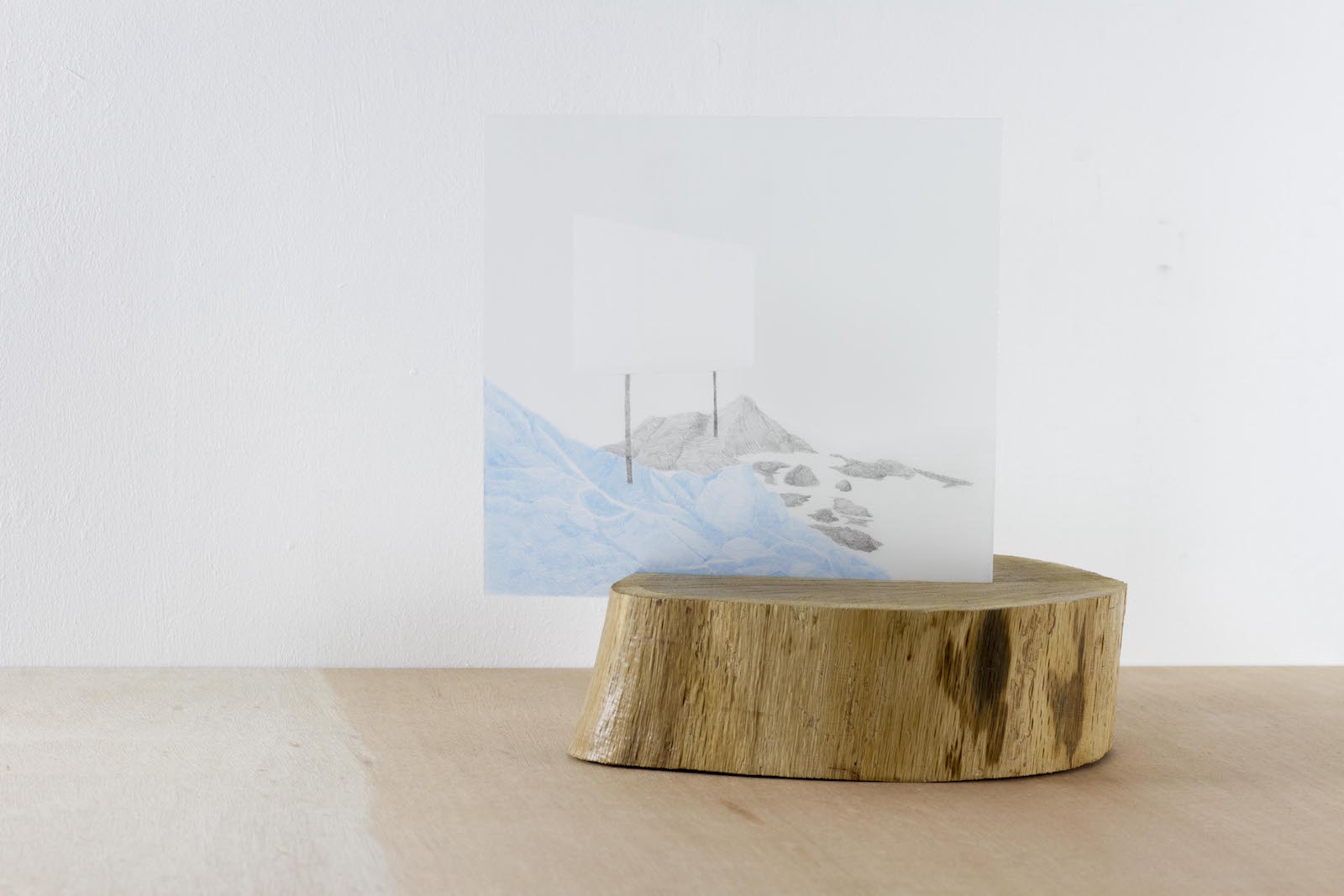
perspex: 9,8 x 10,2 inch
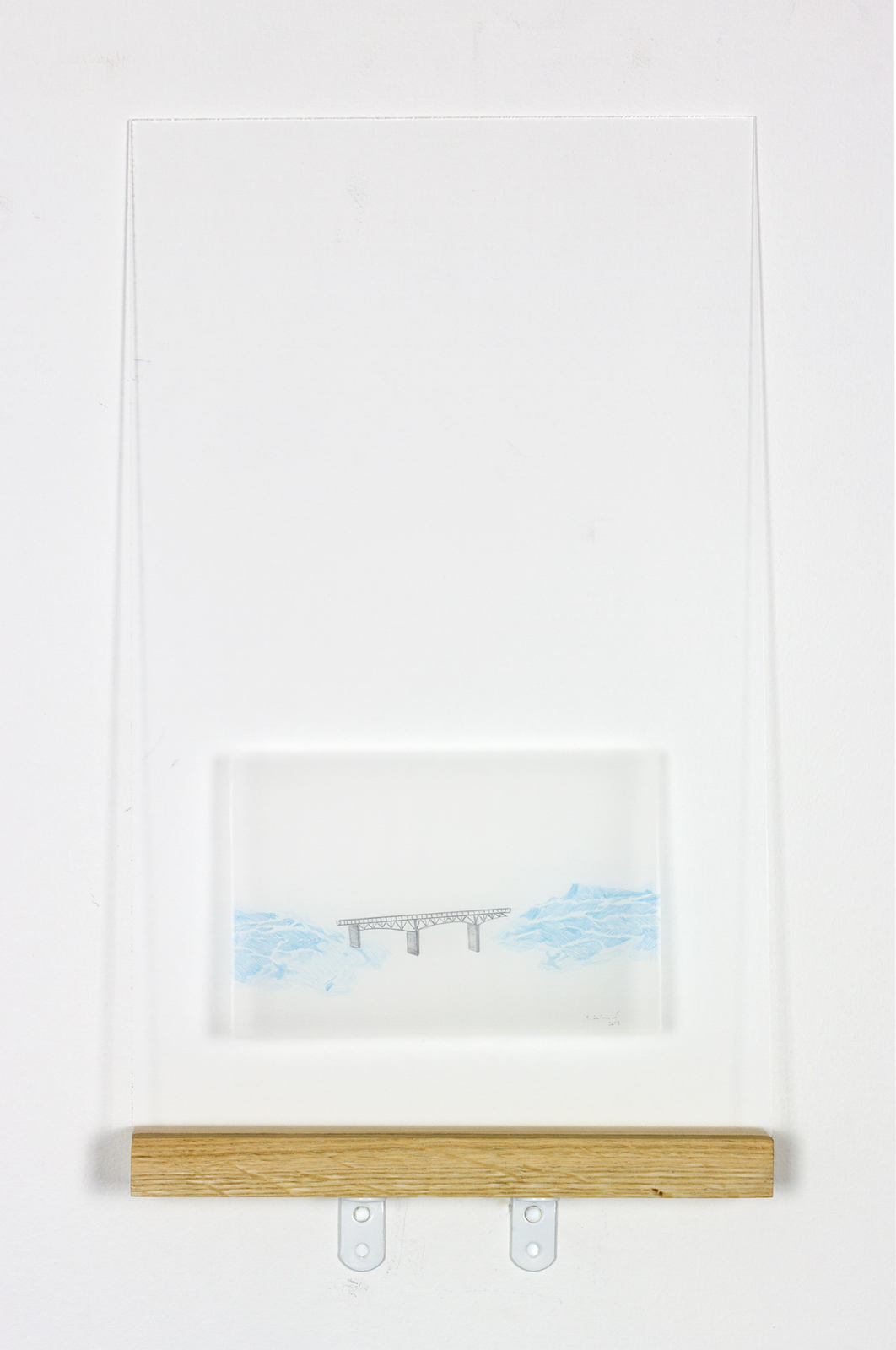
14 x 8,6 inch
Exhibitions :
- Solo Show, Le calme de l'Idée fixe, CCC OD, Tours, France, 2019
- Solo show, Disegni, Artissima, Turin, Italy, 2018
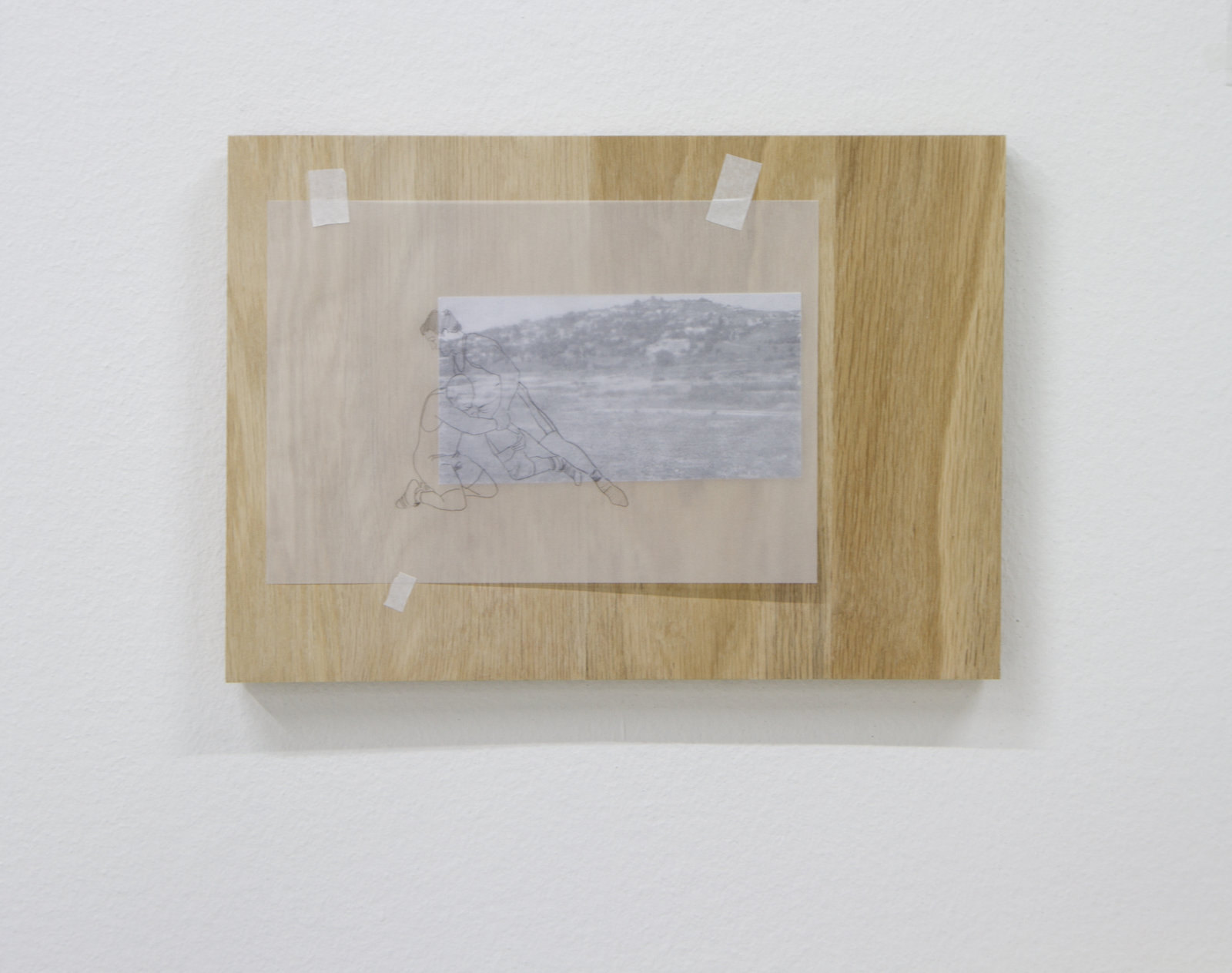
Oak, graphite on tracing paper, printed paper on cardboard
11,8 x 16,5 x 0,8 inch
Altérables is a project that consists of forming a series of images in the same process: images recovered from the printed press are photocopied and then retouched using one or more layers of transparent tracing paper, on each layer a drawing comes Duplicate, move or add an element, contour, etc. Present in the original image. The image thus modified is then scanned and put into another context and another medium undergoing the alterations due to the different transformation steps.
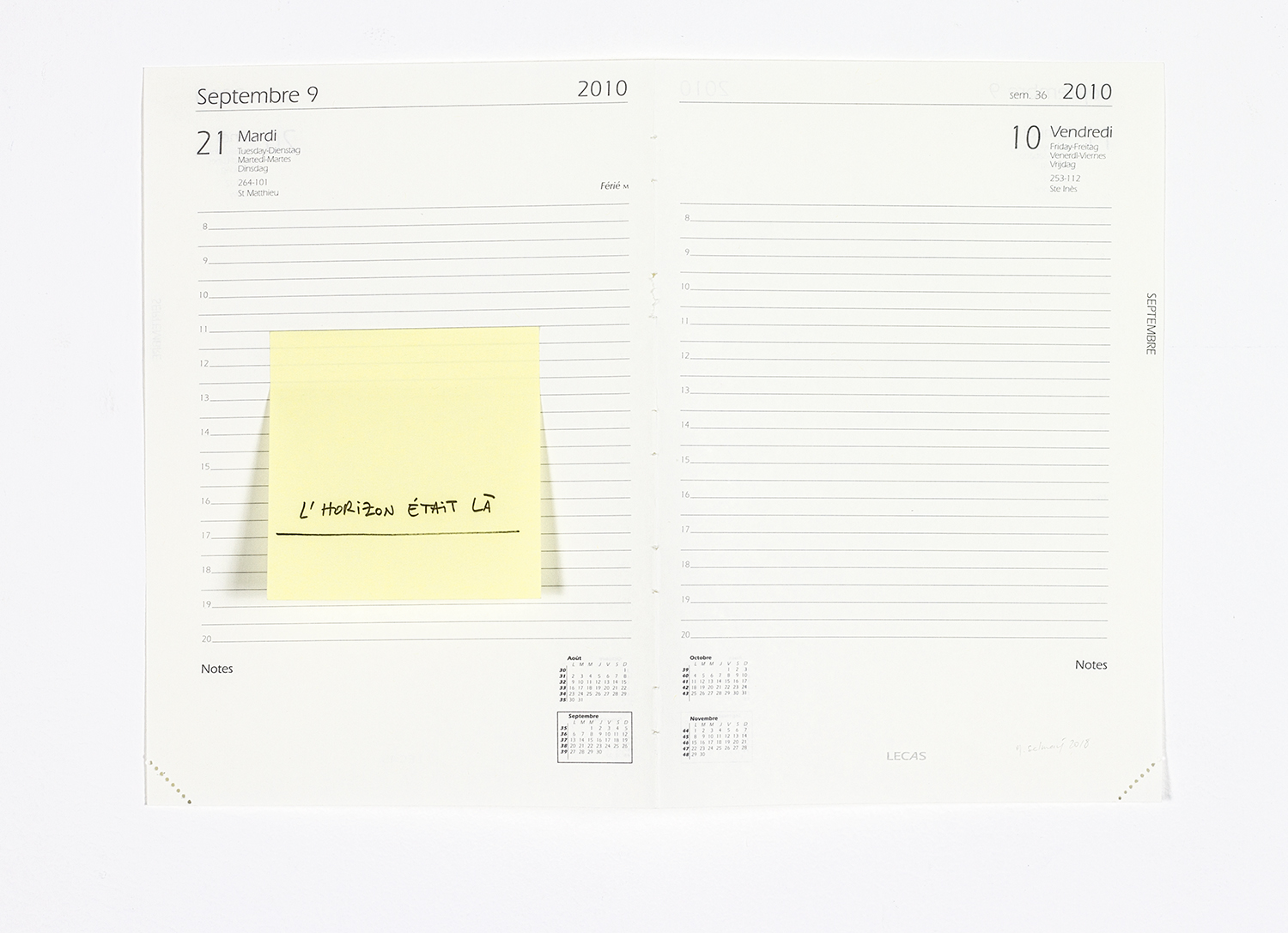
8,2 x 11,3 inch
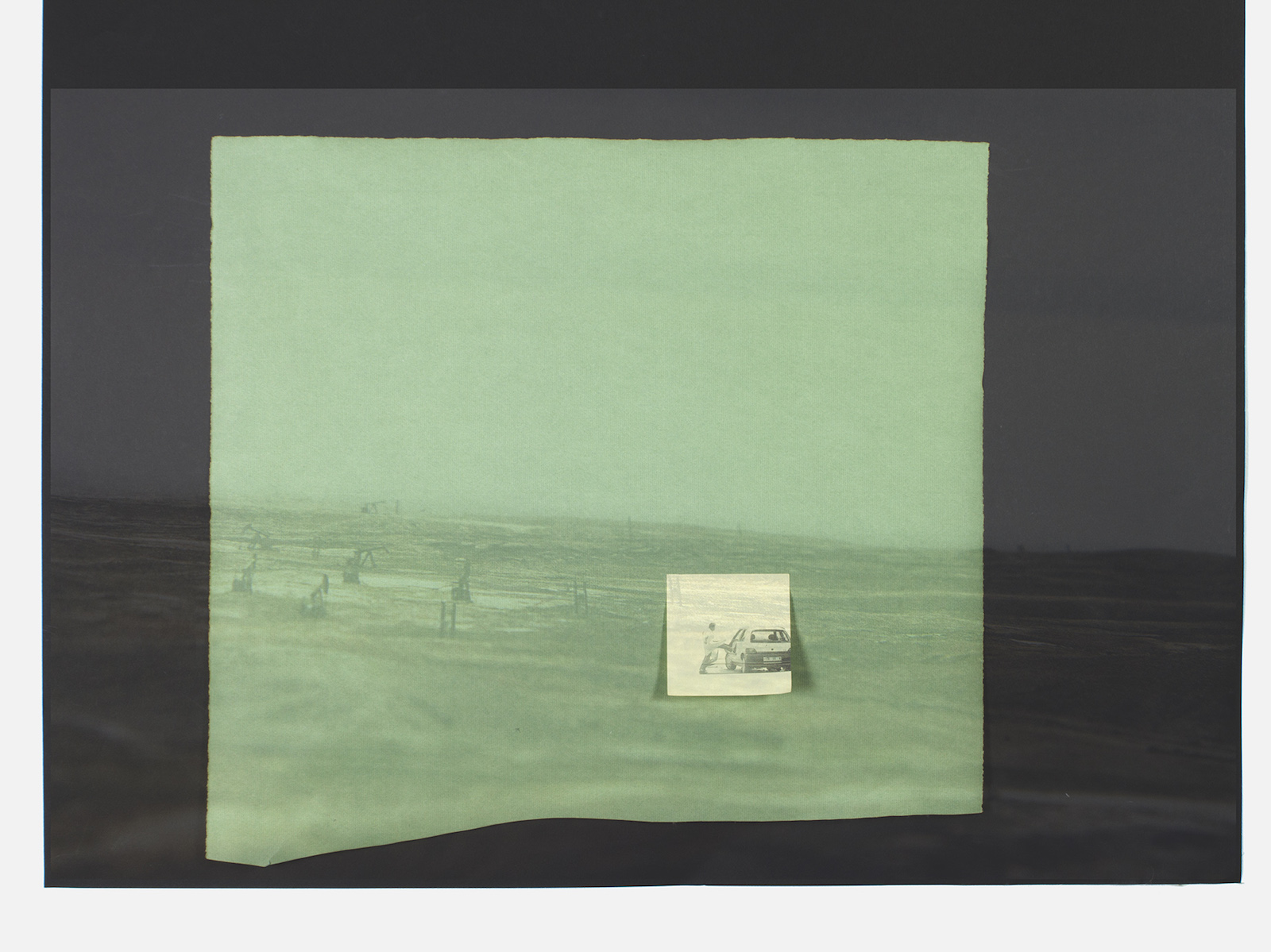
Various sizes
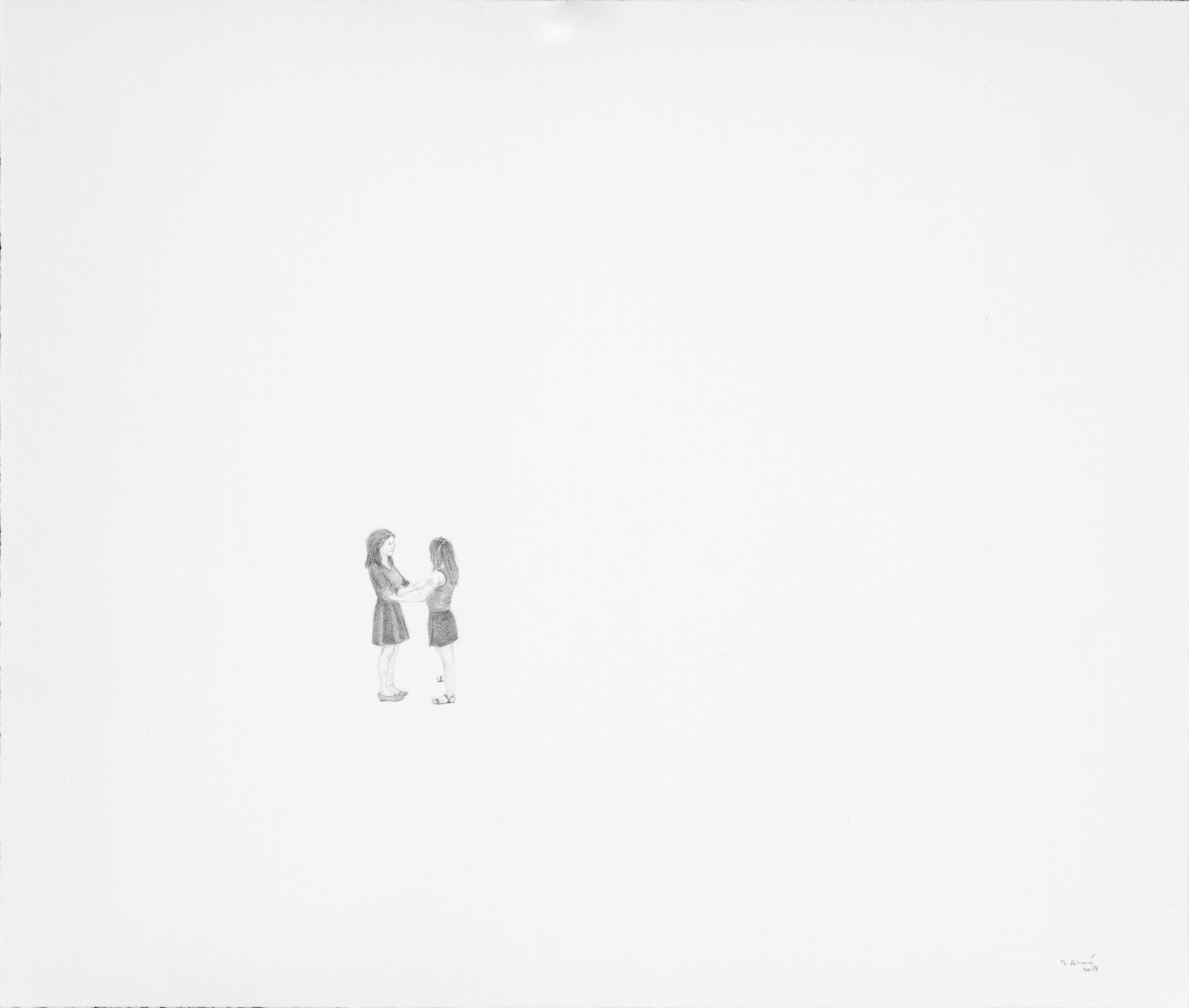
30 x 35,5 cm
Massinissa Selmani's drawings are inspired by political news, especially from cut-outs of the press that he has been collecting for many years. By confronting and juxtaposing these elements without logical coherence, the artist creates enigmatic and ambiguous scenes, underlining the ironic, even tragic character of the absurd and strange situations represented in his drawings.
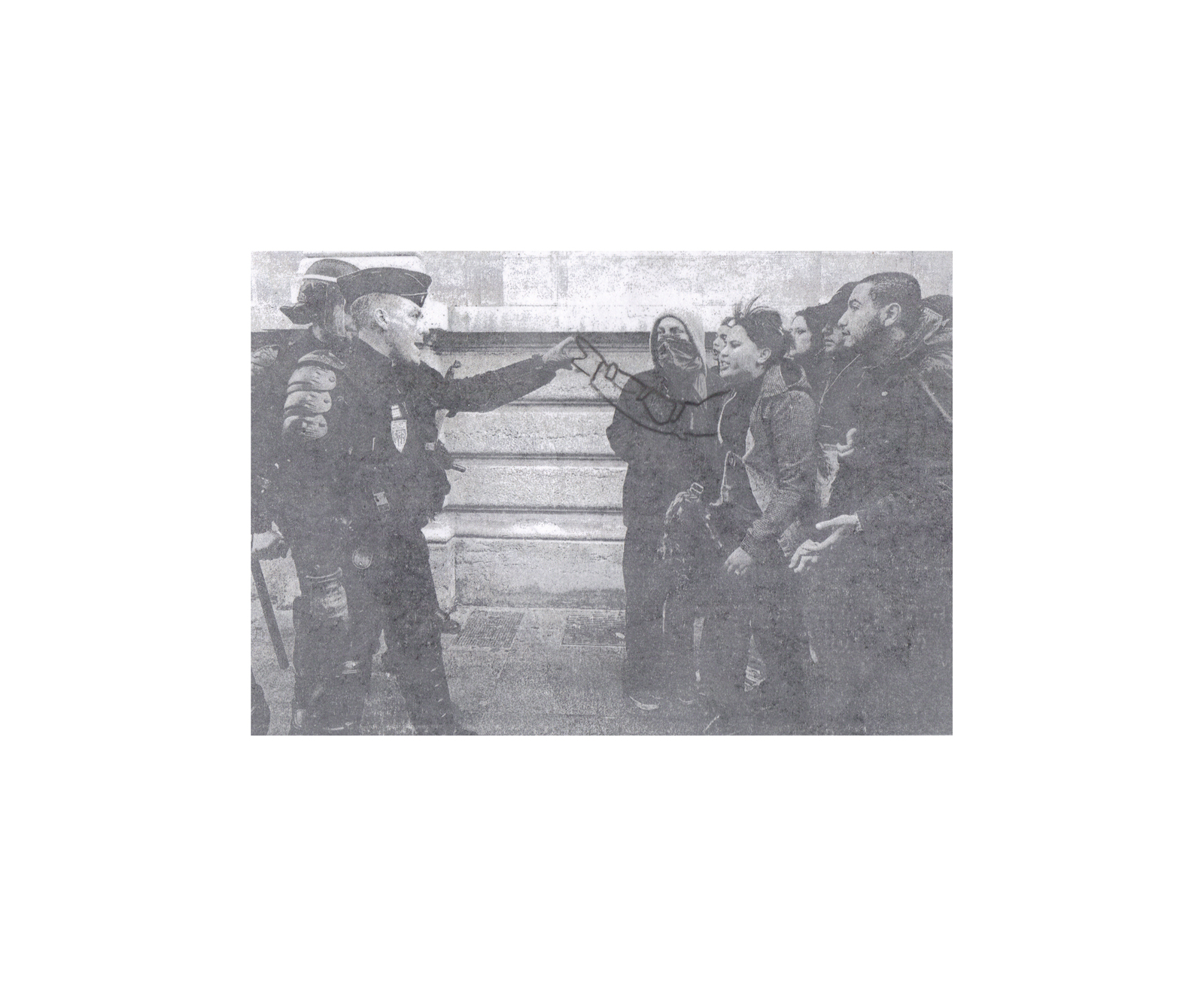
Photocopy, graphite on tracing paper
3,5 x 5,7 inch
Altérables is a project that consists of forming a series of images in the same process: images recovered from the printed press are photocopied and then retouched using one or more layers of transparent tracing paper, on each layer a drawing comes Duplicate, move or add an element, contour, etc. Present in the original image. The image thus modified is then scanned and put into another context and another medium undergoing the alterations due to the different transformation steps.
Exhibition:
- Ce qui coule n'a pas de fin, Palais de Tokyo, February, curator Yoann Gourmel, 16 - May, 13th 2018, Paris, France
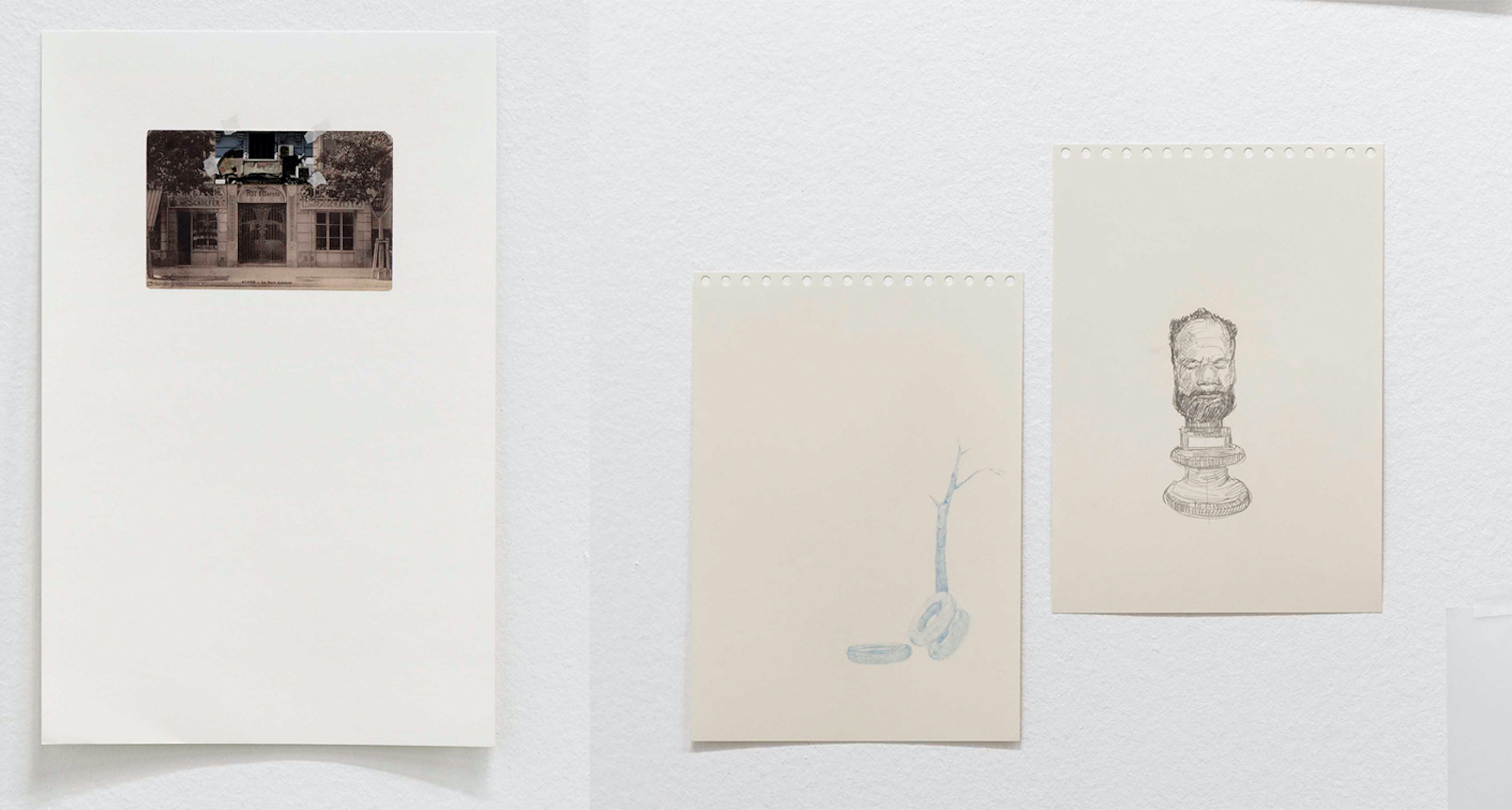
Drawings: 11,6 x 7,8 inch each/ pigment print: 19,6 x 12,5 inch
Sans titre #2 (Un jour sans ombre) est un ensemble de dessins, carte postale et collage réalisé par Massinissa Selmani alors qu'il s'était rendu sur les traces de Louise Michel en Algérie et en Nouvelle-Calédonie. Il s'agit ici d'une ancienne carte postale montrant l'ancien théâtre Athénée à Alger où la figure anarchiste avait donné une conférence en 1904. Si le théâtre n'existe plus, il reste une partie de la façade que l'artiste a photographié et collé sur l'ancienne carte postale, l'accompagnant de dessins mêlant références historiques et univers flottants.
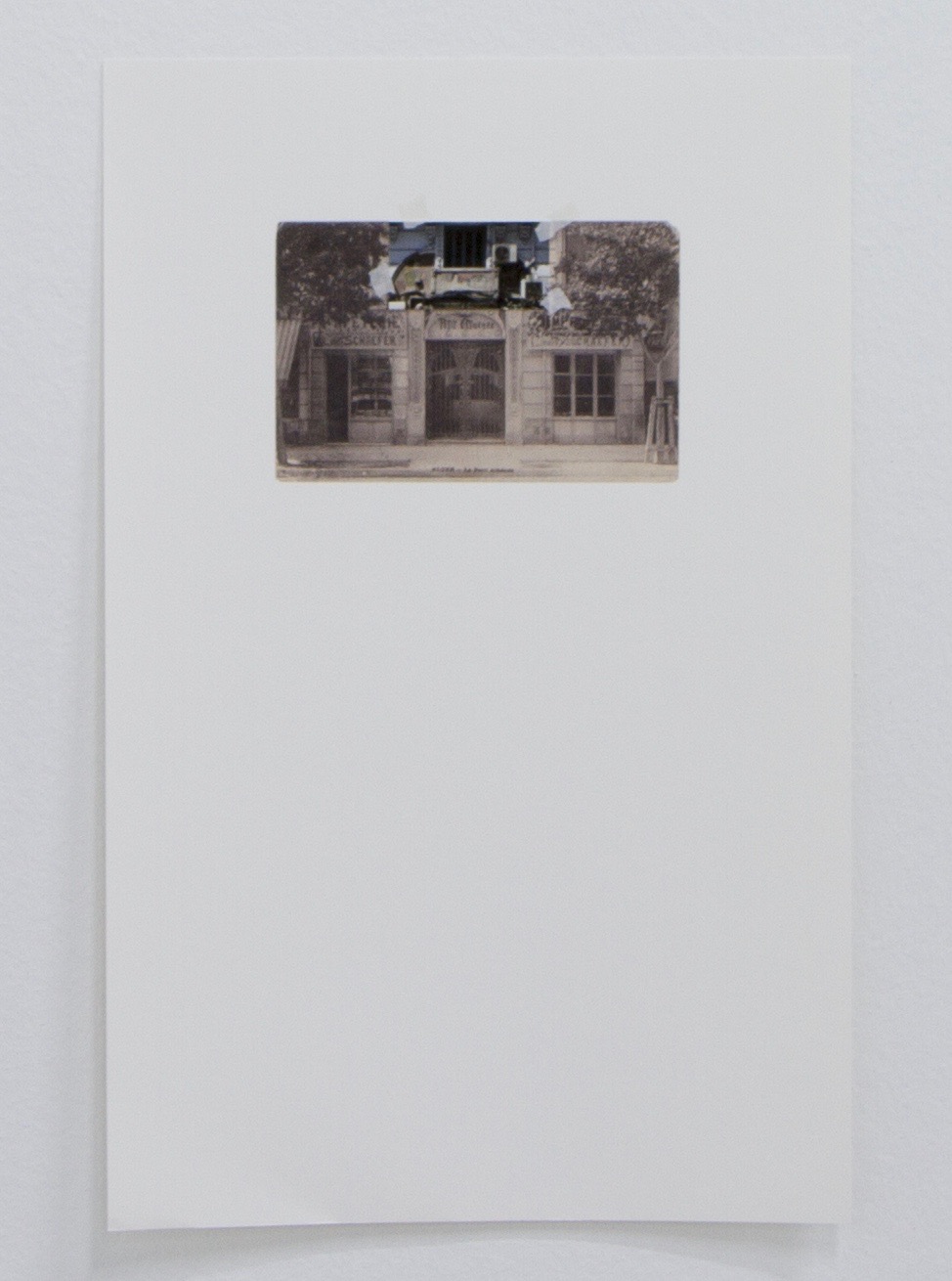
Drawings: 11,6 x 7,8 inch each/ pigment print: 19,6 x 12,5 inch
Sans titre #2 (Un jour sans ombre) est un ensemble de dessins, carte postale et collage réalisé par Massinissa Selmani alors qu'il s'était rendu sur les traces de Louise Michel en Algérie et en Nouvelle-Calédonie. Il s'agit ici d'une ancienne carte postale montrant l'ancien théâtre Athénée à Alger où la figure anarchiste avait donné une conférence en 1904. Si le théâtre n'existe plus, il reste une partie de la façade que l'artiste a photographié et collé sur l'ancienne carte postale, l'accompagnant de dessins mêlant références historiques et univers flottants.
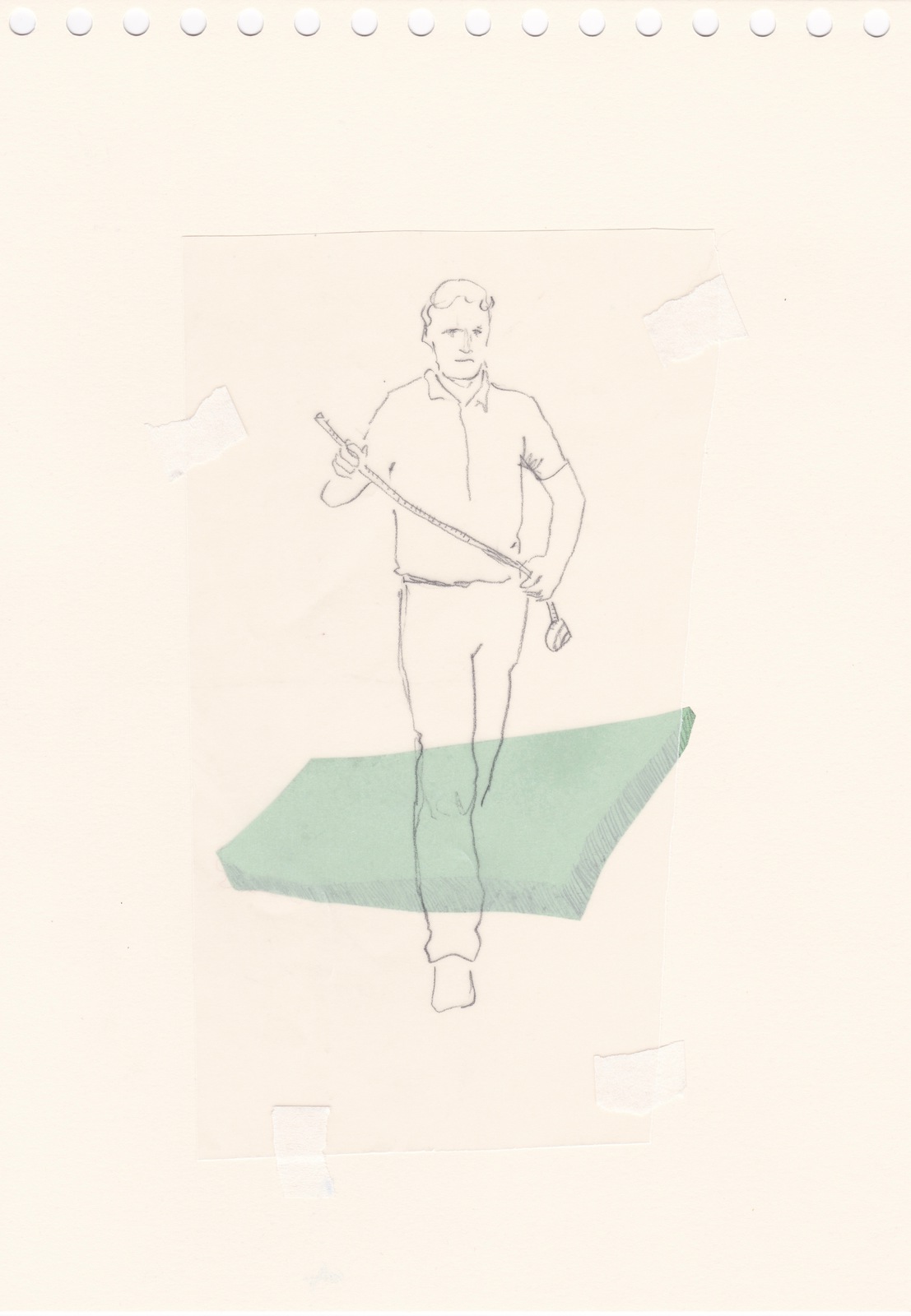
11,6 x 7,8 inch
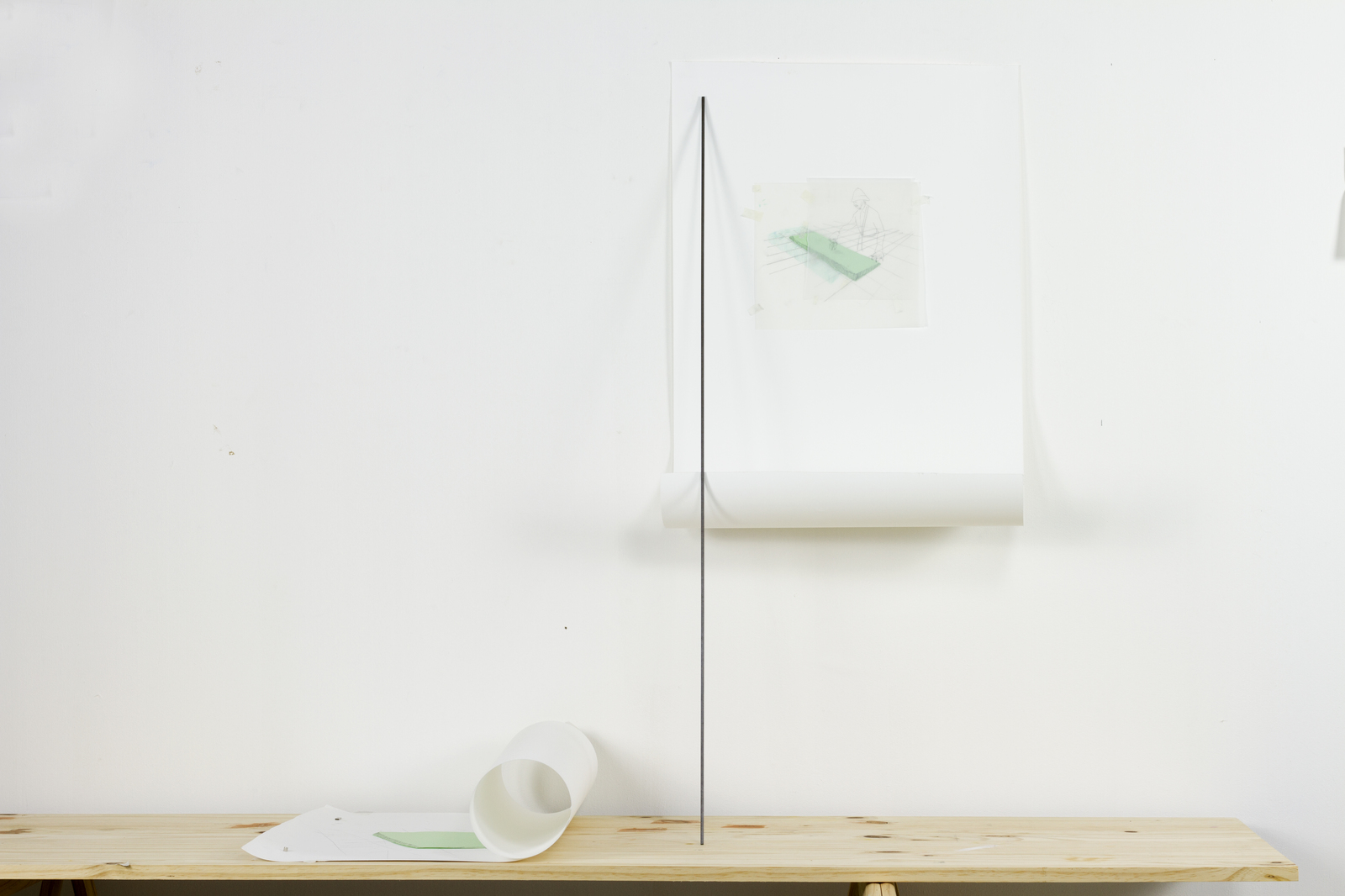
Various sizes
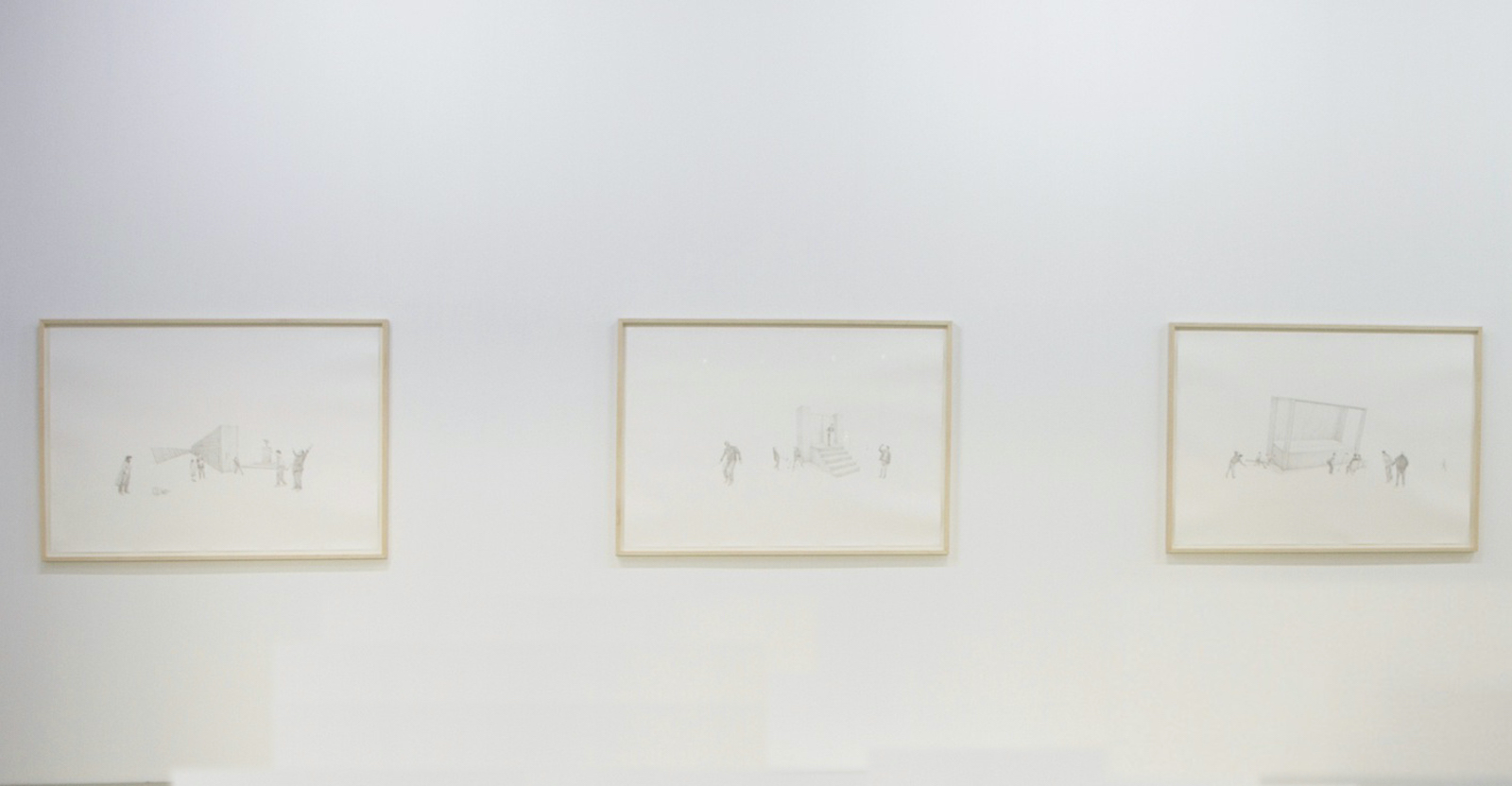
100 x 140 cm each
Signed and dated lower left
Ces trois dessins ont été pensés comme de « fausses » peintures d'histoire, axés sur l'idée du discours et d'enregistrement. Ils comprennent des mises en scènes évoquant des attitudes familières.
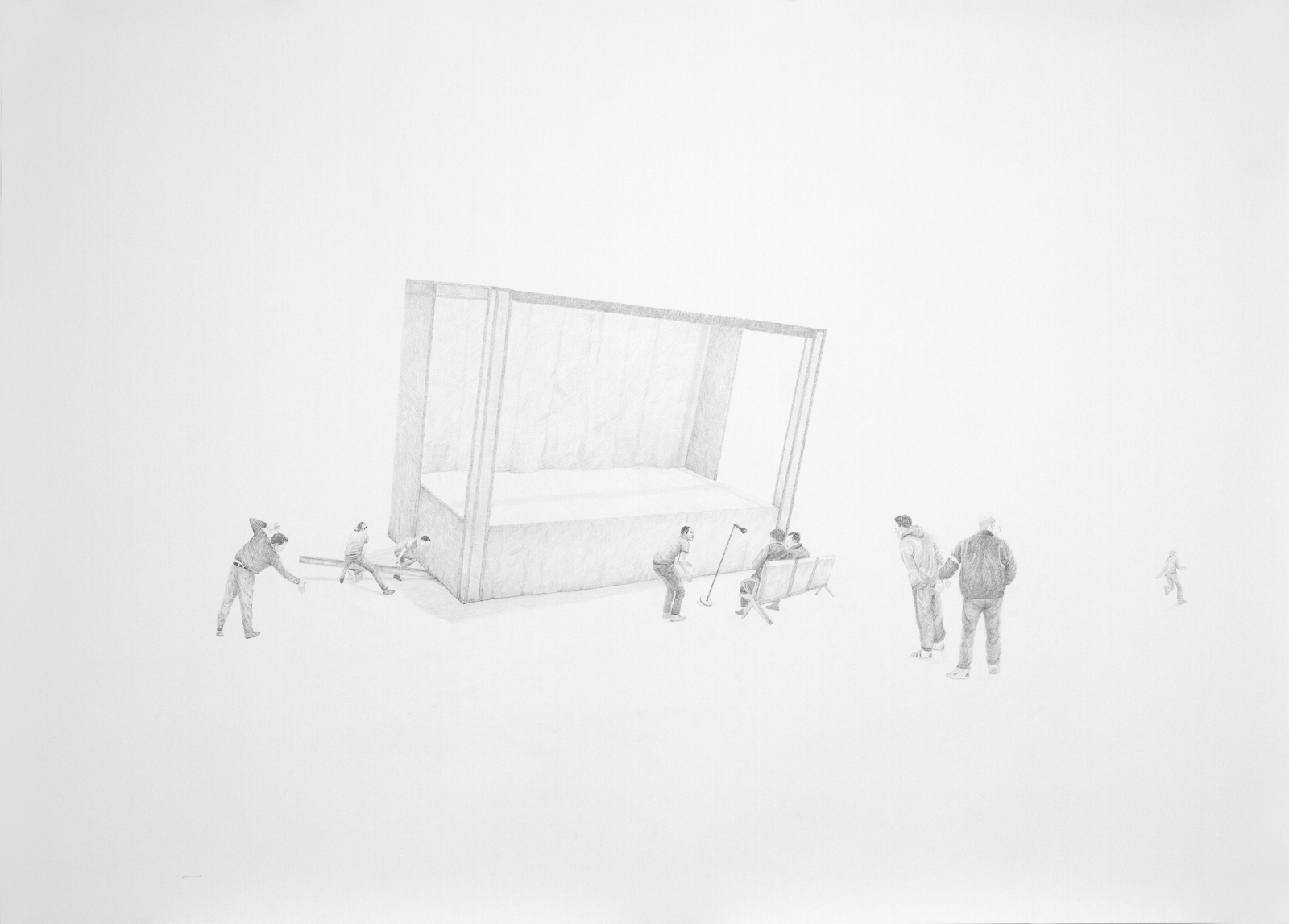
100 x 140 cm each
Signed and dated lower left
Ces trois dessins ont été pensés comme de « fausses » peintures d'histoire, axés sur l'idée du discours et d'enregistrement. Ils comprennent des mises en scènes évoquant des attitudes familières.
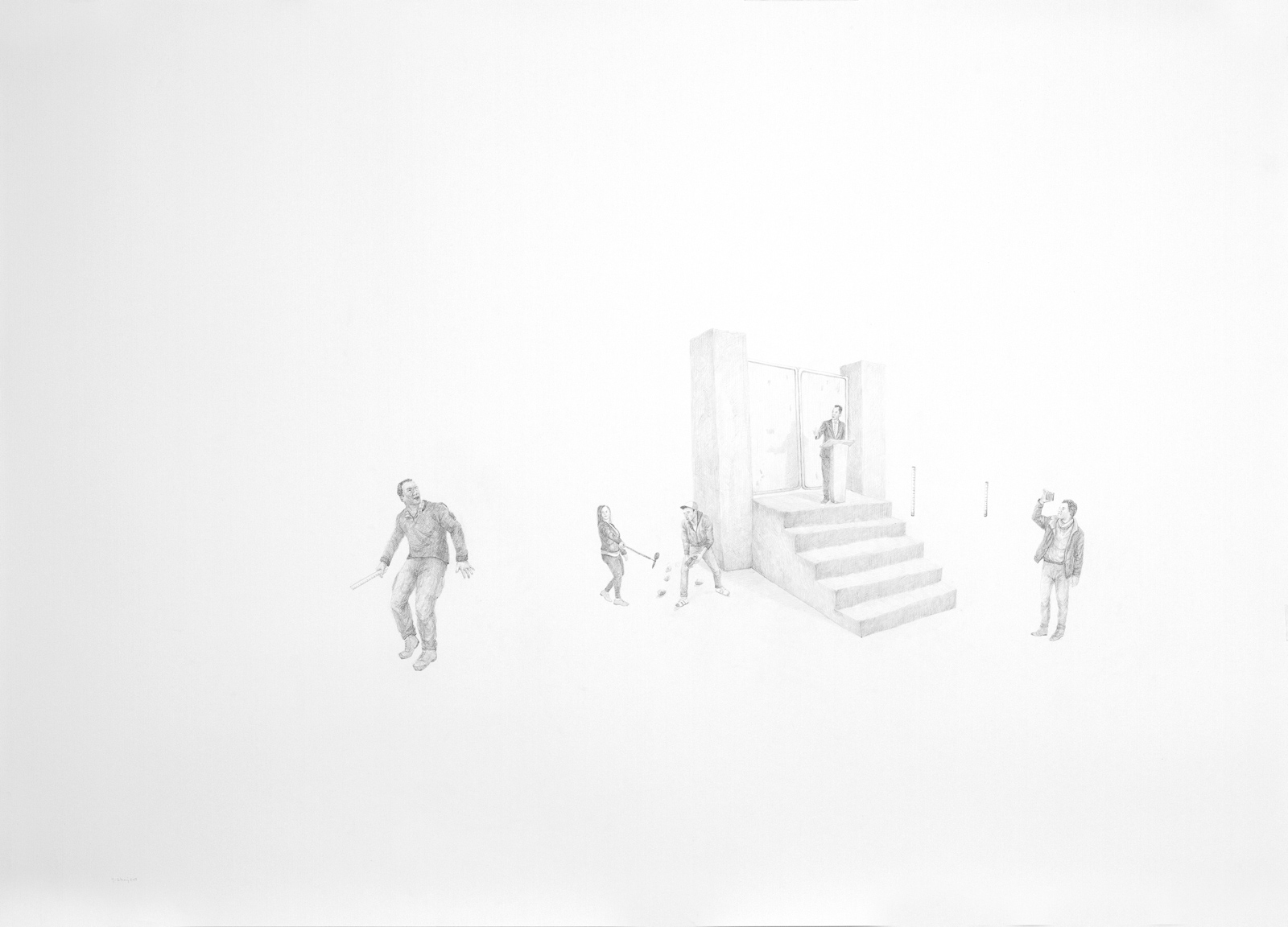
100 x 140 cm each
Signed and dated lower left
Ces trois dessins ont été pensés comme de « fausses » peintures d'histoire, axés sur l'idée du discours et d'enregistrement. Ils comprennent des mises en scènes évoquant des attitudes familières.
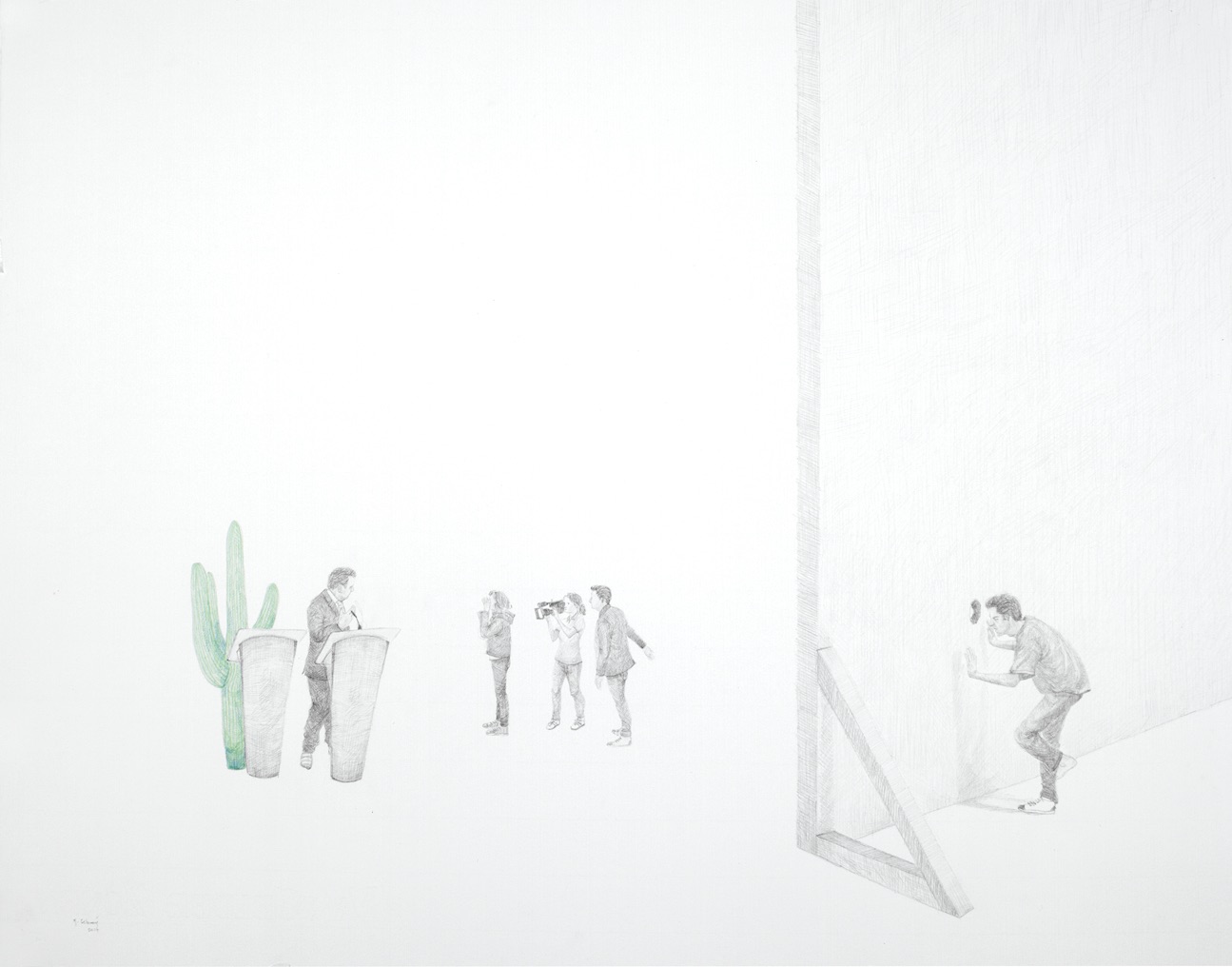
Graphite and color lead on paper
19 x 25 inches
Promesses series highlights the ironic, and sometimes tragical nature of absurd and strange situations, that are represented in this drawings. All the scenes are artificially created with scenery and characters extracted from press cuttings. By their juxtaposition, without any logical coherence, emerges sort of strangeness and incongruity. In this drawings Massinissa Selmani plays with the boundary between tragic and comical, real and unreal.
Exhibition:
- Les choses que vous faites m'entourent, Galerie Anne-Sarah Bénichou, Paris, France du 2nd September- 22nd October 2017
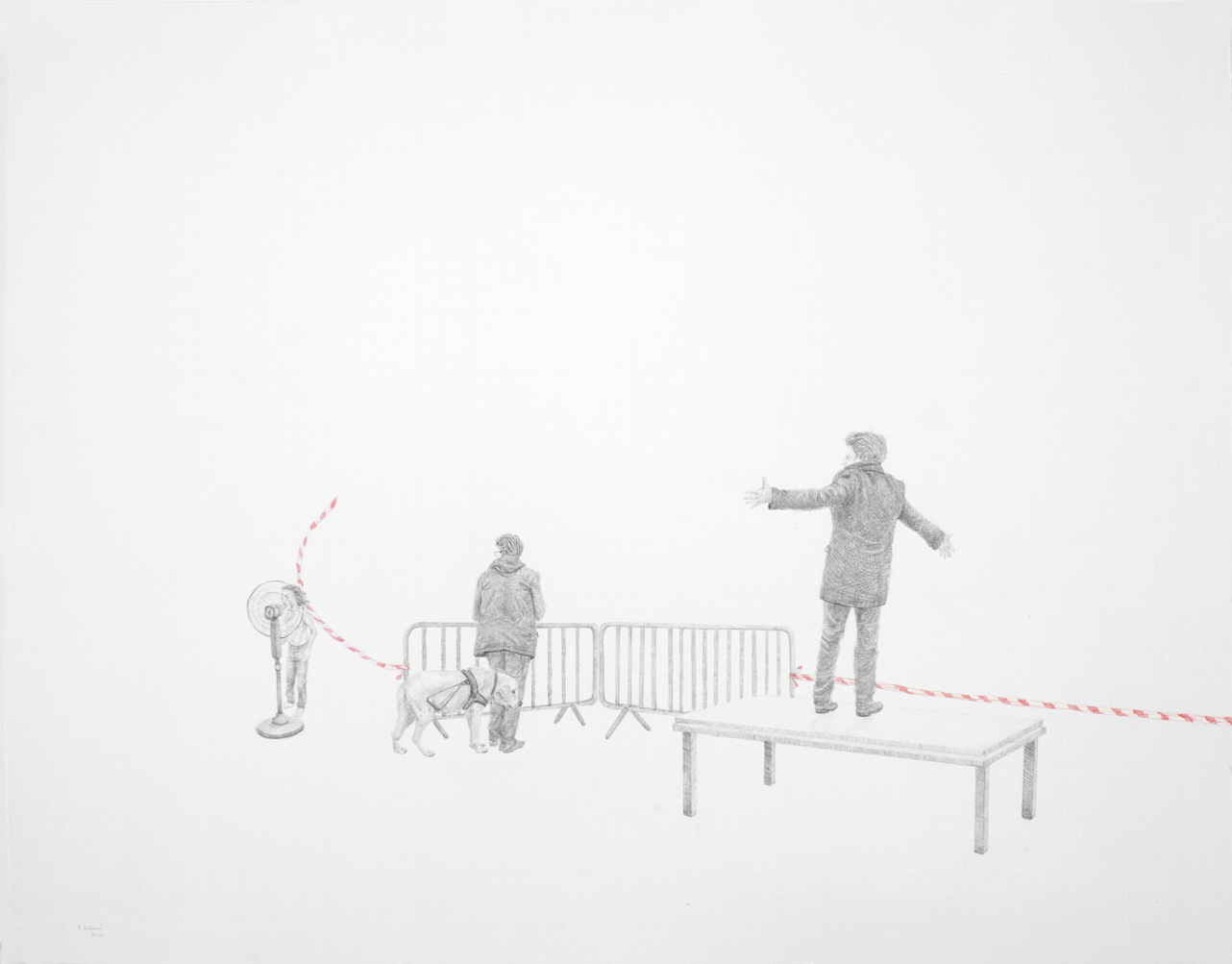
Graphite and color lead on paper
19 x 25 inches
Signed and dated lower left
Promesses series highlights the ironic, and sometimes tragical nature of absurd and strange situations, that are represented in this drawings. All the scenes are artificially created with scenery and characters extracted from press cuttings. By their juxtaposition, without any logical coherence, emerges sort of strangeness and incongruity. In this drawings Massinissa Selmani plays with the boundary between tragic and comical, real and unreal.
Exhibition:
- Les choses que vous faites m'entourent, Galerie Anne-Sarah Bénichou, Paris, France du 2nd September- 22nd October 2017
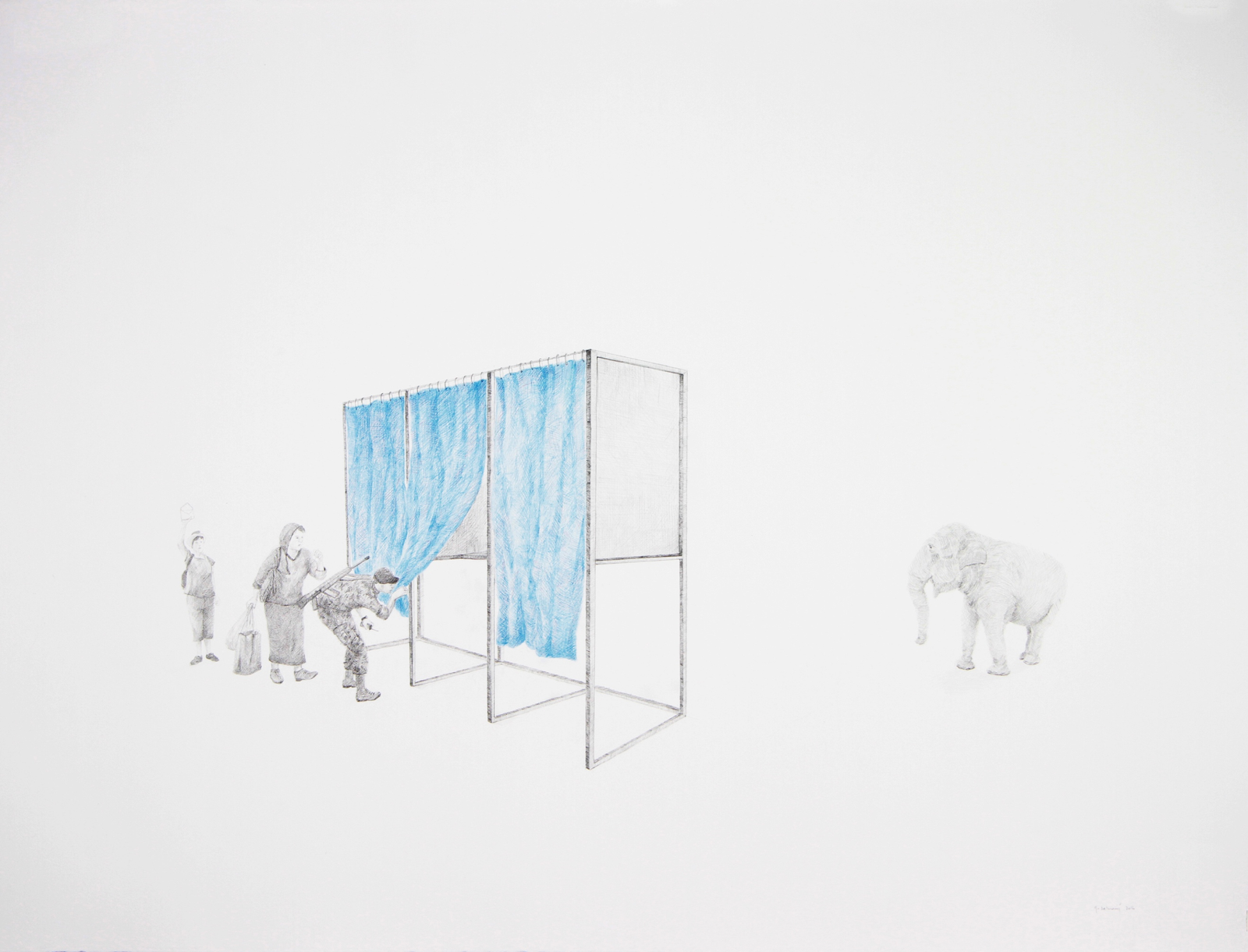
Graphite and colour pencil on paper (framed)
23 x 30 inches
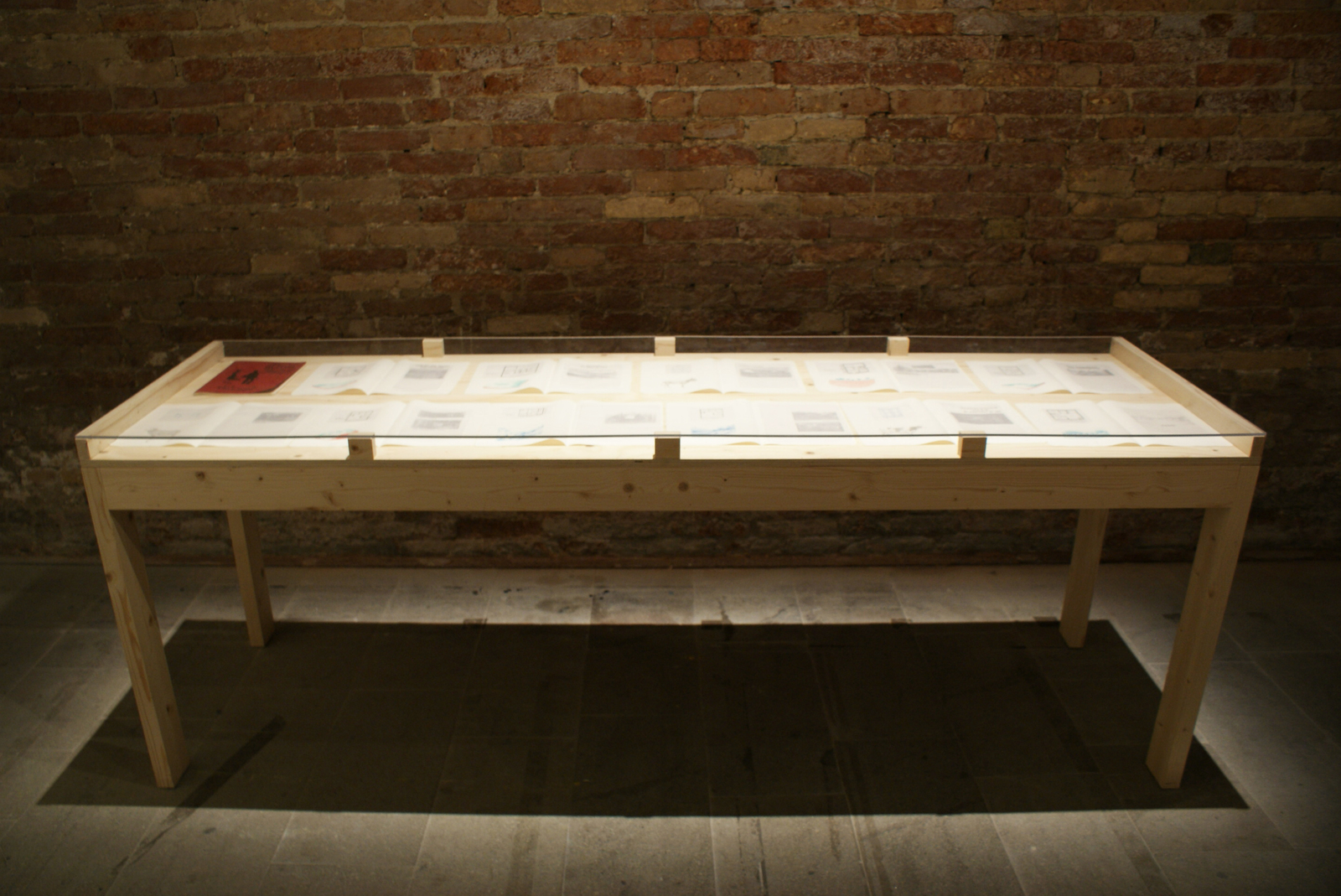
Variables dimensions
© Amel Boudebbouze
Collection Frac Centre
Au début des années 70, fut lancée en Algérie la construction de 1000 villages socialistes dans le but de sortir de l'isolement et de la précarité, la population rurale, de lui rendre ses terres spoliées durant la colonisation, de la mener vers une agriculture moderne et de l'impliquer dans le projet révolutionnaire algérien, notamment à travers la révolution agraire.
Malgré l'intention louable du départ, le projet n'a pu être concrétisé en sa totalité, car bien souvent l'implantation et l'édification de ces villages, à quelques rares exceptions près, se sont heurtées à des considérations idéologiques ou administratives imposant des normes à reproduire au détriment des réels besoins des paysans. La population concernée s'est progressivement désintéressée du projet qui fut arrêté quelques années plus tard.
L'oeuvre ici présentée est la première étape du projet intitulé 1000 Villages. Les dessins sont organisés suivant une logique narrative basée sur des confrontations d'éléments : plans de maison, meubles dessinés sur papier calque ; dessins d'espaces, de terres agricoles et d'animaux. Les images reproduites au transfert proviennent de copies de coupures de presse de l'époque. De plus en plus illisibles au fur et à mesure qu'on approche de l'effondrement de l'utopie, jusqu'à la dernière image quasi fantomatique. La seule lecture des reproductions provient de la légende imprimée sur un papier calque qui restitue l'espace mental d'un article de presse.
En marge de ces dessins, un autre a été réalisé sur la couverture d'un cahier inspiré de cahiers vendus durant les années 70-80 en Algérie, faisant la promotion de la révolution agraire et industrielle algérienne.
Oeuvre Présentée pour la première fois durant la biennale de Venise 2015.
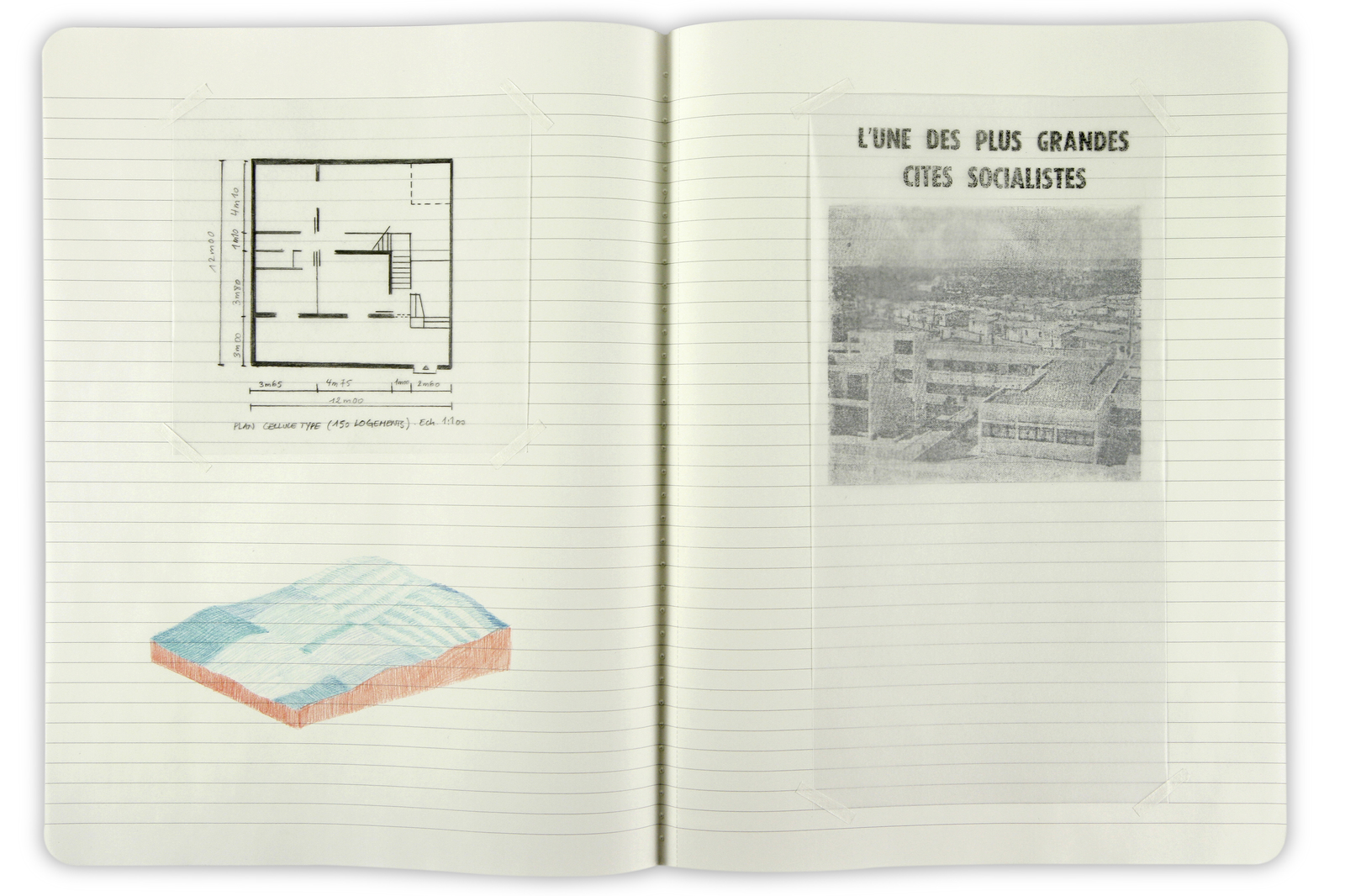
Variables dimensions
© Amel Boudebbouze
Collection Frac Centre
Au début des années 70, fut lancée en Algérie la construction de 1000 villages socialistes dans le but de sortir de l'isolement et de la précarité, la population rurale, de lui rendre ses terres spoliées durant la colonisation, de la mener vers une agriculture moderne et de l'impliquer dans le projet révolutionnaire algérien, notamment à travers la révolution agraire.
Malgré l'intention louable du départ, le projet n'a pu être concrétisé en sa totalité, car bien souvent l'implantation et l'édification de ces villages, à quelques rares exceptions près, se sont heurtées à des considérations idéologiques ou administratives imposant des normes à reproduire au détriment des réels besoins des paysans. La population concernée s'est progressivement désintéressée du projet qui fut arrêté quelques années plus tard.
L'oeuvre ici présentée est la première étape du projet intitulé 1000 Villages. Les dessins sont organisés suivant une logique narrative basée sur des confrontations d'éléments : plans de maison, meubles dessinés sur papier calque ; dessins d'espaces, de terres agricoles et d'animaux. Les images reproduites au transfert proviennent de copies de coupures de presse de l'époque. De plus en plus illisibles au fur et à mesure qu'on approche de l'effondrement de l'utopie, jusqu'à la dernière image quasi fantomatique. La seule lecture des reproductions provient de la légende imprimée sur un papier calque qui restitue l'espace mental d'un article de presse.
En marge de ces dessins, un autre a été réalisé sur la couverture d'un cahier inspiré de cahiers vendus durant les années 70-80 en Algérie, faisant la promotion de la révolution agraire et industrielle algérienne.
Oeuvre Présentée pour la première fois durant la biennale de Venise 2015.
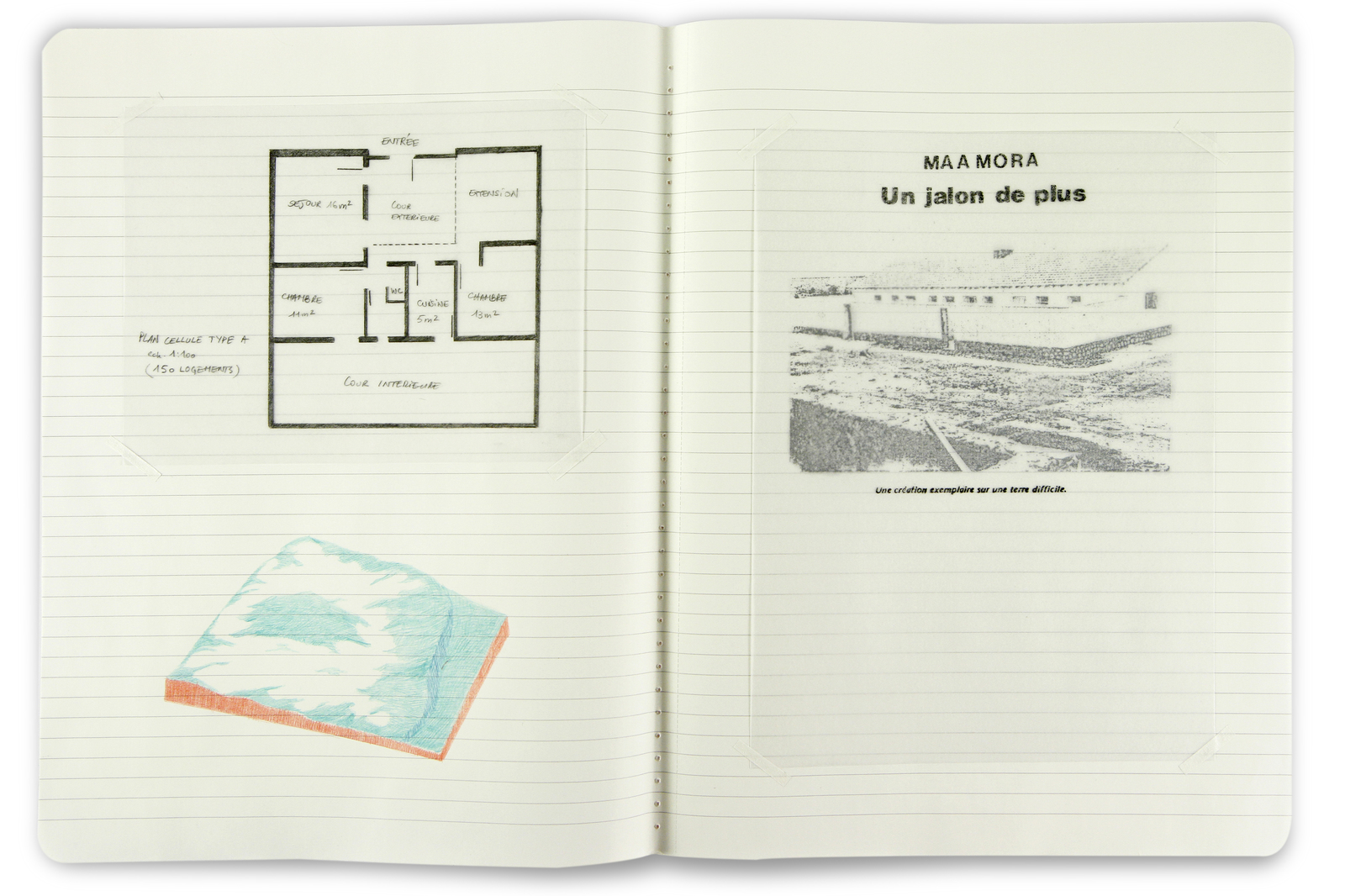
Variables dimensions
© Amel Boudebbouze
Collection Frac Centre
Au début des années 70, fut lancée en Algérie la construction de 1000 villages socialistes dans le but de sortir de l'isolement et de la précarité, la population rurale, de lui rendre ses terres spoliées durant la colonisation, de la mener vers une agriculture moderne et de l'impliquer dans le projet révolutionnaire algérien, notamment à travers la révolution agraire.
Malgré l'intention louable du départ, le projet n'a pu être concrétisé en sa totalité, car bien souvent l'implantation et l'édification de ces villages, à quelques rares exceptions près, se sont heurtées à des considérations idéologiques ou administratives imposant des normes à reproduire au détriment des réels besoins des paysans. La population concernée s'est progressivement désintéressée du projet qui fut arrêté quelques années plus tard.
L'oeuvre ici présentée est la première étape du projet intitulé 1000 Villages. Les dessins sont organisés suivant une logique narrative basée sur des confrontations d'éléments : plans de maison, meubles dessinés sur papier calque ; dessins d'espaces, de terres agricoles et d'animaux. Les images reproduites au transfert proviennent de copies de coupures de presse de l'époque. De plus en plus illisibles au fur et à mesure qu'on approche de l'effondrement de l'utopie, jusqu'à la dernière image quasi fantomatique. La seule lecture des reproductions provient de la légende imprimée sur un papier calque qui restitue l'espace mental d'un article de presse.
En marge de ces dessins, un autre a été réalisé sur la couverture d'un cahier inspiré de cahiers vendus durant les années 70-80 en Algérie, faisant la promotion de la révolution agraire et industrielle algérienne.
Oeuvre Présentée pour la première fois durant la biennale de Venise 2015.
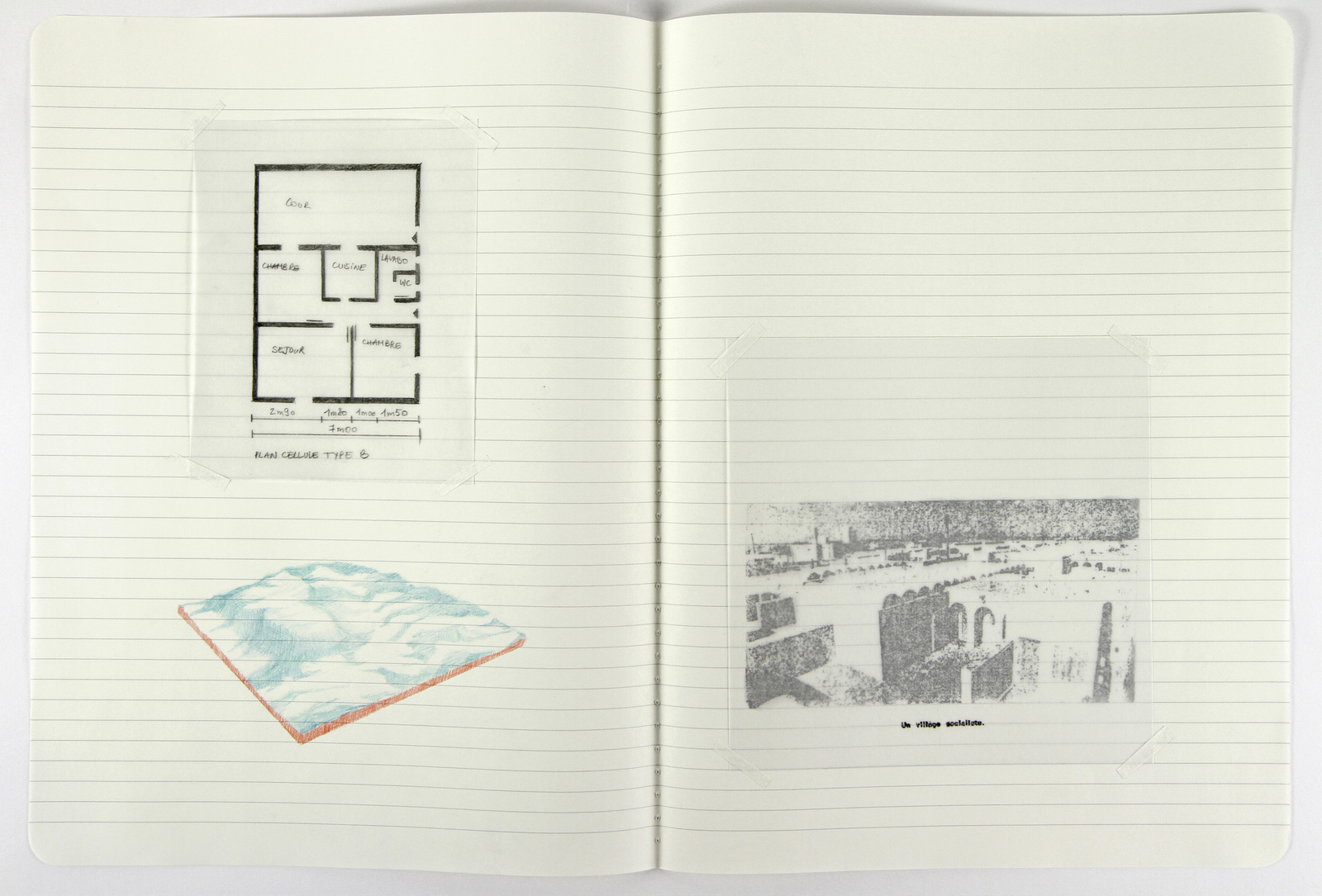
Variables dimensions
© Amel Boudebbouze
Collection Frac Centre
Au début des années 70, fut lancée en Algérie la construction de 1000 villages socialistes dans le but de sortir de l'isolement et de la précarité, la population rurale, de lui rendre ses terres spoliées durant la colonisation, de la mener vers une agriculture moderne et de l'impliquer dans le projet révolutionnaire algérien, notamment à travers la révolution agraire.
Malgré l'intention louable du départ, le projet n'a pu être concrétisé en sa totalité, car bien souvent l'implantation et l'édification de ces villages, à quelques rares exceptions près, se sont heurtées à des considérations idéologiques ou administratives imposant des normes à reproduire au détriment des réels besoins des paysans. La population concernée s'est progressivement désintéressée du projet qui fut arrêté quelques années plus tard.
L'oeuvre ici présentée est la première étape du projet intitulé 1000 Villages. Les dessins sont organisés suivant une logique narrative basée sur des confrontations d'éléments : plans de maison, meubles dessinés sur papier calque ; dessins d'espaces, de terres agricoles et d'animaux. Les images reproduites au transfert proviennent de copies de coupures de presse de l'époque. De plus en plus illisibles au fur et à mesure qu'on approche de l'effondrement de l'utopie, jusqu'à la dernière image quasi fantomatique. La seule lecture des reproductions provient de la légende imprimée sur un papier calque qui restitue l'espace mental d'un article de presse.
En marge de ces dessins, un autre a été réalisé sur la couverture d'un cahier inspiré de cahiers vendus durant les années 70-80 en Algérie, faisant la promotion de la révolution agraire et industrielle algérienne.
Oeuvre Présentée pour la première fois durant la biennale de Venise 2015.
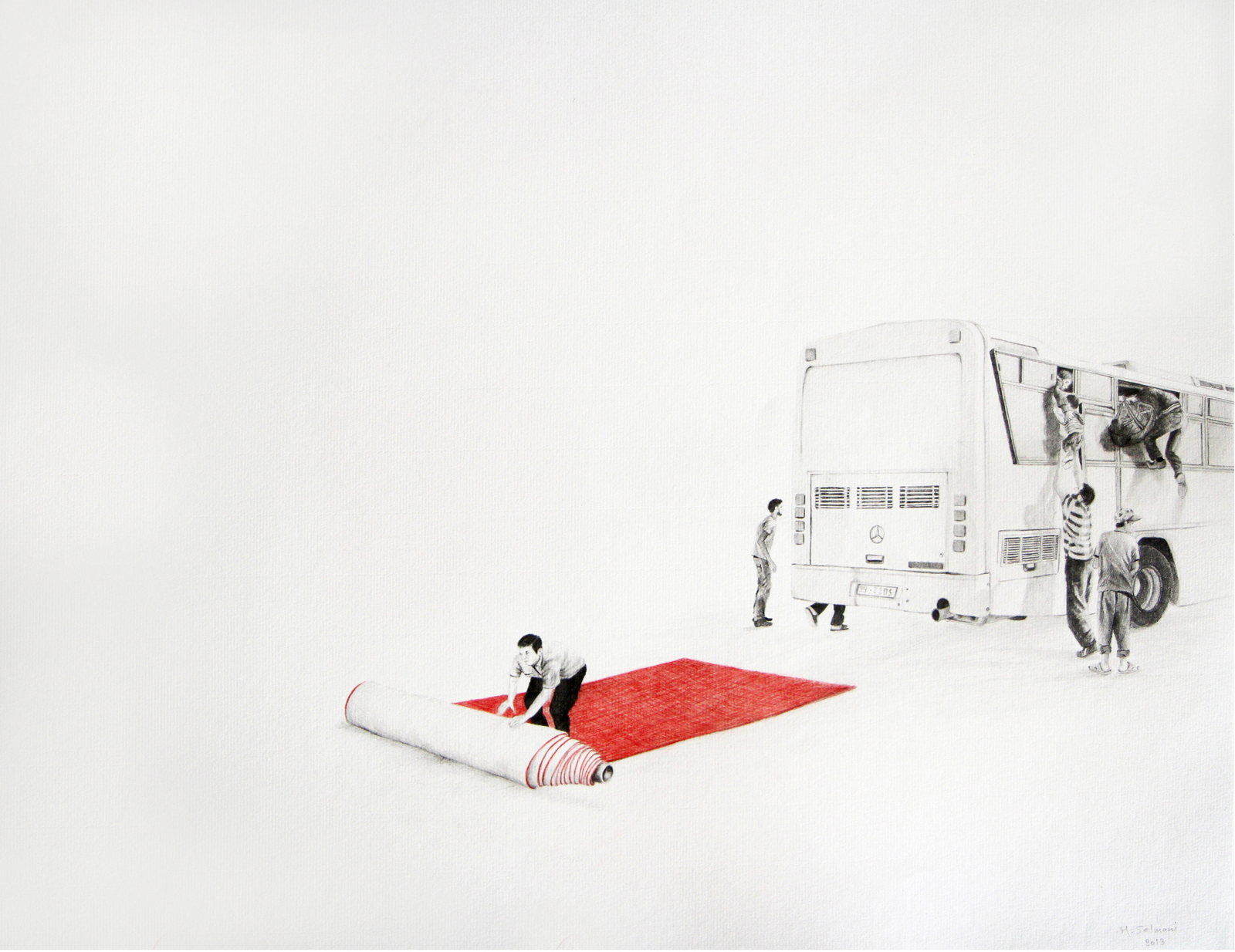
Graphite on paper
15,7 x 19,6 inches
Collection Musée National d'Art Moderne- Centre Pompidou
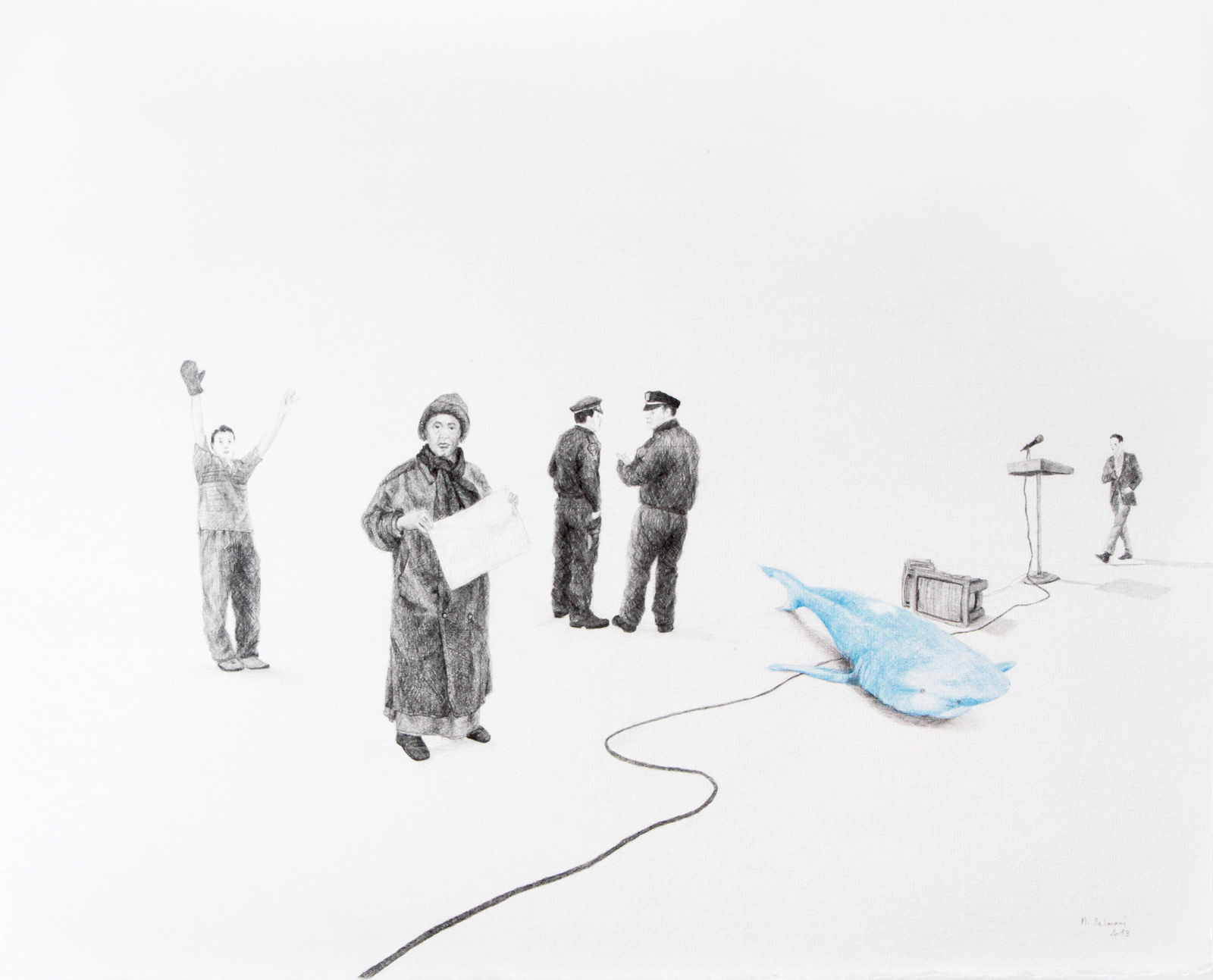
Graphite on paper
15,7 x 19,6 inches
Collection Musée National d'Art Moderne- Centre Pompidou
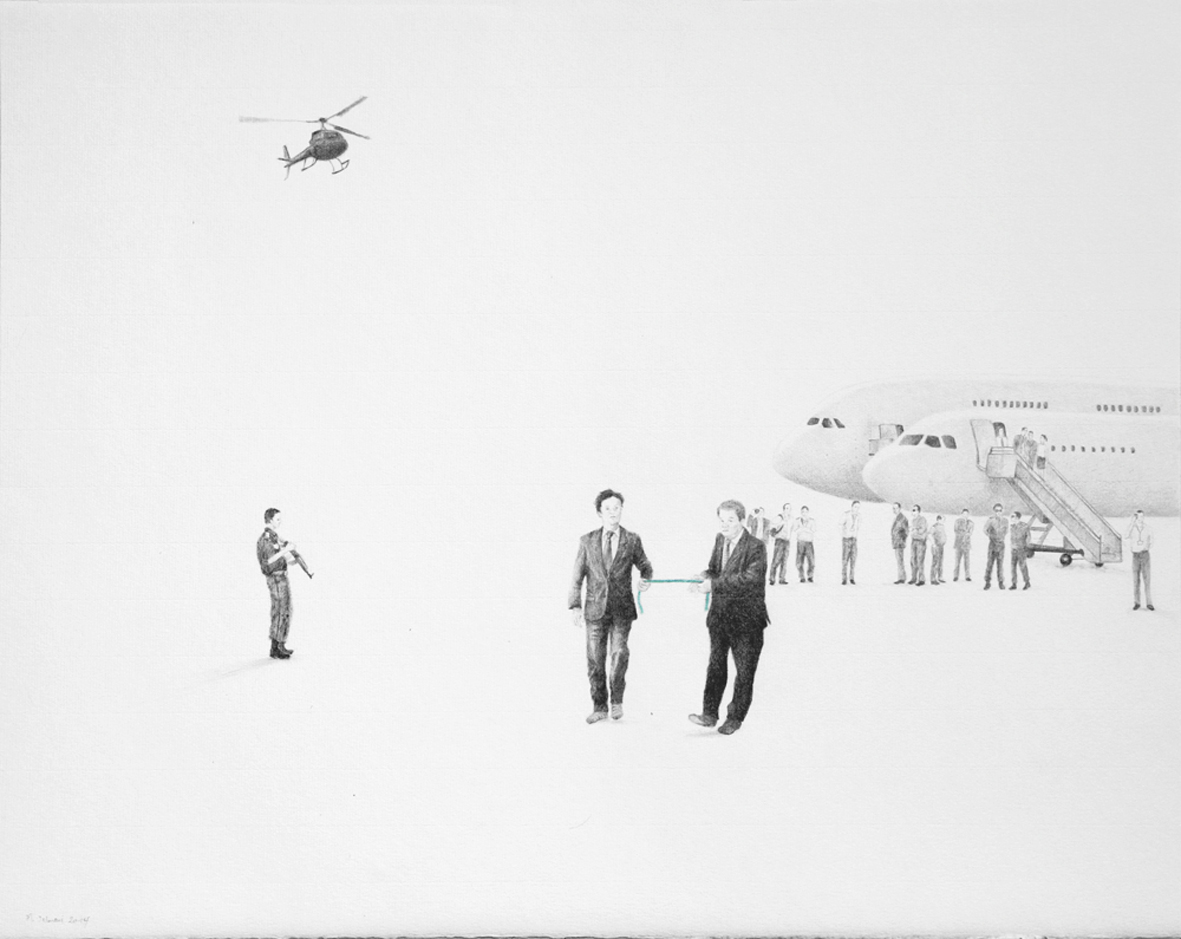
Graphite on paper
15,7 x 19,6 inches
Collection Musée National d'Art Moderne- Centre Pompidou
Collection Musée National d'Art Moderne- Centre Pompidou

19,6 x 23,6 inches each
Collection Samdani Art Foundation, Bangladesh.
D'un accident on a trois points de vue et trois moments différents. Un oeil cinématographique guette, à travers la technique du champ-contrechamp, les effets dévastateurs sur l'automobile choquée. Des spectateurs (témoins oculaires ?) dialoguent devant la scène. Un bleu en guise de fumée montante ou flaque bleue gisant après l'extinction de l'incendie. Un trait rouge et bleu traverse la carcasse à l'envers puis à l'endroit. Dans tous ces éléments constitutifs d'un accident, à la fois banal et surréaliste, il y a comme une mise en oeuvre de l'essence du dessin en tant que rythme du visible. Ce que « l'image-temps » du cinéma nous fait voir se contient déjà dans les traits et les ombres colorés d'un dessin. Et la fulgurance de tout accident se marque dans les traits qui restent d'un témoignage poétique.
Arafat Saadallah, 2015.
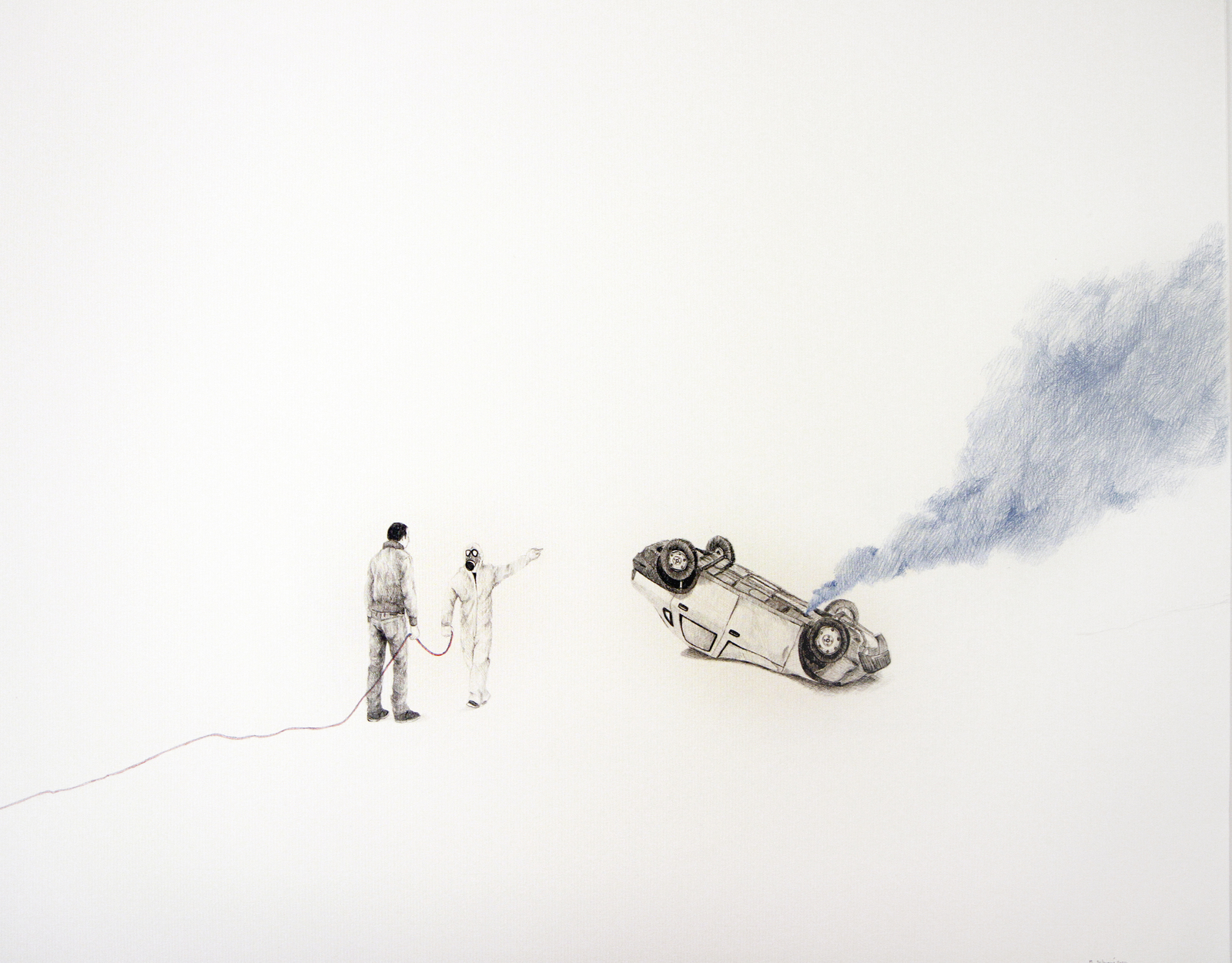
19,6 x 23,6 inches each
Collection Samdani Art Foundation, Bangladesh.
D'un accident on a trois points de vue et trois moments différents. Un oeil cinématographique guette, à travers la technique du champ-contrechamp, les effets dévastateurs sur l'automobile choquée. Des spectateurs (témoins oculaires ?) dialoguent devant la scène. Un bleu en guise de fumée montante ou flaque bleue gisant après l'extinction de l'incendie. Un trait rouge et bleu traverse la carcasse à l'envers puis à l'endroit. Dans tous ces éléments constitutifs d'un accident, à la fois banal et surréaliste, il y a comme une mise en oeuvre de l'essence du dessin en tant que rythme du visible. Ce que « l'image-temps » du cinéma nous fait voir se contient déjà dans les traits et les ombres colorés d'un dessin. Et la fulgurance de tout accident se marque dans les traits qui restent d'un témoignage poétique.
Arafat Saadallah, 2015.
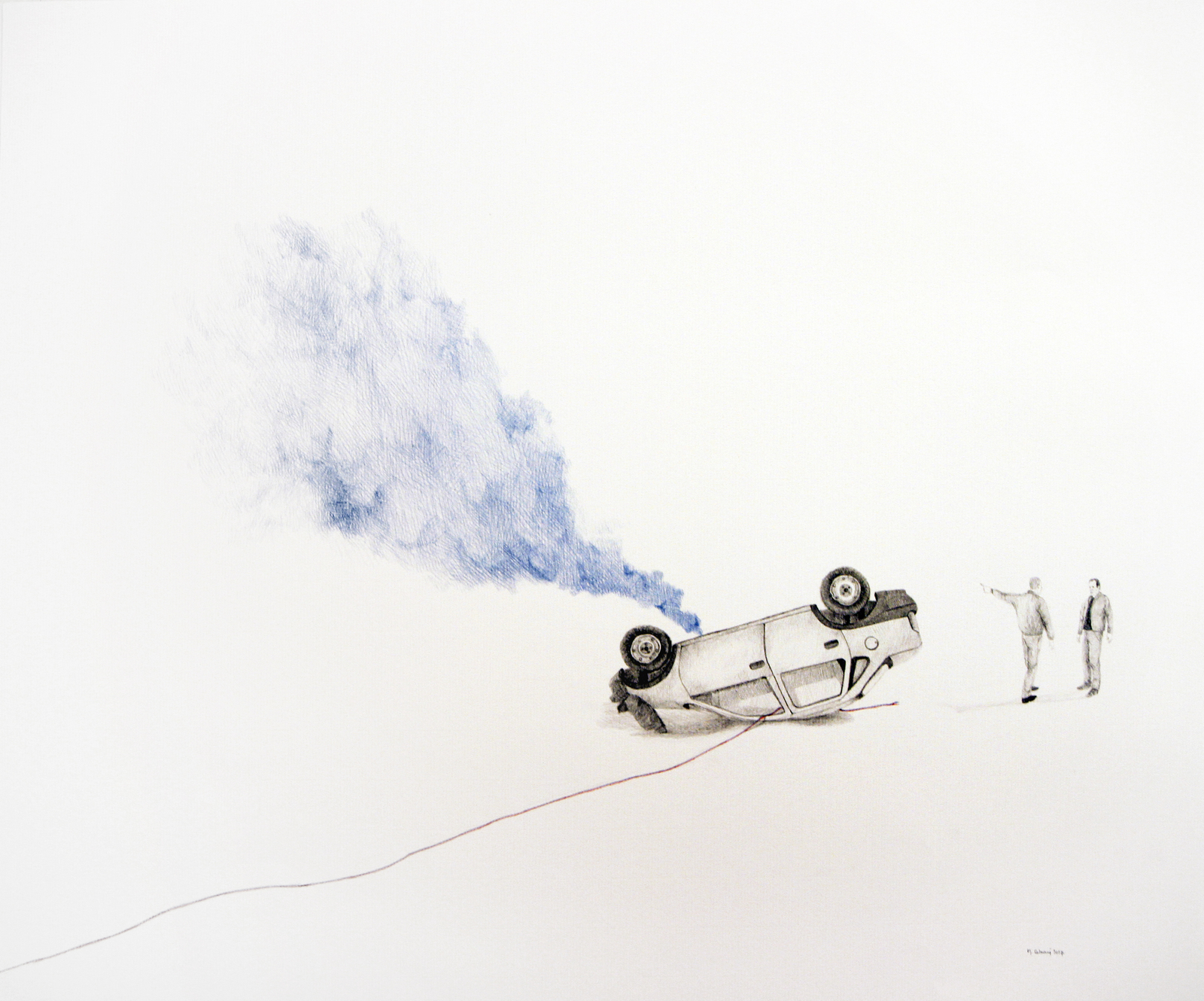
19,6 x 23,6 inches each
Collection Samdani Art Foundation, Bangladesh.
D'un accident on a trois points de vue et trois moments différents. Un oeil cinématographique guette, à travers la technique du champ-contrechamp, les effets dévastateurs sur l'automobile choquée. Des spectateurs (témoins oculaires ?) dialoguent devant la scène. Un bleu en guise de fumée montante ou flaque bleue gisant après l'extinction de l'incendie. Un trait rouge et bleu traverse la carcasse à l'envers puis à l'endroit. Dans tous ces éléments constitutifs d'un accident, à la fois banal et surréaliste, il y a comme une mise en oeuvre de l'essence du dessin en tant que rythme du visible. Ce que « l'image-temps » du cinéma nous fait voir se contient déjà dans les traits et les ombres colorés d'un dessin. Et la fulgurance de tout accident se marque dans les traits qui restent d'un témoignage poétique.
Arafat Saadallah, 2015.
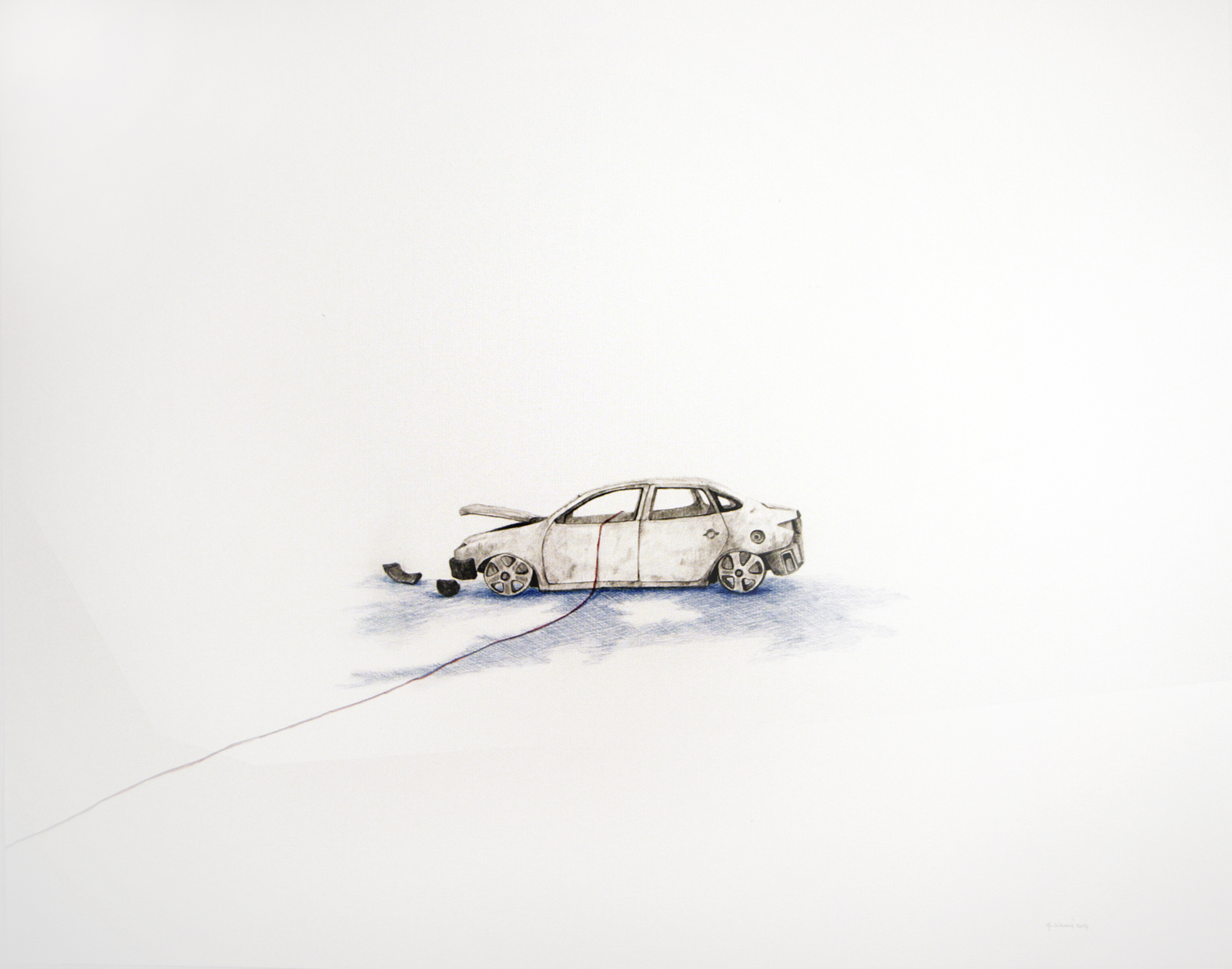
19,6 x 23,6 inches each
Collection Samdani Art Foundation, Bangladesh.
D'un accident on a trois points de vue et trois moments différents. Un oeil cinématographique guette, à travers la technique du champ-contrechamp, les effets dévastateurs sur l'automobile choquée. Des spectateurs (témoins oculaires ?) dialoguent devant la scène. Un bleu en guise de fumée montante ou flaque bleue gisant après l'extinction de l'incendie. Un trait rouge et bleu traverse la carcasse à l'envers puis à l'endroit. Dans tous ces éléments constitutifs d'un accident, à la fois banal et surréaliste, il y a comme une mise en oeuvre de l'essence du dessin en tant que rythme du visible. Ce que « l'image-temps » du cinéma nous fait voir se contient déjà dans les traits et les ombres colorés d'un dessin. Et la fulgurance de tout accident se marque dans les traits qui restent d'un témoignage poétique.
Arafat Saadallah, 2015.
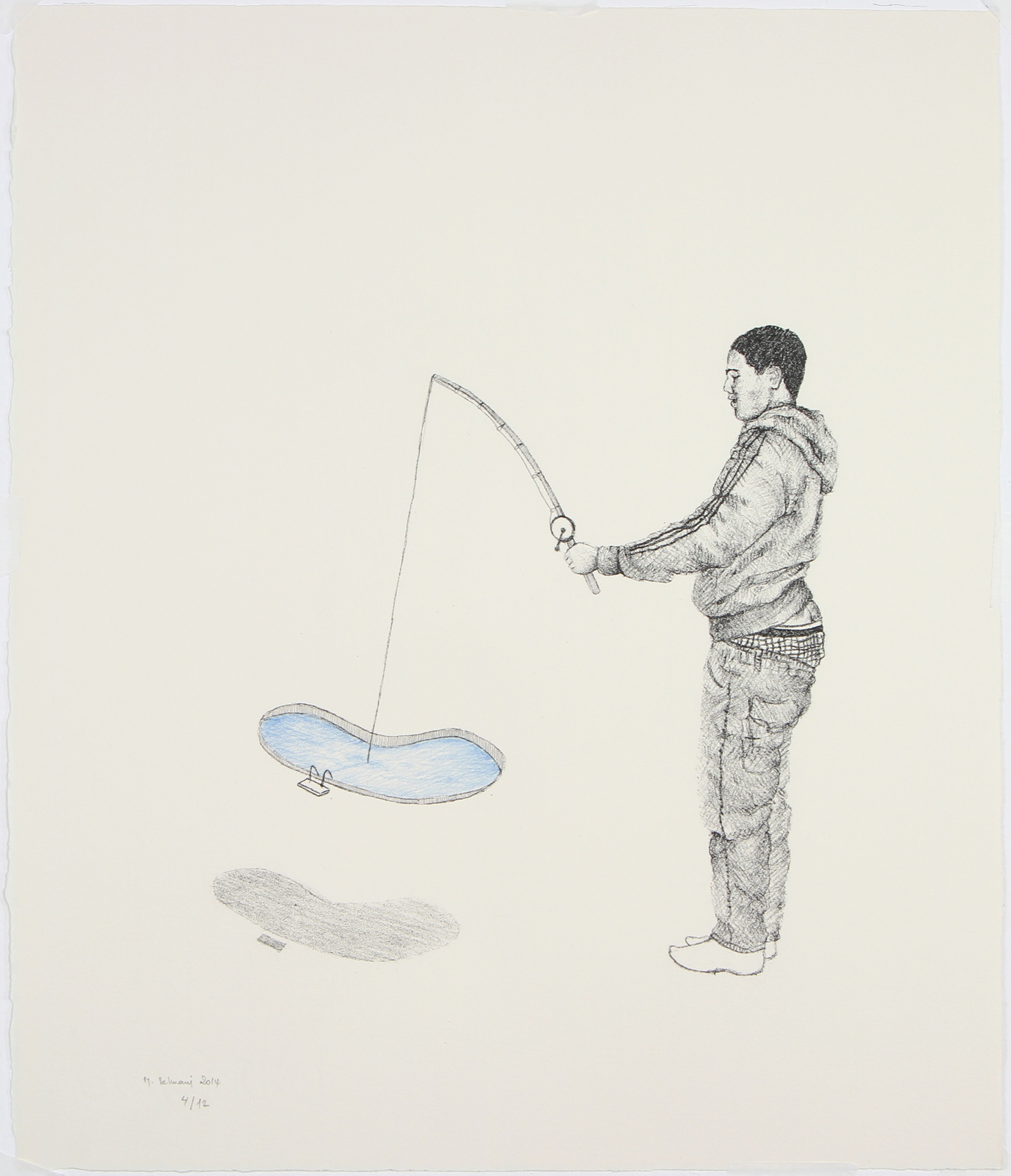
15 x 12,5 inches
Exhibition :
- Épisodes, EESAB-site de Lorient, France, 2018
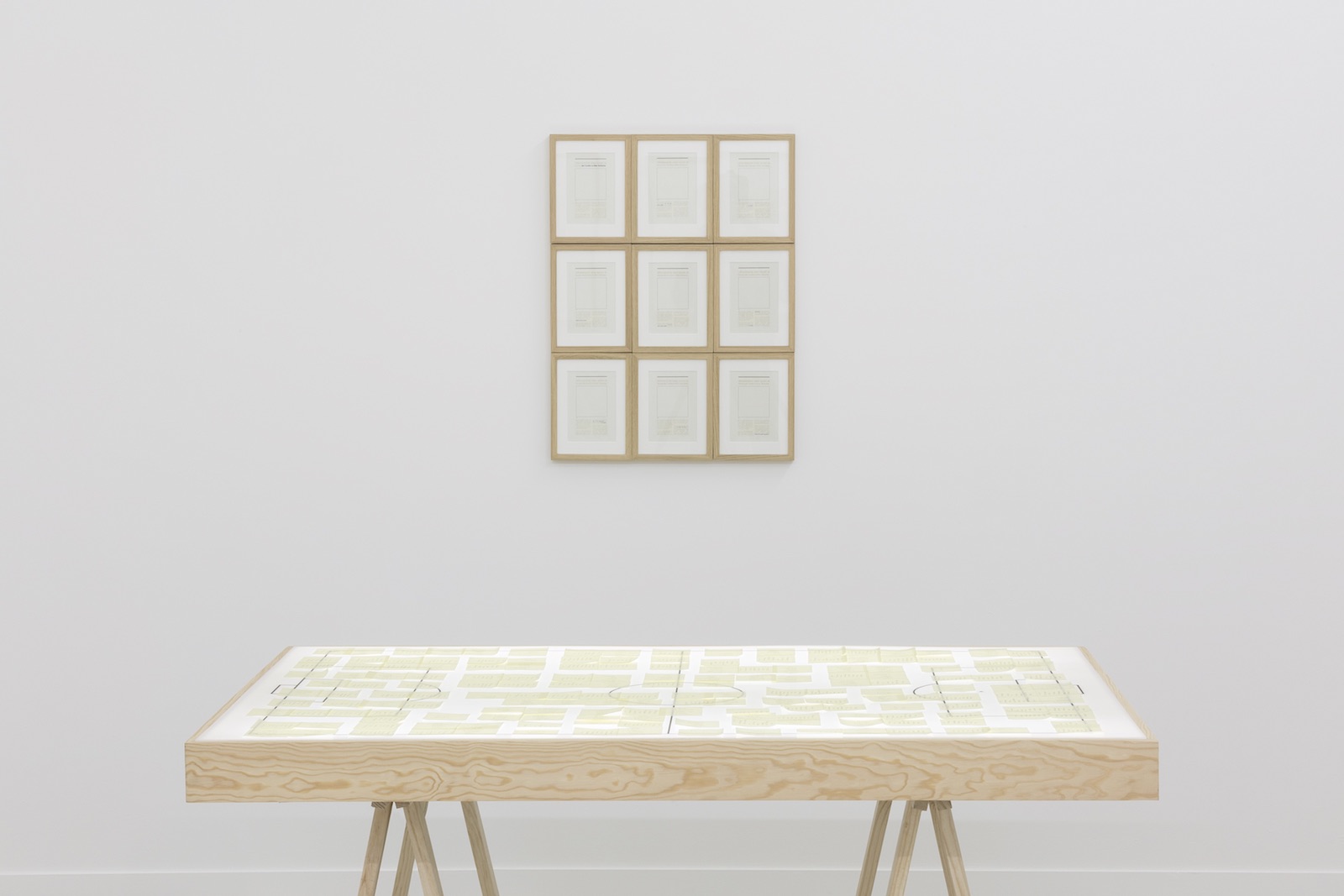
Table : 57,5 x 86,6 inch, press cutting : 6,7 x 8,6 inch (each)
© Yoann Gozard
Commissioned for the Mosaic Rooms/AM. Quattan Foundation by aria (artist residency in Algiers), 2013-2014.
Supported by Arts Council England.
Exhibition :
- No Looking Back, Okay? curator Simona Vidmar, Maribor Art Gallery, Slovenia, 2018-2019
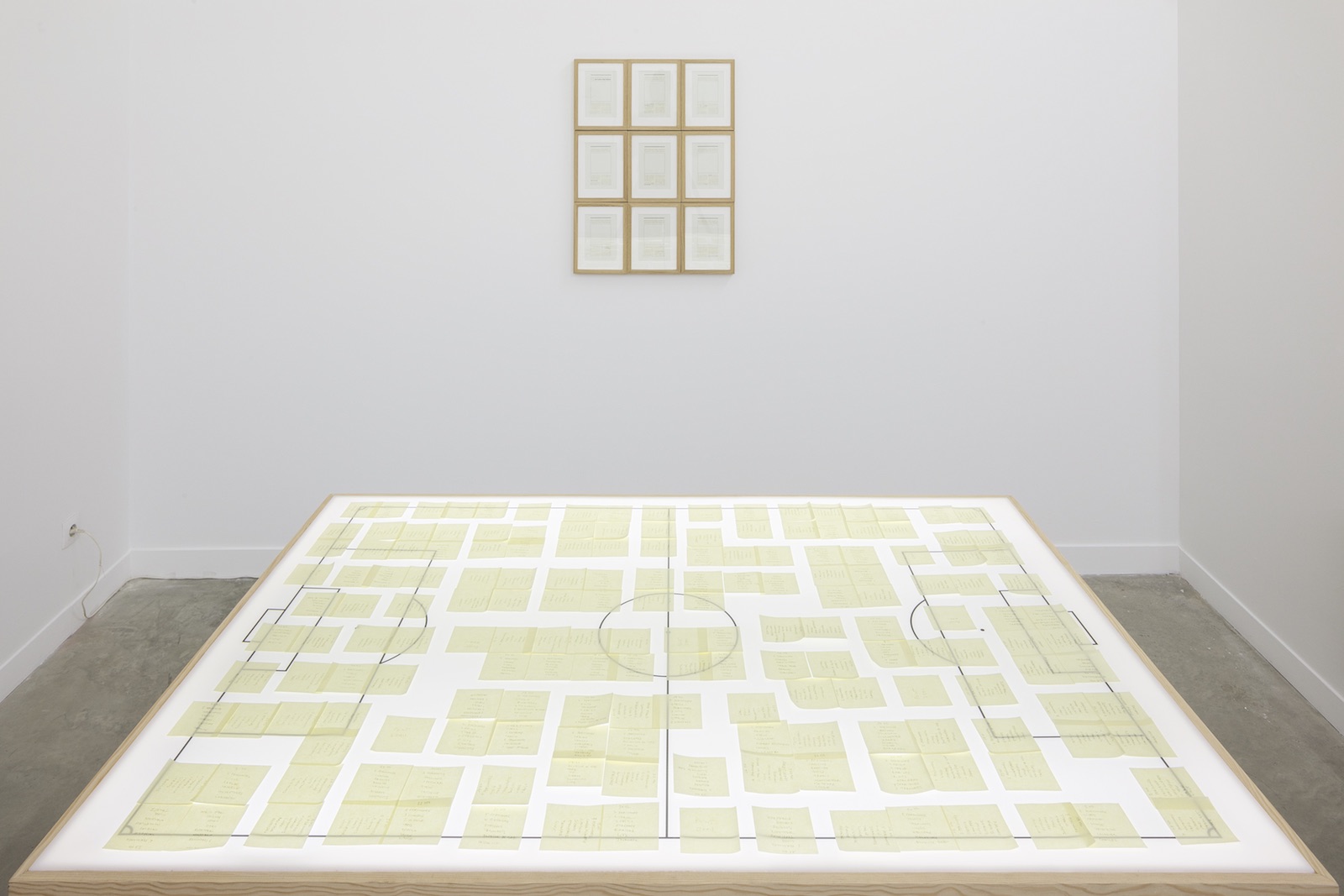
Table : 57,5 x 86,6 inch, press cutting : 6,7 x 8,6 inch (each)
© Yoann Gozard
Commissioned for the Mosaic Rooms/AM. Quattan Foundation by aria (artist residency in Algiers), 2013-2014.
Supported by Arts Council England.
Exhibition :
- No Looking Back, Okay? curator Simona Vidmar, Maribor Art Gallery, Slovenia, 2018-2019
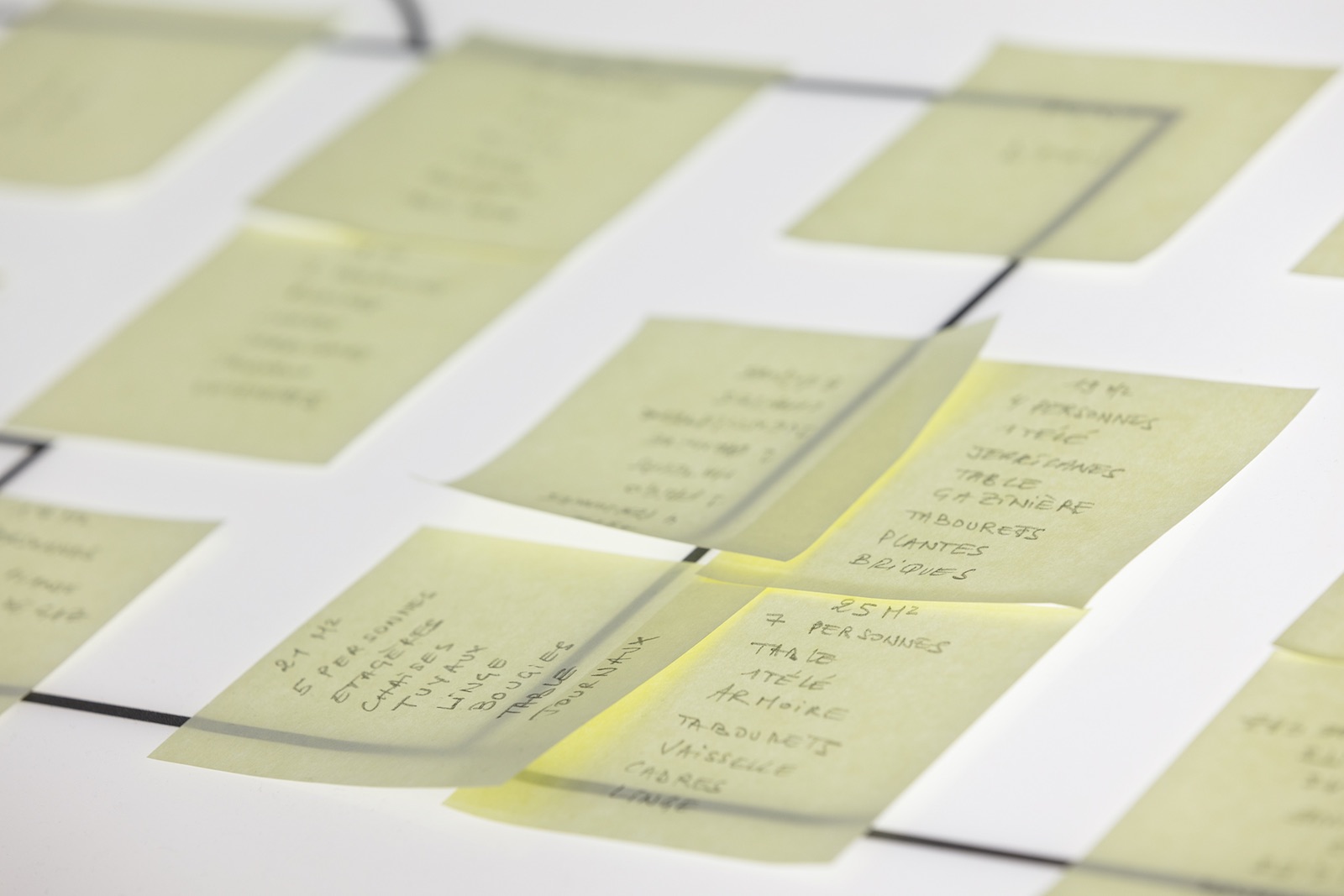
Table : 57,5 x 86,6 inch, press cutting : 6,7 x 8,6 inch (each)
© Yoann Gozard
Commissioned for the Mosaic Rooms/AM. Quattan Foundation by aria (artist residency in Algiers), 2013-2014.
Supported by Arts Council England.
Exhibition :
- No Looking Back, Okay? curator Simona Vidmar, Maribor Art Gallery, Slovenia, 2018-2019
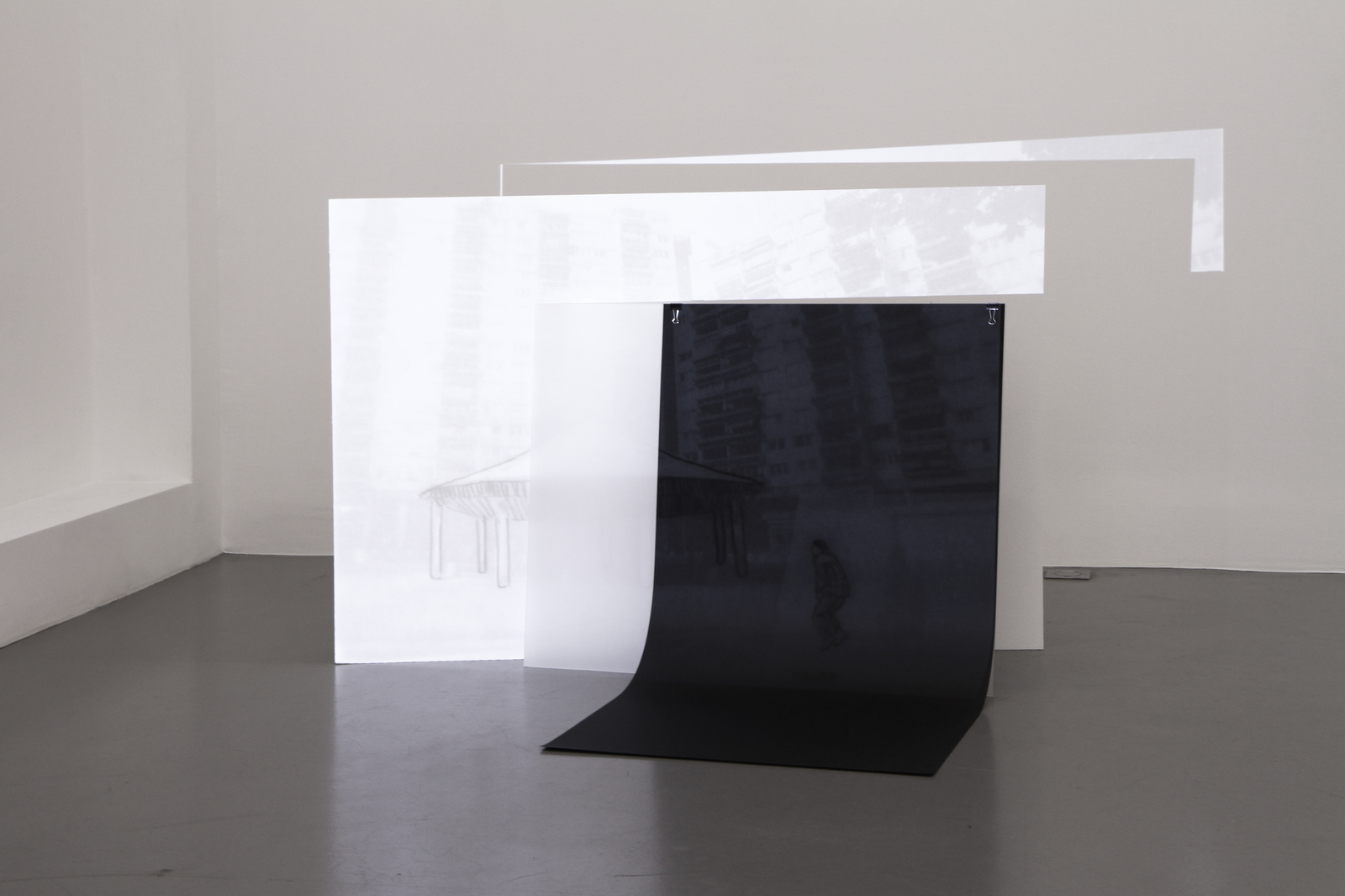
Various sizes
With the support of DRAC Centre
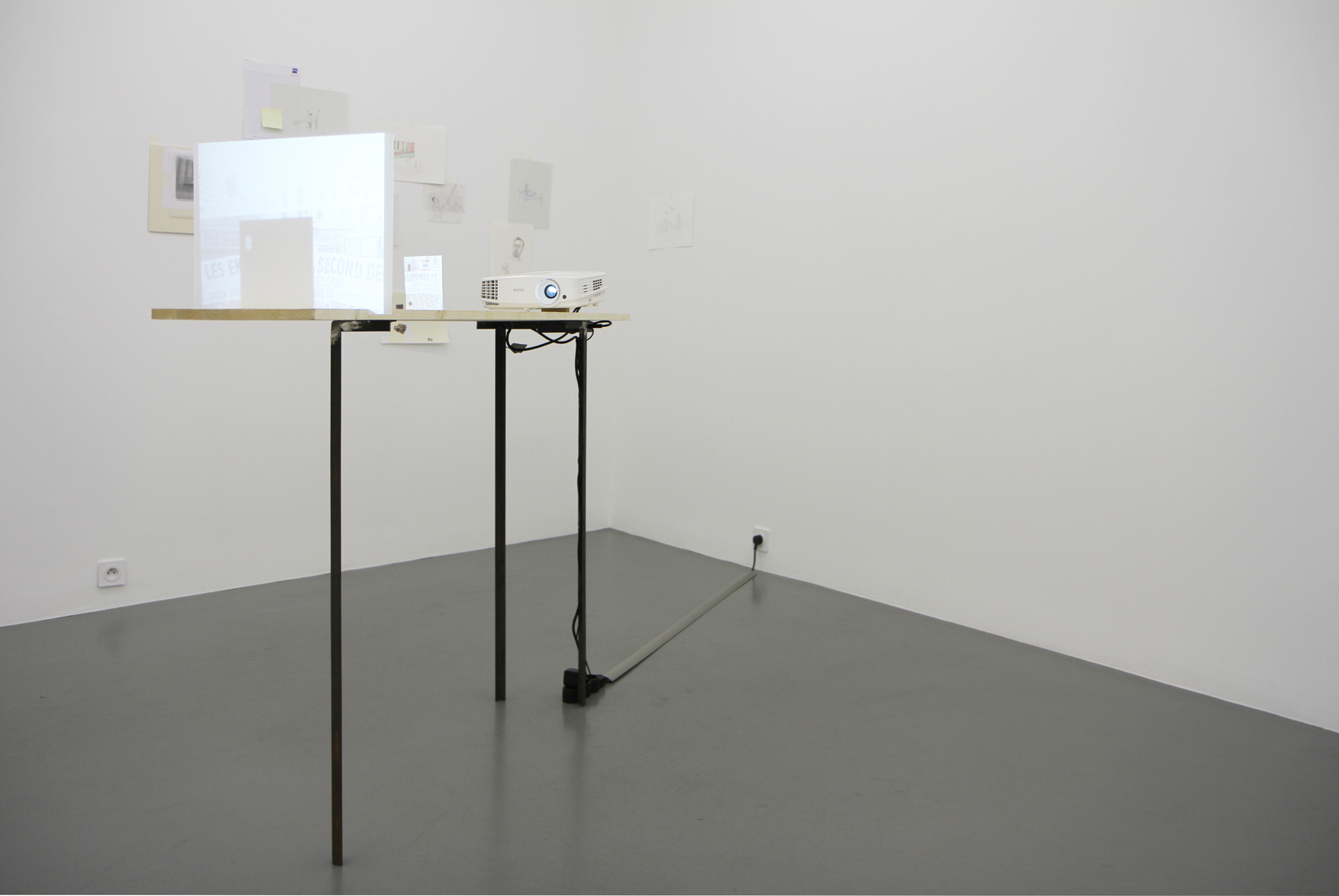
Various dimensions
With the support of DRAC Centre
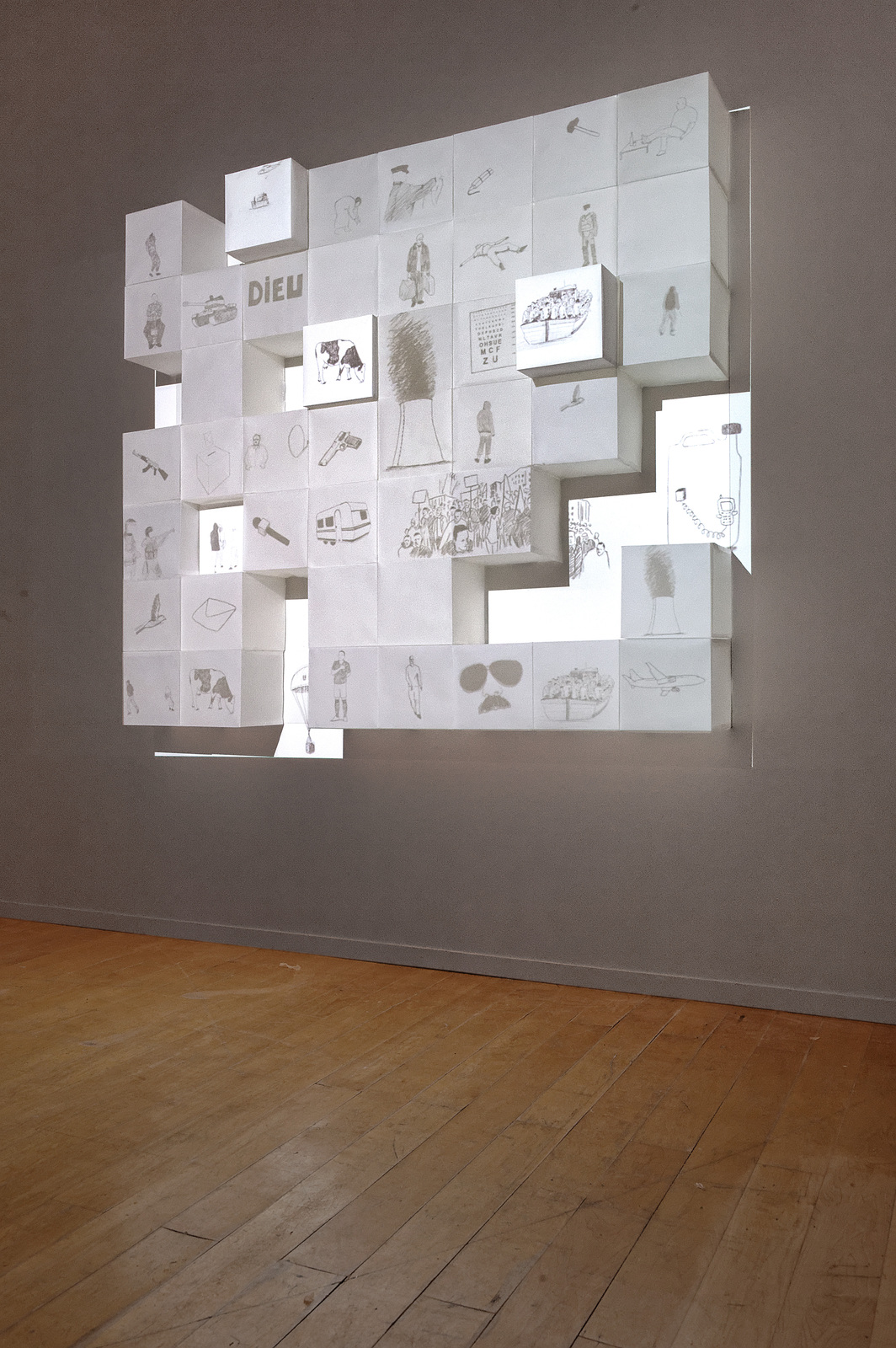
Variable dimensions
© Blaise Adilon, Biennale de Venise, 2015
Musée d'art contemporain de Lyon
.
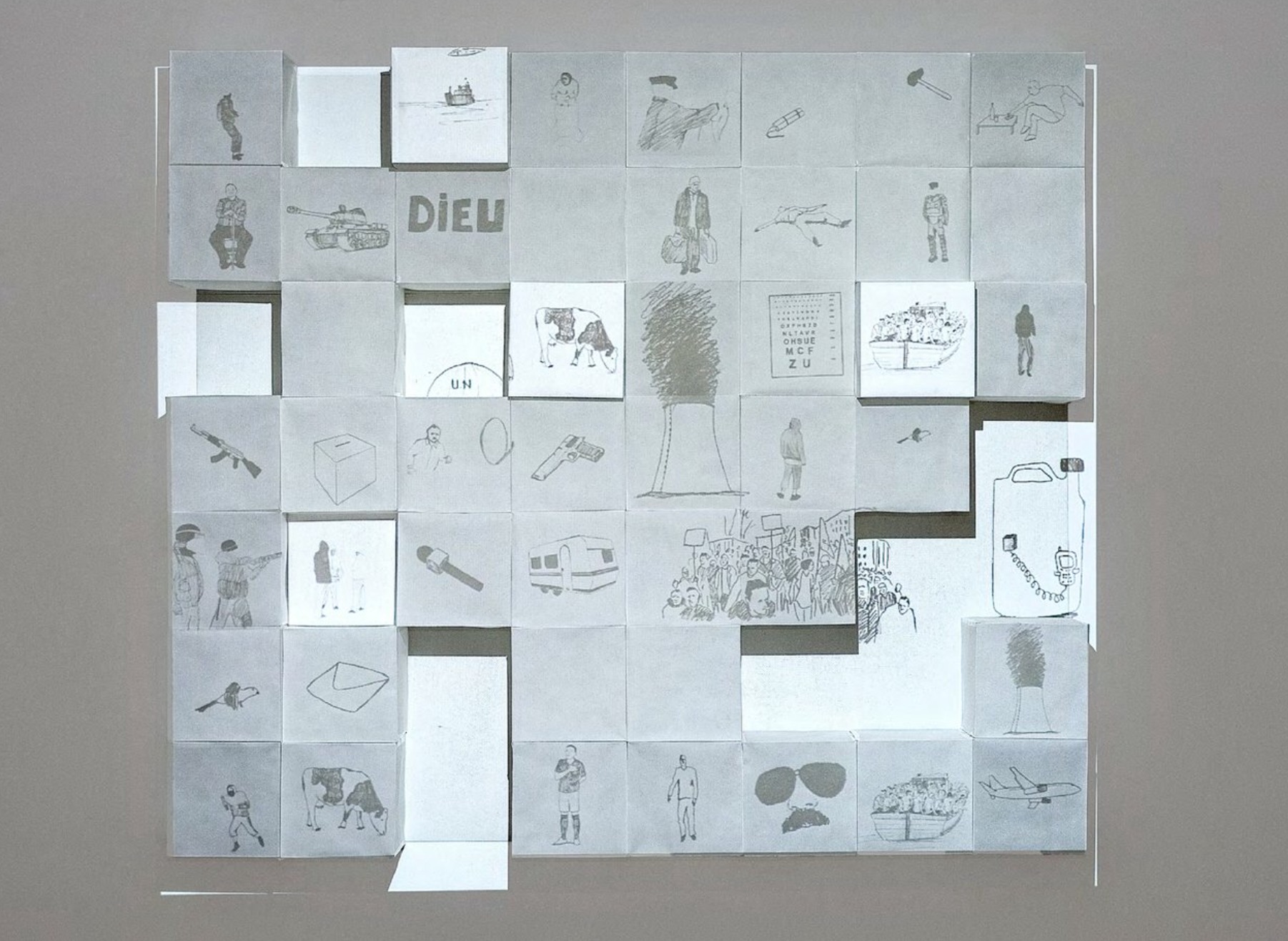
Variable dimensions
© Blaise Adilon, Biennale de Venise, 2015
Musée d'art contemporain de Lyon
.
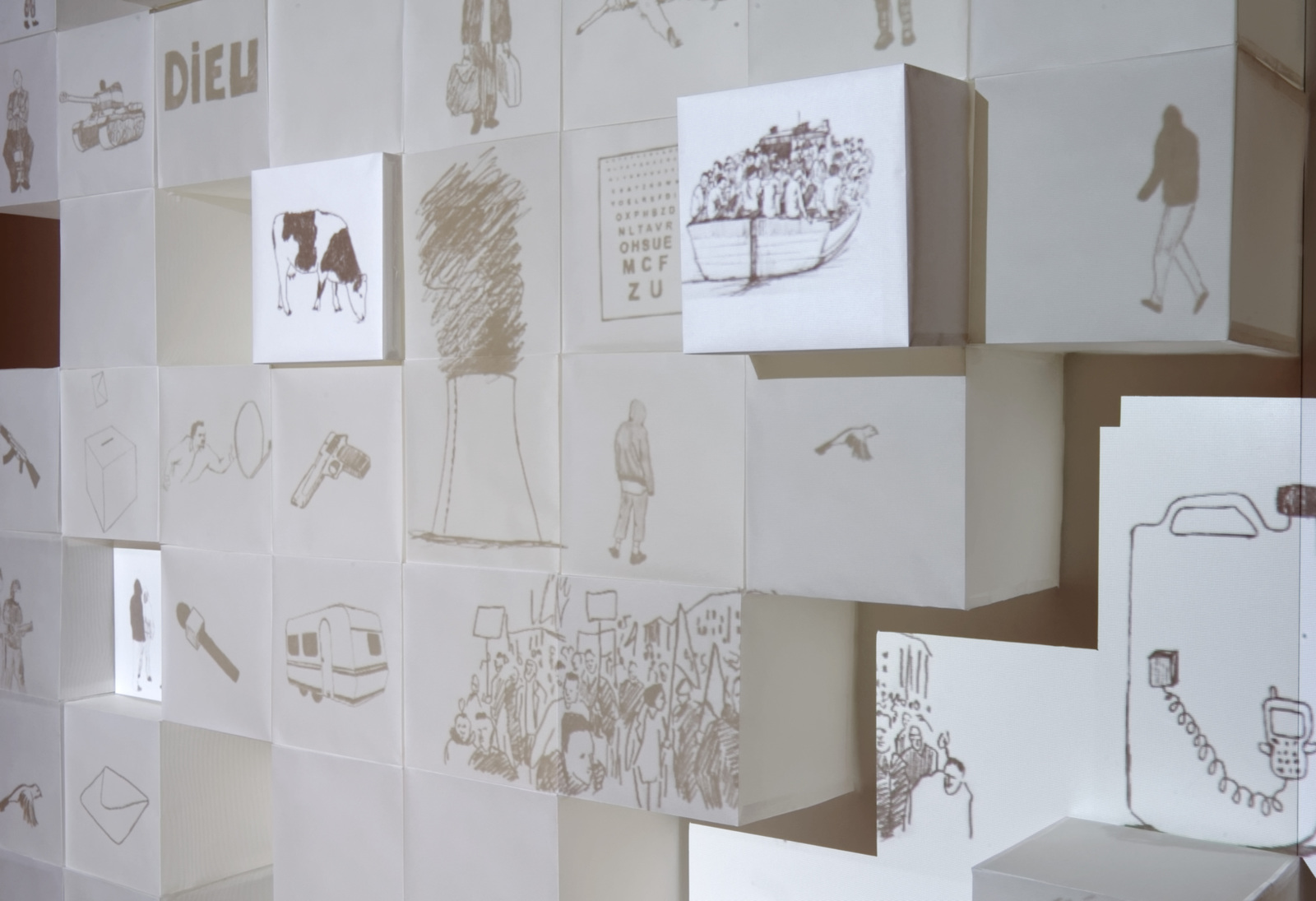
Variable dimensions
© Blaise Adilon, Biennale de Venise, 2015
Musée d'art contemporain de Lyon
.
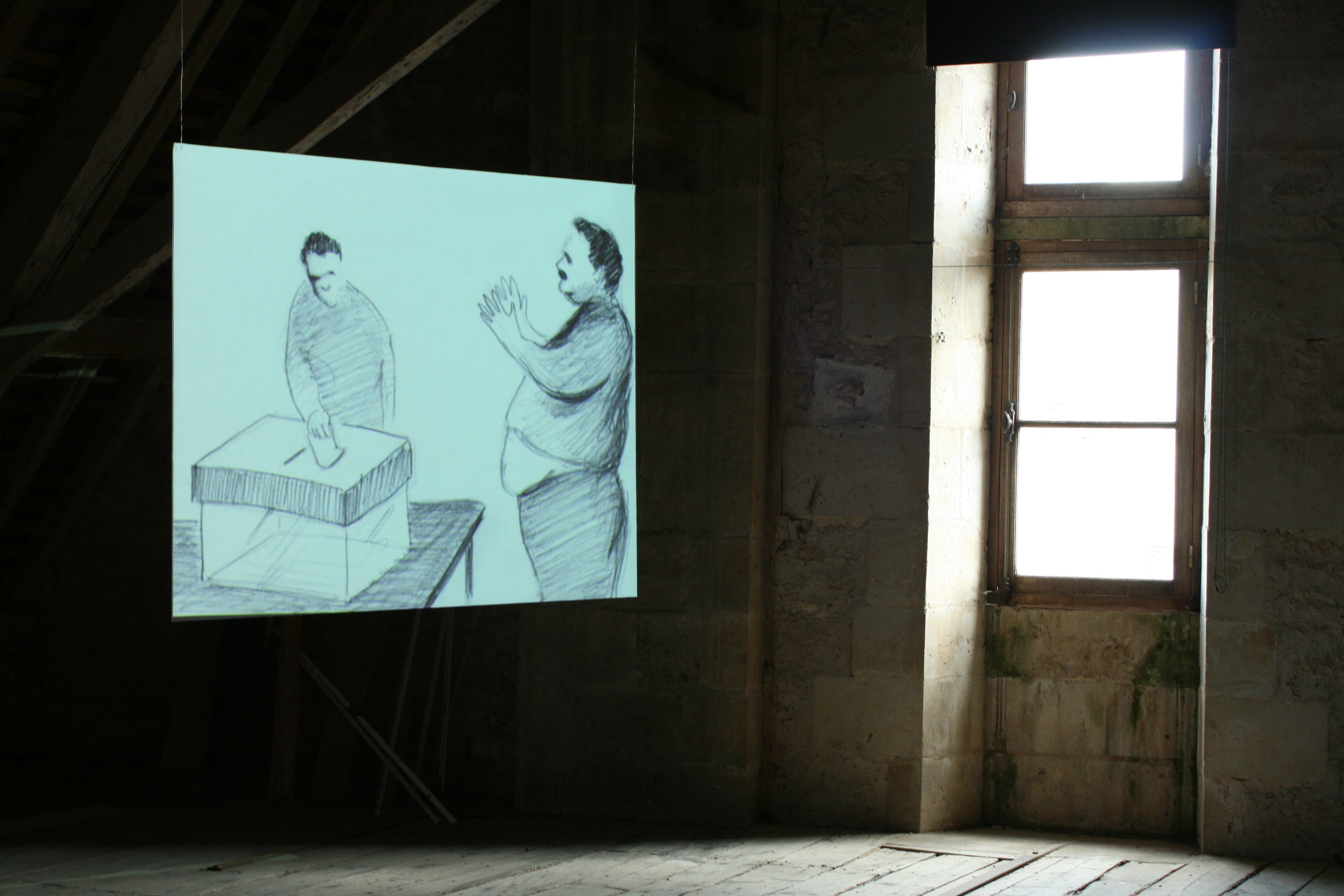
video: 1'15'' on a loop/ envelope: 53,15 x 39,8 in
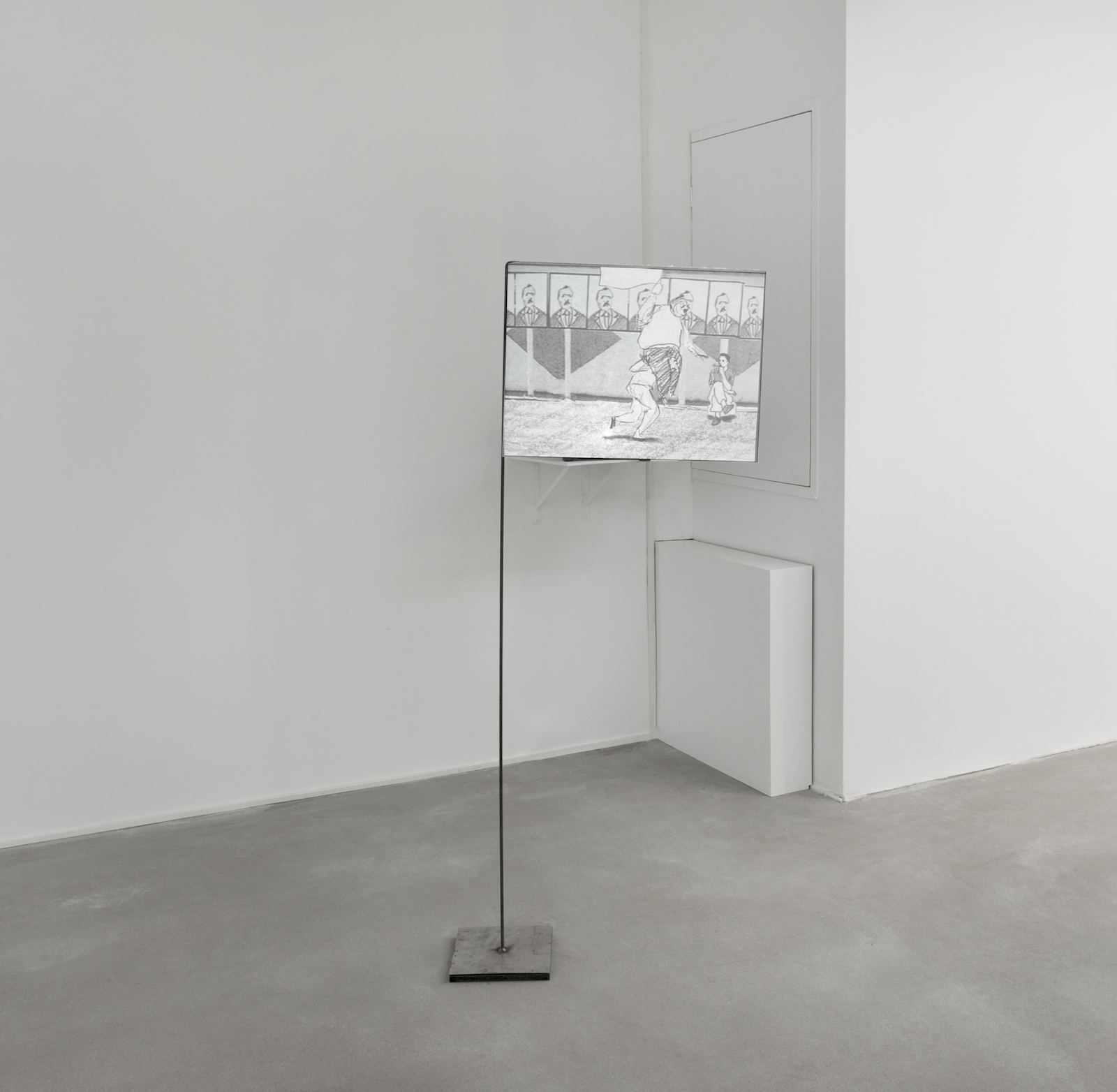
Format 4:3, 16 sec, on a loop, sheet of paper: 25 x 18,9 cm
© Noortje Knulst
Massinissa Selmani was born in 1980 in Alger (Algeria). He lives and works in Tours.
His works have their origins in political and social news, taken from press clippings he has been collecting for many years. By confronting and juxtaposing these real elements without logical coherence, he creates enigmatic, ambiguous scenes. By its simplicity as a tool, Massinissa Selmani makes drawing a central medium of his practice. His work, in which the gravity of the subjects is carried by humor, the absurd and simplicity of means, often presents drawings that depict strange or absurd situations made of improbable assemblages tinged with a certain gravity. Indeed, Massinissa Selmani experiments with drawing in all its forms: on paper, tracing paper, animation, installations, and more recently on sculptures designed as drawings in space. Through his experimental approach to drawing, Massinissa Selmani plays on the boundary between the real and the unreal, the comic and the tragic, characteristic of his work.
In 2023, Massinssa Selmani has been nominated for the Marcel Duchamp Prize. His work has also been hailed by a special mention of the jury at the 56th Venice Biennale (All the World's Futures, curated by Okwui Enwezor in 2015). He has taken part in numerous solo and group exhibitions in France and abroad. Winner of the Art collector prize and the Sam Prize in 2016, Massinissa Selmani has also been exhibited at the Dakar Biennial in 2014, the first Vendôme Triennial and the Lyon Biennial in 2015, the Orléans Architecture Biennial in 2017 and at the Kochi-Muziris Biennale in India in 2023. His work is now part of important public and private collections, such as the Musée National d'Art Moderne, Centre Pompidou, Musée d'Art Contemporain de Lyon, Frac Centre and the Samdani Art Foundation (Bangladesh).